
FROM A LONG LIST OF CONTENDERS 15 ALL BLACKS ARE SINGLED OUT FOR HOW THEY CHANGED THE GAME
BY JIM KAYES



FROM A LONG LIST OF CONTENDERS 15 ALL BLACKS ARE SINGLED OUT FOR HOW THEY CHANGED THE GAME
BY JIM KAYES

UNLIMITED SOPHISTICATION. BENCHMARK LUXURY. UNRIVALLED CAPABILITY. The RAM 1500 Limited is New Zealand’s most luxurious full-size pickup truck.


Maximise your slice of the Pie Founder and CIO, Mike Taylor, shares the history behind the Pie Funds name and why it transcends mere corporate identity.
When I first started Pie Funds in 2007, I received plenty of jokes and some genuine confusion, “What do you mean, you don’t sell mince and cheese!”. But 17 years on, “Pie” has grown to over $2.1 billion* in funds under management from everyday Kiwis just like you, and the name “Pie Funds” carries much greater awareness, not just because of our name!
The history of the name
Behind every good name is a story; here’s the story of how Pie Funds got its name.
Back in 2007, well before the iPhone became mainstream, when I was dreaming of being an investment manager, I thought a good name for my business would be ANZAC Funds. A strong name that showed we were focused on Australian and New Zealand investments. But when I heard about the new tax regime, called PIE, or Portfolio Investment Entity, I thought that would be a clever and catchy name with the added bonus of anyone googling “pie fund” seeing my business pop up at the top of the results. I couldn’t believe my luck when I checked the Companies Office!
I registered the name right there and then on the 9th of July 2007.
Fast forward to today, and we’ve made our “Pie Funds” investors around $800m* in wealth, so thank you to all our loyal supporters. So why am I writing about the name now?
Following the trust tax rate increase on 1 April 2024, investors, advisers and accountants are becoming increasingly interested in PIEs.
What is a PIE (Portfolio Investment Entity)?
A PIE is a pooled investment vehicle such as a managed fund, that meets specific criteria set by the Inland Revenue. PIEs generally offer exposure to various asset classes, such as cash, fixed income, or shares, with some holding a mix of these assets. PIEs can provide diversification through the assets they hold, providing benefits that help to manage risk whilst also enhancing returns, and through effective portfolio implementation and rebalancing. KiwiSaver Funds are usually PIEs for this reason.
An important feature of PIE funds is their intended tax advantage vs individual and trust tax rates Investment income in PIE funds is taxed at a maximum rate of 28%, compared to the top personal tax rate of 39% for individuals earning over $180,000 per year. Starting 1 April
2024, trusts earning net income above $10,000 annually will also be taxed at 39%, an increase from the previous 33% rate, and significantly higher than the PIE funds maximum rate of 28%.
By strategically assessing your portfolio and reallocating some investment assets into funds with a PIE structure, you may benefit from the capped top tax rate of 28%. This, combined with the diversification benefits which most PIE funds typically provide, can be a compelling strategy navigating today’s investment landscape. Of course, the tax efficient nature of an investment isn’t the only consideration when constructing your portfolio.
We’d love to talk further with you about your financial goals and objectives.
Pie Funds offers a diverse range of products to suit every investor’s needs. Our product suite covers Australasian equities, global equities, property & infrastructure and fixed income (cash and bonds) and also KiwiSaver.
Get in touch today to discuss your portfolio and how we can become your trusted PIE fund manager.




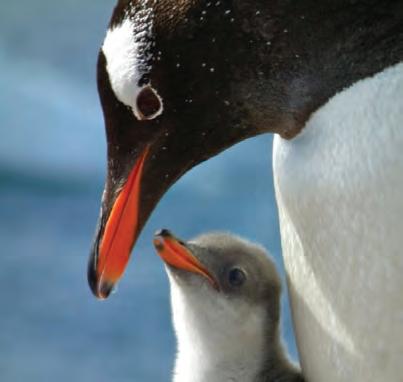

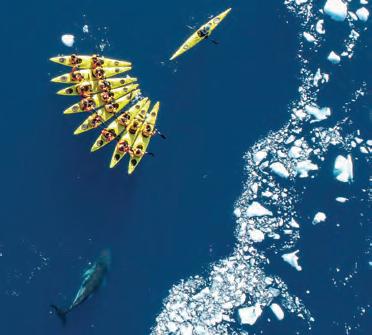





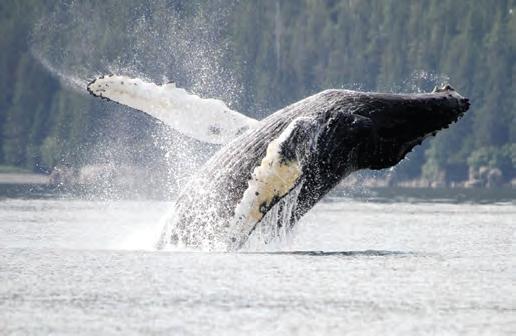








For over 28 years Cruise World have been curating amazing contemporary, luxury, expedition and boutique small ship experiences to exotic destinations around the globe. Let us chart a course to your next travel adventure. With our experienced team, you’re in safe hands.
We enjoy promoting our wonderful products but more importantly we love finding you the experience that suits you best. Our personal touch ensures we deliver on our motto ‘right guest, right voyage’.
Cruise World travels the world in search of the best products available and our team are here to help navigate a world of experiences. Let our passion fuel your excitement.
You deserve to enjoy your entire travel experience, right from the booking and planning through to your departure date. Travel is one of life’s great adventures and we believe the lead up to and anticipation of your holiday should almost be as much fun as the holiday itself.
We sell travel all over the world but we are proudly a New Zealand owned and operated family business. We support and work closely with our New Zealand based travel agent partners.
It’s a fact. The straighter your drives, the longer your drives.
The G430 MAX 10K’s record-setting MOI puts you in the fairway and closer to the green.

Carbonfly Wrap crown saves weight to help lower CG and reduce spin.

Combined MOI exceeds 10,000 g cm 2





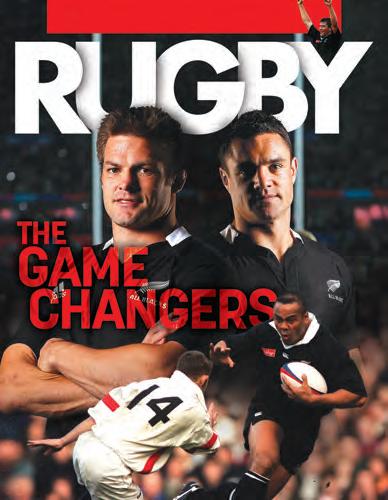









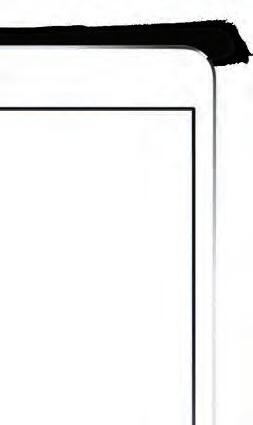



Perched above Queenstown with sweeping views of Lake Whakatipu and the surrounding mountains, Hulbert House is more than just a place to stay—it’s an experience steeped in elegance and history. A beautifully restored 1888 Victorian villa, this boutique hotel offers an intimate and tranquil escape, where each of the six individually styled suites and one Queen studio, invites guests into a world of timeless charm.
The warmth of the team, combined with thoughtful touches such as nightly turn-down service, indulgent breakfasts, Bath Butler experience, and curated local recommendations, creates a stay that feels personal and utterly luxurious. Whether you’re nestled by the fireplace in the inviting Palm Lounge or relaxing on the veranda taking in the memorable landscape, Hulbert House offers an oasis of calm just moments from the vibrant heart of Queenstown.
Perfect for romantic getaways or those seeking a retreat from the everyday, Hulbert House seamlessly blends sophistication with heartfelt hospitality, making it one of the most dreamy places to stay in New Zealand. Here, every detail is designed to make you feel at home, while the setting ensures you never want to leave.
hulberthouse.co.nz
Ilove the concept of a “game changer”. For so many of us who plodded up and down rugby fields, the sight of someone doing something exceptional was a sight to behold.
It still is.
There have been many magnificent All Blacks over the years, but even some of the best did not have a transformative impact on the game: they were simply brilliant in their position. That is not a knock on them. Those types of players are, in fact, a coach’s dream.
But then there are those whose impact is so profound they change the way the game is played and their influence on how we mere mortals view the game extends beyond the time limits of their careers. That sort of player is very special indeed and they are celebrated here.
I’ve also always loved a list. They are subjective, arbitrary even, so there really is not a right or wrong. You might find players on here that you didn’t particularly rate and that’s fine, but hopefully, after reading, you understand why they were game changers.
After careful thought, I’ve decided to restrict my selections to the modern, post-professional era. That has meant some casualties who I could have easily made a case for, like my wonderful mate Sir John Kirwan. Instead, he has helped me form views on those who stretch across these pages.
Thanks must also go to the three coaching knights, Sirs Wayne Smith, Graham Henry and Steve Hansen, for their time and thoughts, and likewise to my Sky Sport colleagues Mils Muliaina, Jeff Wilson and Justin Marshall. Their contributions along with the great Richie McCaw, Keven Mealamu and Laurie Mains have made this magazine possible.
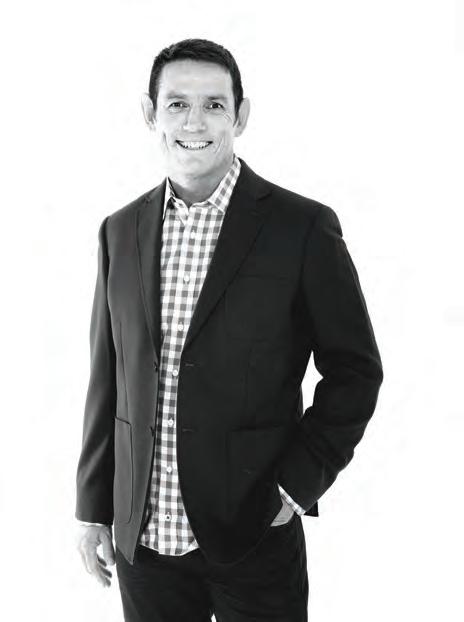
Thanks are also due to Dylan Cleaver for not just editing my work, but elevating it. You are, mate, one of the very best in our business.
And to Don Hope (Publisher), who has the passion and enthusiasm of a man half his age, I salute you!
I am forever thankful to those who have given me the opportunities over the past few decades to write and talk about the great game of rugby, but mostly to my wife, Hiria, and daughters Olivia and Ruth, for tolerating my frequent absences.
Jim Kayes

EDITOR JIM KAYES
CREATIVE DIRECTOR DES FRITH d.DESIGN
SUB EDITOR DYLAN CLEAVER
THANKS TO Sir John Kirwan
Mils Muliaina
Jeff Wilson
Justin Marshall
Richie McCaw
Keven Mealamu
Sir Wayne Smith
Sir Graham Henry
Sir Steve Hansen
Laurie Mains
John Hart
PUBLISHER
DON HOPE don@hopepublishing.co.nz
PHOTOGRAPHY Getty Images
PRINTING SCG
DISTRIBUTION Are Direct NZ
2O

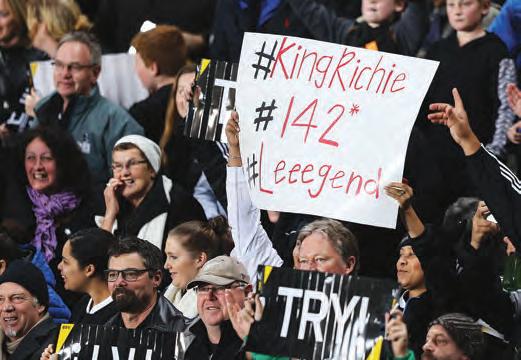
THE GAME CHANGERS

38 58
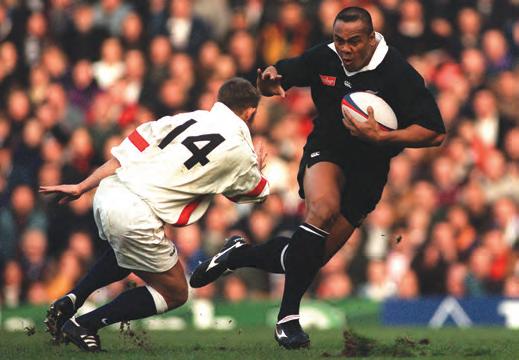

28
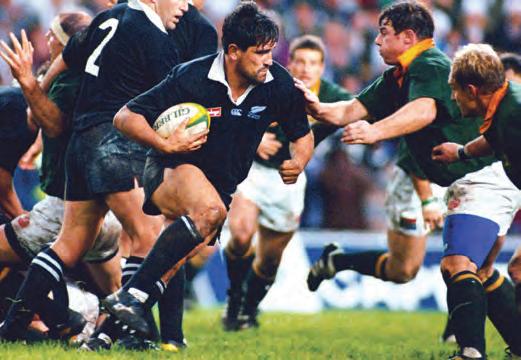
48
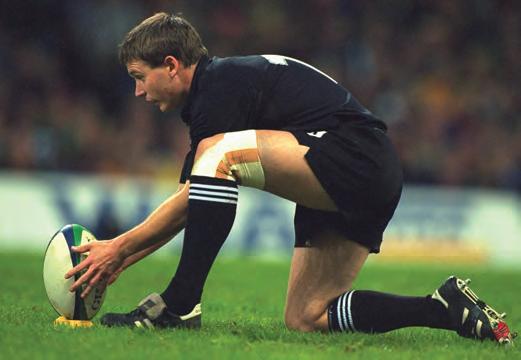
7O



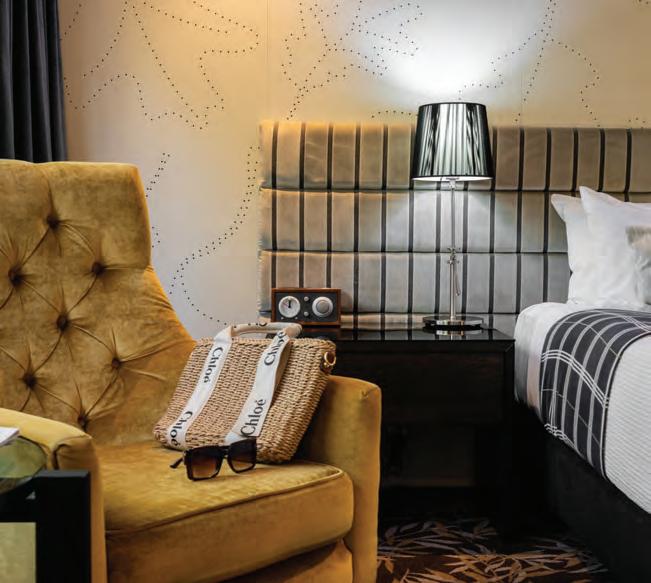
8O


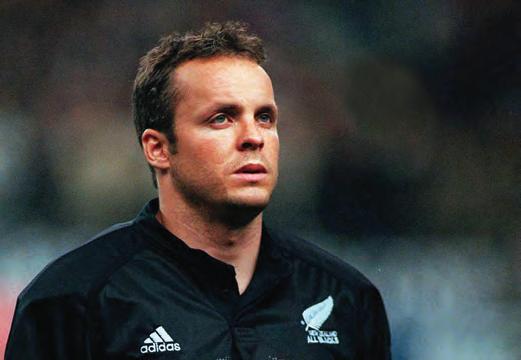
9O
1OO


11O
122

DAN CARTER
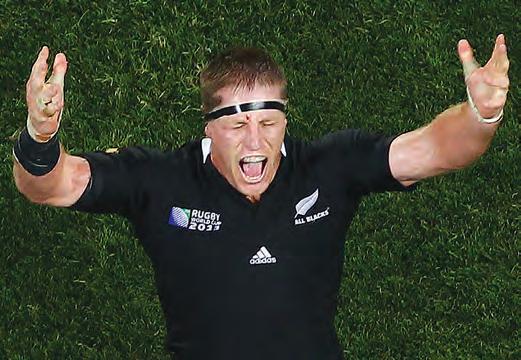
134
BRAD THORN


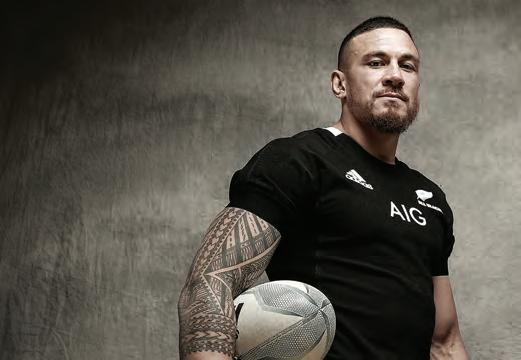


AARON SMITH

COACHES HENRY, SMITH, HANSEN


DANE COLES

BORN TO DARE TUDOR


Introducing five new models to the PLD Milled family, tour-validated designs that can be custom-built for you: the Anser, Anser 2D, DS72, Oslo 3 and Ally Blue 4. The variety ensures a choice to match your stroke and eye, and they are milled to perfection and feature a gunmetal finish. Tour-preferred deep AMP grooves produce a soft feel for precision and control.



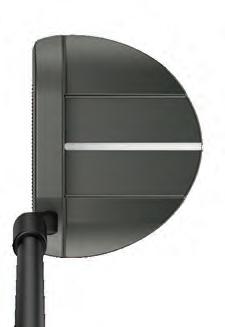

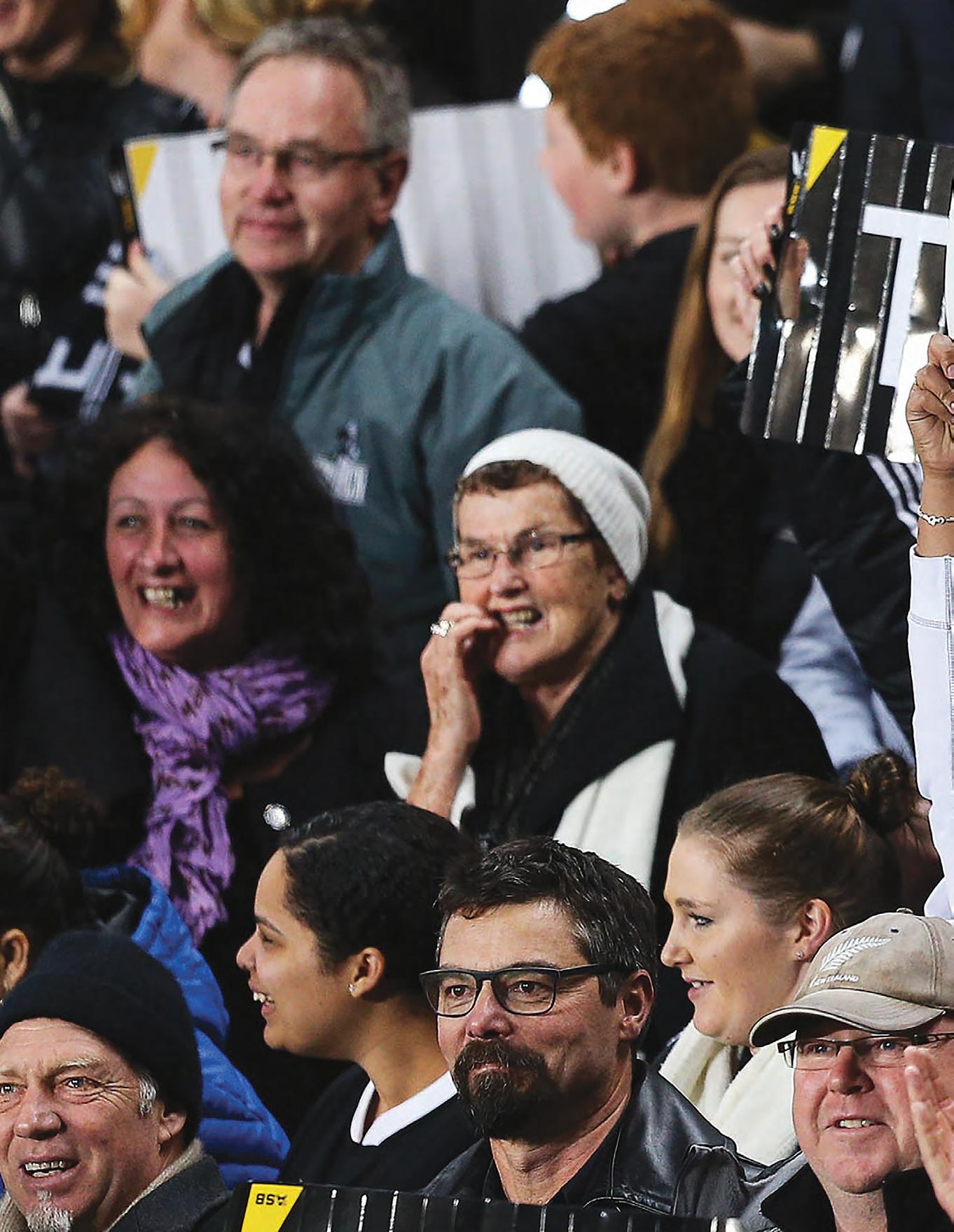
FROM A LONG LIST OF CONTENDERS 15 ALL BLACKS ARE SINGLED OUT FOR HOW THEY CHANGED THE GAME ON THE FIELD, AND OFF IT.

It was an awful Wellington day, with that horizontal rain and a wind that seems like it’s cutting though you like a circular saw.
Yet here was Jonah Lomu sitting in the driver’s seat of his luxury car with all the windows down and the rain pouring in, soaking the leather seats. The flash from the photographer’s camera was competing with the lightning outside as Lomu stared into the car’s rear-view mirror, the No 11 shaved into his left eyebrow the focus for the lens.
When Wellington’s two daily newspapers, the Evening Post and Dominion, merged in July 2002 to create the Dominion Post, we were on the hunt for iconic photos for the first edition. I asked Jonah if he would help and he happily agreed, meeting us on the road that acts as a buffer between the sea and the airport. The photographer, Ross Giblin, was trying to get a shot of Lomu staring into the rear-view mirror with that famous left eyebrow peering back at him, but with the car’s tinted windows, there wasn’t enough light.
“What do you need?” Jonah asked.
“Well, I really need the windows down,” Ross replied as we all looked at rain smashing into the panes.
“Let’s do it,” Jonah said.
It was typical of the man: Lomu was generous to a fault and although he was shy about it, he also was aware of his place in history.
When that photo was taken, Lomu was living with the debilitating illness, nephrotic syndrome, which eventually forced him into a life-saving kidney transplant and all but ended his playing days. Through it all he remained a global phenomenon — and not just in rugby playing countries.
“He is the biggest game changer we’ve had,” says Jeff Wilson, who played alongside Lomu in the All Blacks. “I loved playing with him but he gave me nightmares when I knew I had to play against him.”
His impact at the 1995 Rugby World Cup in South Africa saw him catapulted into a stardom he was nowhere near ready for, yet he coped with it as well as he could.
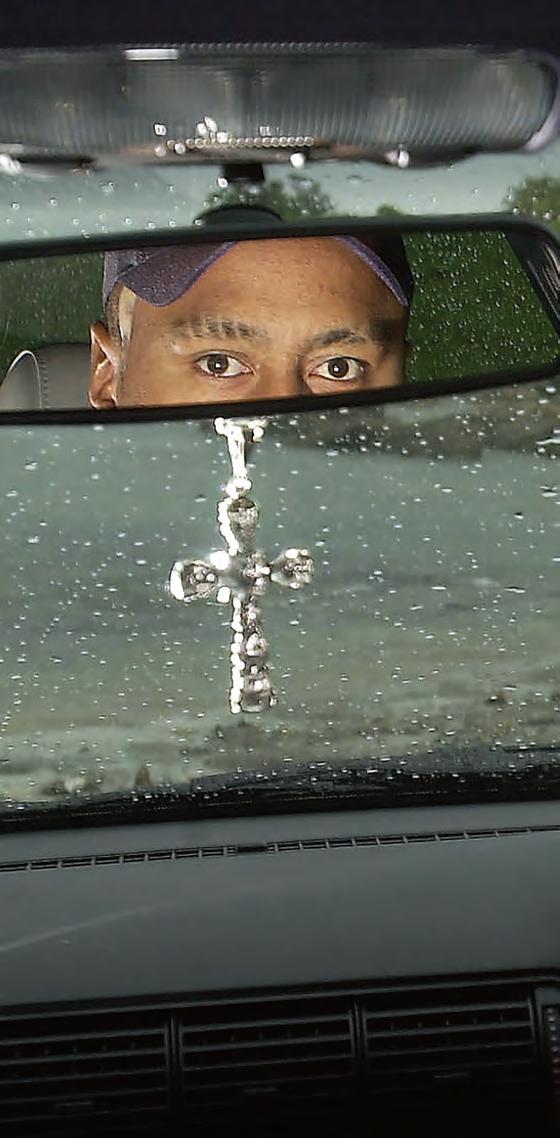
It is amazing, as you will read in the chapter on Lomu, to learn from Ric Salizzo, the All Blacks media manager at the 1995 World Cup, that the giant wing arrived in South Africa to no fanfare. He was a novice All Black who had failed to impress a year earlier and was promptly dropped by coach Laurie Mains. Lomu only just made the World Cup squad, yet by the end of the All Blacks first game against Ireland, Lomu was all anyone was talking about.
By the end of the tournament, he was a superstar and the perfect player to usher the sport into the professional era.

“LOMU-MANIA WAS A PROMOTER’S DREAM AND THE ATTENTION THAT FOLLOWED HIM NEVER ABATED. THERE WERE PLENTY OF PEOPLE WHO CASHED IN ON JONAH’S MARKETABILITY, INCLUDING THIS RUGBY JOURNALIST.”
Lomu-mania was a promoter’s dream and the attention that followed him never abated. There were plenty of people who cashed in on Jonah’s marketability, including this rugby journalist. French publications paid well for stories on the All Blacks, but much more still when they featured Lomu.
As much as he had a transformative impact on the game, Lomu didn’t have the trophies to match it. He won two Super 12 titles with the Blues and an NPC with Wellington, but he was part of All Blacks sides that tripped over at two World Cups, somewhat unluckily in the final in 1995 and more shockingly in the semifinal four years later.
In that respect he has good company within these pages: Christian Cullen, Tana Umaga, Carlos Spencer and Andrew Mehrtens also missed the big prize and the first two never won a Super Rugby title either.
If it is not winning, then, what makes a game changer?
The simplest criteria is that they changed the way their position, and in some cases, the game as a whole, was played. For players like Lomu, Cullen, Spencer, Sonny Bill Williams and our hookers, Sean Fitzpatrick and Dane Coles, what they did with the ball in hand speaks for itself.
Carter’s performance in the second test against the British and Irish Lions in Wellington in 2005 was hailed as a once-in-a-generation display and catapulted the young first five-eighth into stardom with the notoriously anti-All Blacks English press lavish in their praise.
became the first Pasifika player to captain the All Blacks in a test. The God-fearing cultural mores of Pasifika communities placed a high price on humility and their rugby players were more often than not deferential to authority within team settings, but Umaga changed that — he didn’t defer to authority as much as he was the authority. Young Pasifika players coming through in his wake saw that and in turn grew more confident.
Fitzpatrick also had a massive impact as captain, as did the greatest skipper of them all, Richie McCaw. Both men were omnipresent and each was hugely successful on the field, captaining sides that dominated the international game. Fitzpatrick became the first All Black captain to win a series in South Africa, for so long the Holy Grail of New Zealand rugby, while McCaw twice lifted the Webb Ellis Cup.
Williams is one of two league converts on the list alongside former Kangaroos hard man Brad Thorn. What they brought to rugby was significant — SBW with his offloads and Thorn with his tungsten edge and superhuman work ethic.
“LOMU IS THE DEVIL WE KNOW, CULLEN IS THE ONE WE’RE LEARNING ABOUT.”
– SCOTLAND’S CAPTAIN ROB WAINWRIGHT COMMENTS AFTER CULLEN SCORED FOUR TRIES AGAINST THE SCOTTS, 1996.
Cullen’s running game from the back was freakish, particularly his ability to change direction sharply without losing pace. Although his All Blacks career ended before YouTube started, his career was made for that format and his “Greatest Tries” videos to this day still sparkle and collect views in their hundreds of thousands. I covered his test career from go to whoa and it was stunning, but if there is a game that stands out it was in the modest setting of New Plymouth’s Yarrow Stadium in 2000, when a possession-starved Hurricanes side still managed to thrash the Reds 43-25. Cullen was incredible, helping Umaga to a hat-trick and scoring himself in a breathtaking display of long-range attacks.
Umaga changed his own game, moving from wing to centre and then second five-eighth, but his gamechanging impact was as much felt off the field when he
Williams was also uniquely, outspoken and saw himself as more than a rugby player, with boxing acting as a lucrative second sport. He was a polarising figure who snubbed the All Blacks victory parade after the 2011 World Cup triumph and gave his winners medal away in 2015. It was illustrative of his ability to rub some up the wrong way that Sir Graham Henry chose not to talk about him for this magazine.
Thorn also courted controversy early in his rugby career when he turned down All Blacks selection, saying he didn’t feel he was ready to play international rugby. When he was ready, he was one heck of a player and has amassed more trophies across both codes than any suburban mantlepiece could ever cope with.
My list almost picked itself, but wasn’t without second guessing and the odd change of heart. Jock Hobbs was an early inclusion due to the impact he had in securing the players to New Zealand Rugby contracts when the game turned professional and the anti-establishment rival, the Kerry Packer-backed World Rugby Corporation, threatened to steal the best players away.


As critical as Hobbs’ intervention was, it jarred having an administrator included, even if he was a former All Blacks captain. Equally, game-changing coaches like Sir Wayne Smith were left out so that the focus could stay on the players.
With so many amazing players to pick from throughout history, it was decided to focus on the professional era, thus excluding the likes of Sir John Kirwan, who made the shift to league in 1995.
The one player I had not initially considered but was talked into including was Mehrtens. I’d always seen him as a wonderful player but hadn’t necessarily thought of him as a game changer. Jeff Wilson and Justin Marshall convinced me his on-field impact was significant. Off the field he was somewhat revolutionary, too, with his intelligence, wit and willingness to speak his mind with the media cutting against the grain for your typical All Black.
Mehrtens’ propensity for speaking his mind could cause conniptions among NZR management, like when he bagged major sponsor Adidas’ test-match ball, calling it, among other things, a “pig”. Calls from team management for his comments to be treated as off the record were ignored and Mehrtens, to be frank, seemed to enjoy the kerfuffle.
He enjoyed a bit of drama on the field, too, like when he nailed a match-winning drop goal for the Crusaders against the Bulls at Pretoria and saluted the Loftus Versfeld crowd with a universally recognised single-digit salute.
“When the pressure was on he wasn’t fazed by it and didn’t make panicked decisions,” Marshall says of his great mate. “Mehrts would think so quickly that he always made the right decision to get himself out of trouble, or to get us into the right area of the field. That’s uncoachable. I’ve never seen a player with his time and awareness.”
Mehrtens is one of three first-fives in this book, which is perhaps not surprising as it is a position of huge influence and control.
There are two outside backs, or three if we count Umaga as a wing, and two midfielders in Umaga and Williams. There is one halfback, three loose forwards, two locks and two hookers.
It’s an arbitrary list, for sure, and there were many other
All Blacks that might have been included. Wilson was a terrific player who went very close, but Goldie was simply brilliant rather than transformative. The same can be said of try-scoring machines like Doug Howlett, Joe Rokocoko, Sitiveni Sivivatu, Ben Smith and even Julian Savea, who was Lomu 2.0.
Kieran Read was superb, and when he was used as a ball-playing loose forward on the edge, often in combination with Savea, he was close to unstoppable, but as a No 8 he didn’t break the mould and change the game in the way Zinzan Brooke, with his drop goals, long passes and willingness to give anything a crack, did.
I first saw Zinny playing for Marist in the Auckland 3rd grade (under 21) competition in the early 1980s. He was a hard man to miss, especially as he was kicking goals from the sideline. Phil Gifford saw him earlier, when he won a radio competition for shovelling gravel. “There were about 100 contestants, many of whom defined ‘hard bitten’: timber workers, road builders, bushmen from Tokoroa, most with muscles on muscles and tattoos on tattoos, all grimly determined to take home the $1000 prize. We all watched in astonishment as the lanky kid from Puhoi cleaned them up.”
I initially wrote that Brooke was as tough as Buck Shelford. Sub Editor Dylan Cleaver questioned my sanity. “This might be the biggest call in NZ rugby history,” he suggested. “Zinny was tough and unflinching... but was he really as tough and unflinching as Buck?” We tinkered with it as you will see, but I stand by the claim. Zinny was as tough as teak.
Finally, Michael Jones is my favourite game changer, simply because I was an impressionable schoolboy when he came on the scene and I adored the way he played the openside flanker position. Later, after Jones suffered a gruesome knee injury, I admired how he transformed himself from a No 7 with speed, support, timing and skills, to a brutally tough blindside flanker. For connoisseurs of a list like myself, thank goodness he did move to No 6 because choosing between Jones and McCaw as the greatest All Blacks flanker is a thankless task made possible only because the former can be named at six and the latter at seven.
To many followers of the Great Game, this will represent an imperfect list — which is perfectly fine. Sports lists are meant to be debated, just like those about movies, music and books. If yours is different, that’s great, but I still hope you enjoyed sifting through mine.
SEAN FITZPATRICK HAD ALL THE USUAL TRAITS OF THE BEST TIGHT FORWARDS, BEING TOUGH AND STREET SMART, BUT IT WAS OUT WIDE WHERE HE FOUND THE POINT OF DIFFERENCE THAT ELEVATED HIM TO THE GREATS.
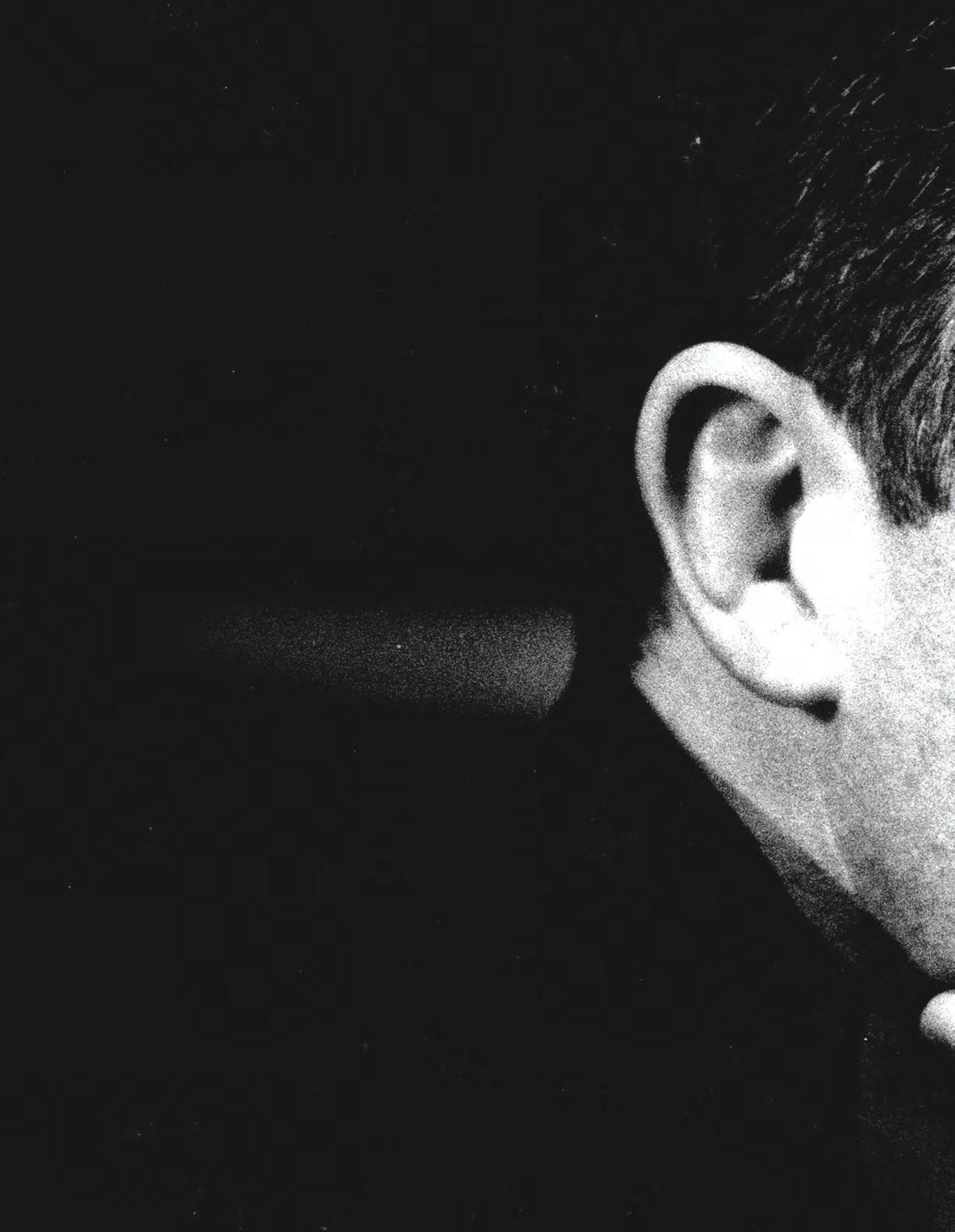
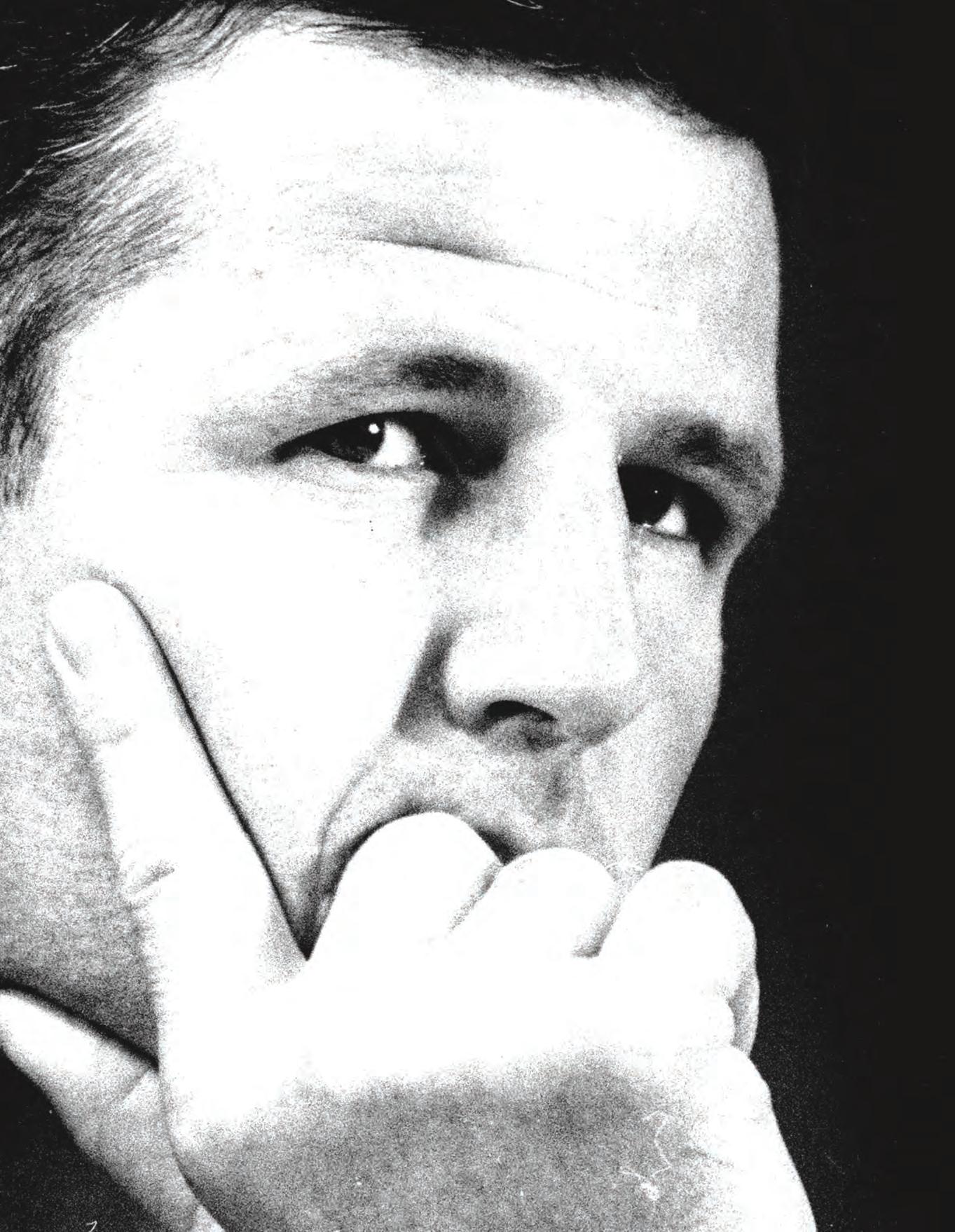
Sir John Kirwan likes to tell a story about the time he was dropped from the All Blacks.
Coach Laurie Mains told him he wasn’t scoring enough tries as he explained why Kirwan wouldn’t go away on the tour to England and Scotland at the end of 1993. Kirwan retorted that he’d score a lot more “if that bloody hooker wasn’t always on the wing”.
The hooker was Kirwan’s great mate Sean Fitzpatrick. To be fair, Fitzpatrick did score some of his 12 test tries on the wing, with Kirwan often delivering the final pass.
Fitzpatrick was no ordinary seagull, however. He wasn’t scavenging, or glory hunting for selfish reasons. Quite the opposite. He was canny, realising that as the game sped up there was little point in him trying to get from set piece to a ruck on the other side of the field when the play was likely to come back to him.
“Fitzy changed the game,” Kirwan says. “He was the first running hooker who was mobile and wanted to get the ball in his hands.”
It was Fitzpatrick’s willingness to stay out wide that became a hallmark of his game and remains a big part of every hooker’s repertoire, including modern All Blacks like Dane Coles, Codie Taylor and Asafo Aumua.
Sean Fitzpatrick
Born 4 June 1963 in Auckland, New Zealand All Black 871 All Blacks Test Debut Saturday, 28 June 1986 v France at Christchurch aged 23 years, 24 days Test Caps 92 Test Positions Hooker High School Sacred Heart College Club Auckland University
“He realised there was no need for him to clear a ruck that had already been cleaned out by three other blokes just because he was supposed to be there,” Marshall says. “It’s massive intelligence and awareness of where his place could be in the game. Not where it should be, but where it could be. He led the way and all of a sudden you started to see other hookers and props thinking about how they can offer the game more.”
Former All Blacks coach Sir Graham Henry, who coached Fitzpatrick at Auckland and the Blues, said Fitzpatrick’s seagulling never came at the expense of his core roles. “He was a big man, so he scrummaged well, but he was probably the start of the loose forward-style hooker because he had a skill set that was not seen by hookers in those times. He was an extraordinarily skilful hooker.”
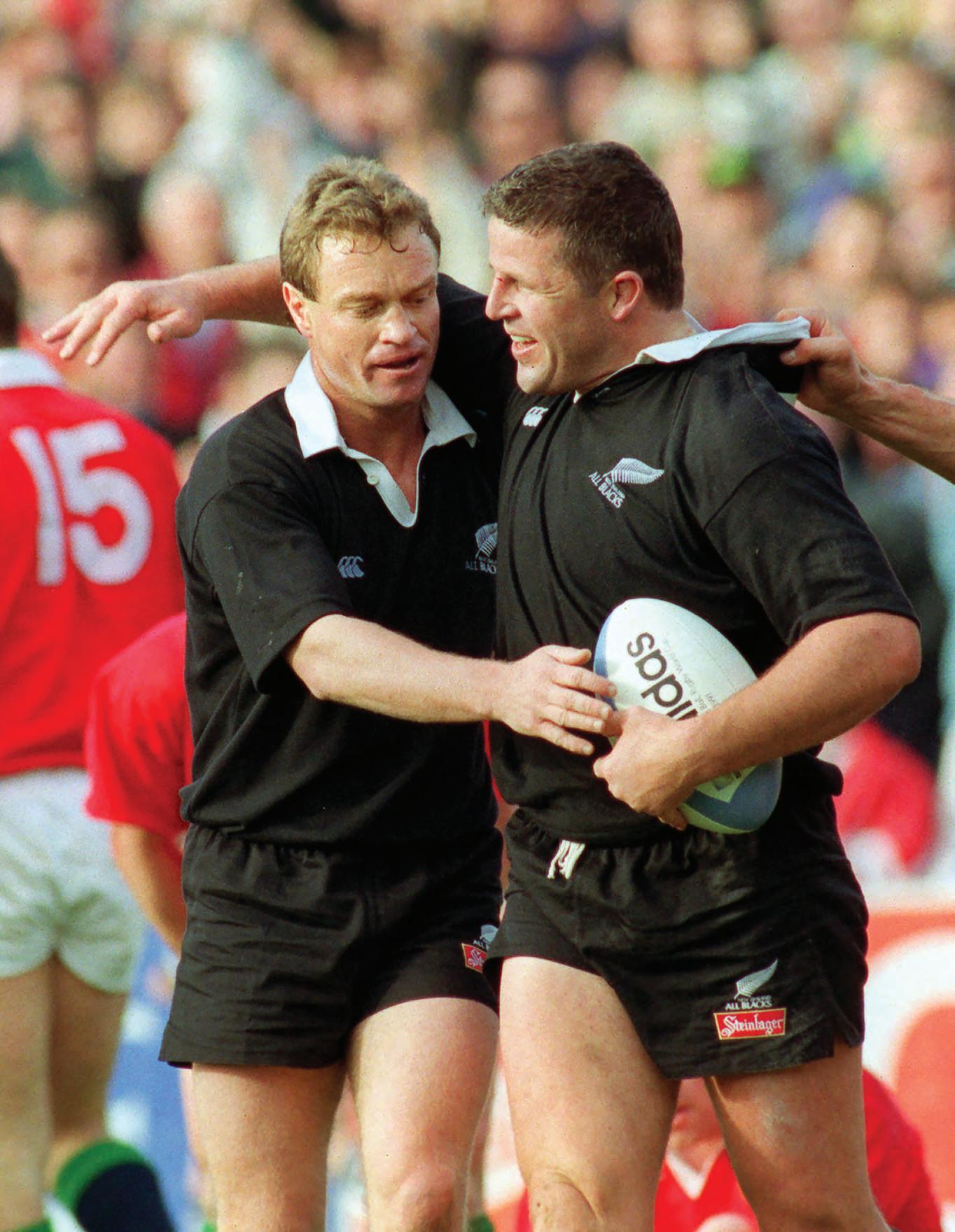
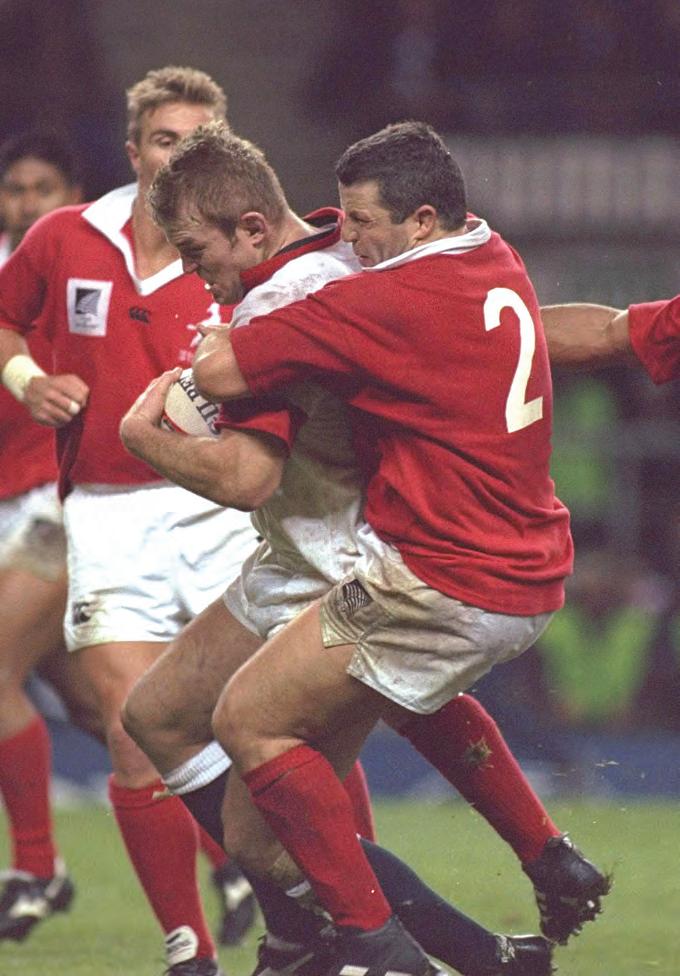
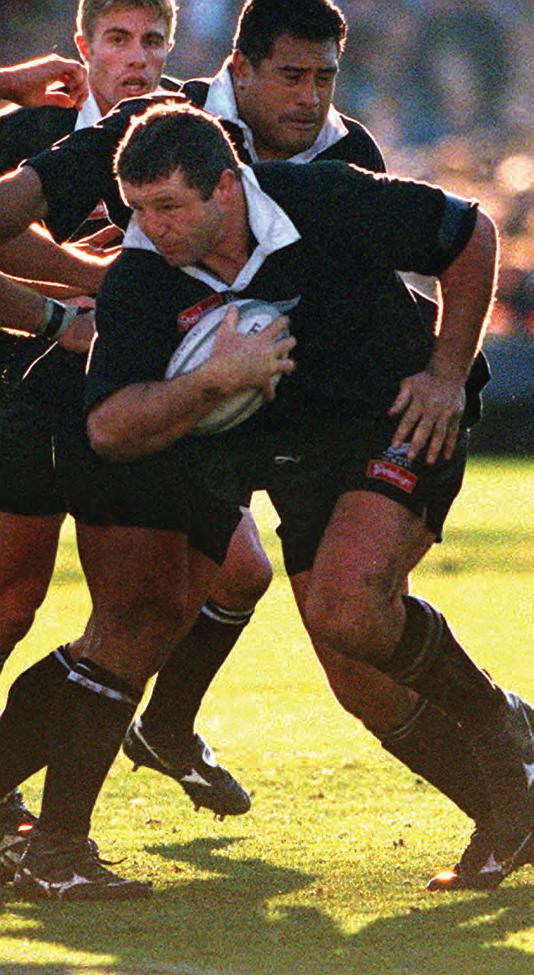
Those “extraordinary skills” extended to the dark arts, both subtle and in your face.
“Fitzy was the first guy to really try to manipulate the refs — with a smile on his face,” says Kirwan.
Fitzpatrick was the master at on-field niggle. He infuriated Springbok Johan le Roux so much during 1994’s second test in Wellington, won 13-9 by the All Blacks, that the tighthead prop chomped on Fitzpatrick’s ear. On the same Athletic Park turf four years earlier, Wallabies hooker Phil Kearns was moved to stand over Fitzpatrick while giving him the fingers after scoring a try in a seismic 21-9 Australian victory that shifted the immediate trajectories of both sides.
“He never liked his opposition getting the better of him,” says Justin Marshall, another player noted for living at the extremities of competitiveness. “That’s why he had so many ding dongs. There were some niggly, annoying hookers around during his time and Fitzy was a master at putting people off their game, but it never put him off his.”
Fitzpatrick combined his new-school philosophy on how his position could be played with an amplified old-school mentality about what it meant to be an All Black.
Lineage played a role in that. His father Brian was a midfield back who played 19 matches (three tests) for the All Blacks in the 1950s. Fitzpatrick senior made the All Blacks out of Poverty Bay, where he’d been a teenage

“THERE WERE SOME NIGGLY, ANNOYING HOOKERS AROUND DURING HIS TIME AND FITZY WAS A MASTER AT PUTTING PEOPLE OFF THEIR GAME, BUT IT NEVER PUT HIM OFF HIS GAME.”


Sean Fitzpatrick captained the All Blacks to their first series win in South Africa in 1996.
prodigy at Gisborne Boys’ High. He transferred to Victoria University in Wellington before settling in Auckland, where son Sean cut his own rugby path through Sacred Heart College and the University club.
“I think Fitzy cared the most of any All Black about the jersey. He recognised the significance of leaving the jersey in a better place,” says Marshall, who played alongside Fitzpatrick when they beat the Springboks in South Africa for the first time in a series in 1996.
“IF YOU LOOK AT HIS REACTION WHEN THE FINAL WHISTLE WENT, THUMPING THE GROUND, HE KNEW THE SIGNIFICANCE OF WINNING IN SOUTH AFRICA. NO ALL BLACK HAD DONE THAT BEFORE. NO TEAM HAD BEATEN THEM IN A SERIES BEFORE ON THEIR OWN SOIL. THAT REACTION TYPIFIED HIM.”
“If you look at his reaction when the final whistle went, thumping the ground, he knew the significance of winning in South Africa. No All Black had done that before. No team had beaten them in a series before on their own soil. That reaction typified him.”
Jeff Wilson agrees that Fitzpatrick brought a new level of care to the All Blacks legacy, while also demanding high standards from his teammates and coaches.
“The one thing you never wanted to do was let Sean Fitzpatrick down because you knew he would sacrifice everything for the All Blacks jersey — and I’m sure he would have sacrificed everything for the Auckland and Blues jerseys too,” Wilson says.

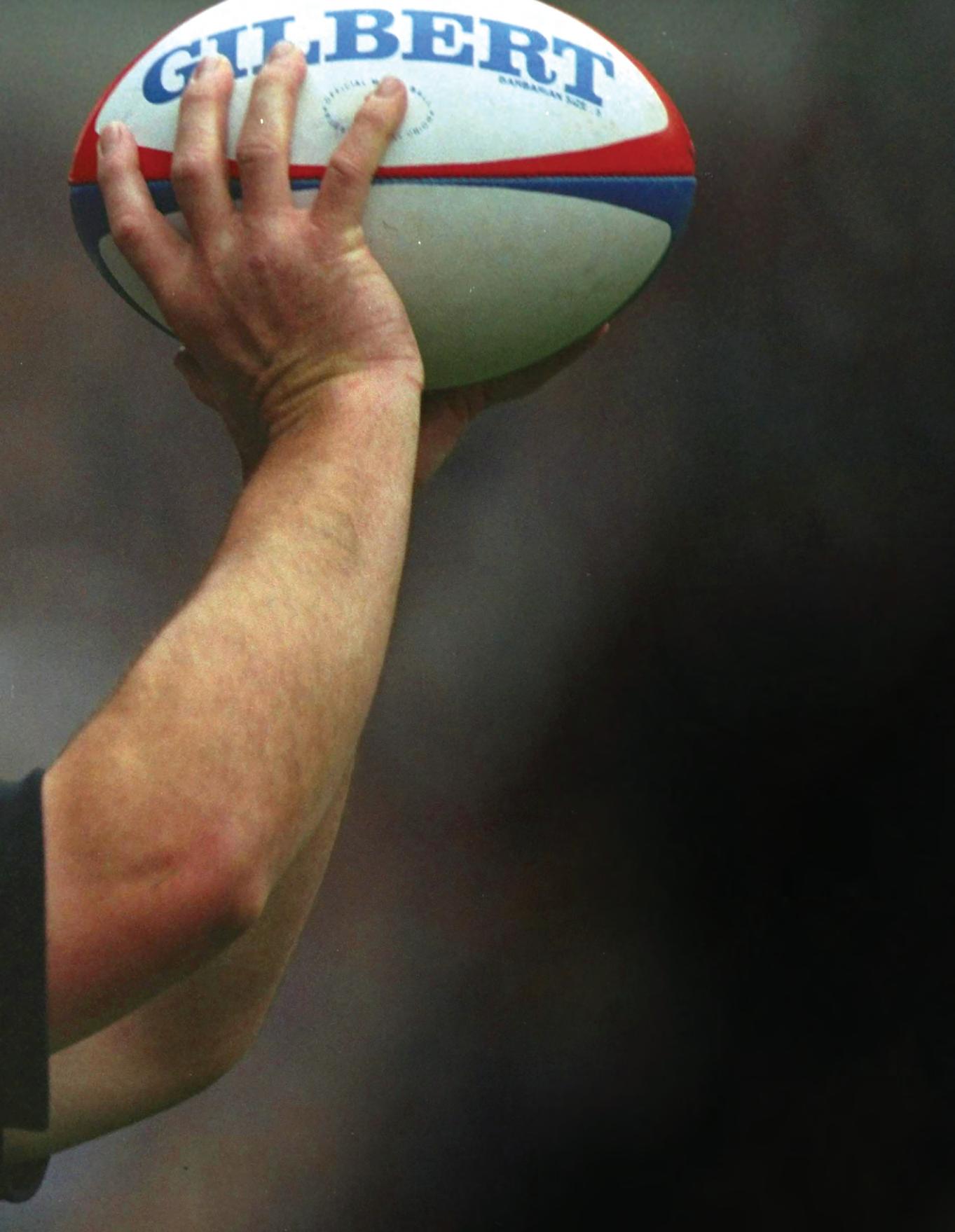
“He led by example and by expectation. His standards were high and he knew what it took to be successful and he wanted you to be successful. That is great leadership.”
While Fitzpatrick was synonymous with Auckland, it was an Otago stalwart in Mains who promoted him to test captaincy. It was an unlikely partnership that got off to a rocky start, but proved to be the making of Fitzpatrick.
“Fitzy was part of an Auckland group that misunderstood their role in New Zealand rugby and thought perhaps they were a bit more important than they really were, but I very quickly warmed to him.”
It was an injury to captain-elect Mike Brewer at the All Blacks trials and Mains’ dislike of Gary Whetton that left Fitzpatrick as the only realistic option to lead the team against the World XV in 1992. He went on to captain the All Blacks in 62 of his 128 games (51 times in 92 tests) and was the first out of the tunnel 44 times with Mains as coach.
“I always used to say he had a backbone of stainless steel. He was unbendable,” Mains says. “He had a great ability during a game to assess the best thing he could do whether it was to be on the wing or be right in the middle of the tough stuff. He just seemed to pick it right every time.”
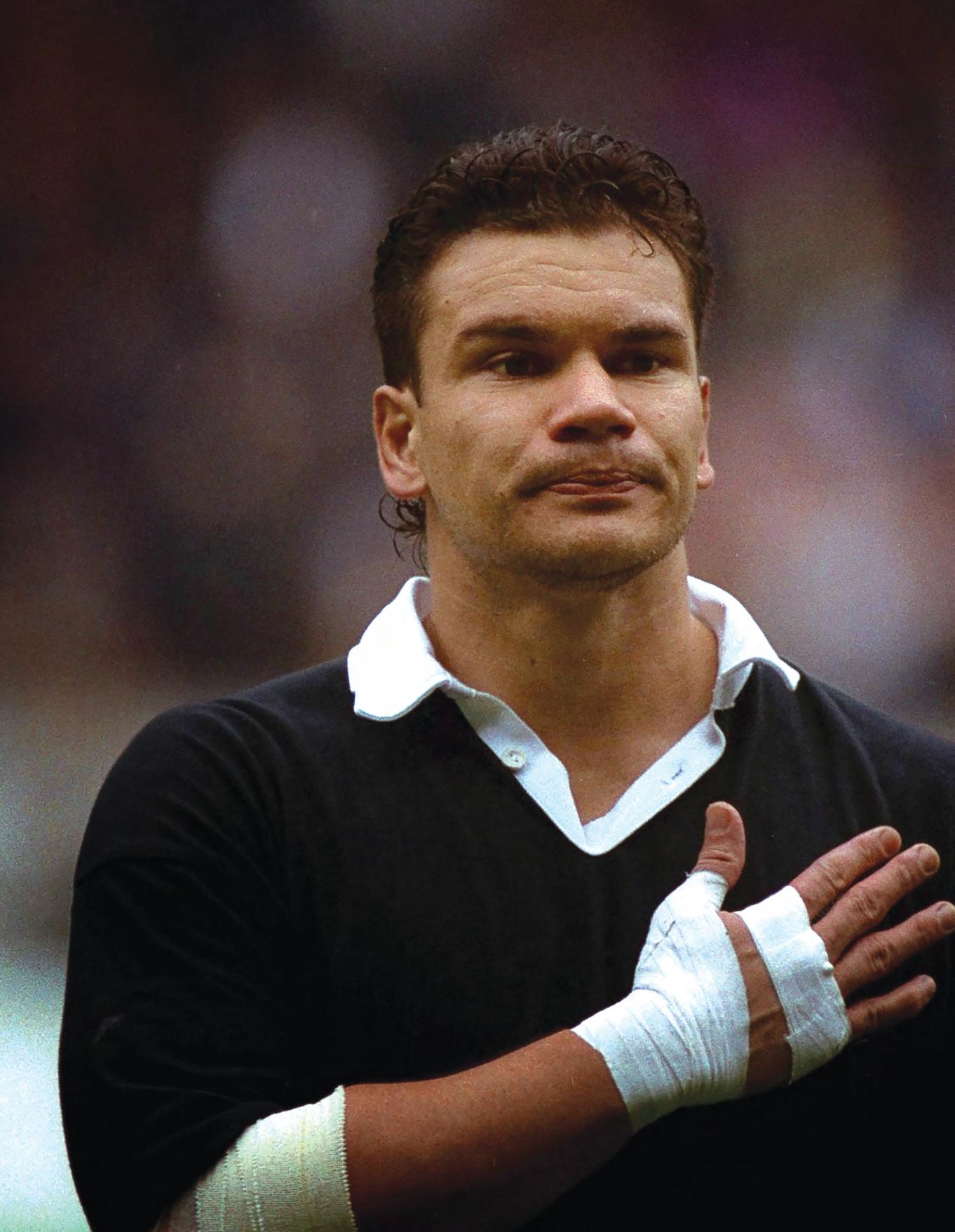

MICHAEL JONES HAD SUCH A DEEP RESERVOIR OF TALENT, NO MATTER WHICH SIDE OF THE SCRUM HE PACKED DOWN ON, HE COULD INFLUENCE TESTS WITHOUT TOUCHING THE BALL.
Michael Lynagh was baffled.
It was the day after a test against the All Blacks and the great Wallabies first-five was telling those at a dinner that he couldn’t believe how little recognition Michael Jones had received for wreaking havoc on the Australian backline.
The celebrated cartoonist Tom Scott, who was at the dinner at Kiwi business tycoon Sir Bob Jones’ Sydney residence, asked what the flanker had done that was so special. “Lynagh said that Jones had tackled him so hard early in the match that it put him off his game,” Scott recalls. “He explained that because it hurt so much he didn’t want to get tackled by Jones again.”
The mere threat of another crunching at the hands of Jones laid waste to the Wallabies backline plans, with Lynagh telling his fellow diners that it led to a succession of poor passes and broken play.
“He’d get the ball from halfback Nick Farr-Jones and would spy Jones coming at him, so he would throw a hasty pass to the second-five, who would also see Jones change his trajectory, so he would throw a hasty pass to the centre,” Scott recounts.
Born 8 April 1965 in Auckland, New Zealand
All Black 882 All Blacks Test Debut Friday, 22 May 1987 v Italy at Auckland aged 22 years, 44 days Test Caps 55 Test positions Openside, Blindside, No 8 High School
Henderson High School Club Waitemata
The end result was a shambolic creep across the field with the wing too close to the touchline to have any impact.
“He didn’t have to touch anyone to completely ruin what we wanted to do,” Lynagh told Scott and those at the dinner, who included the future World Cup-winning skipper Farr-Jones.
Jones’ Auckland, Blues and All Black teammate Sean Fitzpatrick was well aware of the psychological impact an in-form Jones could have on the opposition.
“I remember Nick Farr-Jones telling me that the Wallabies felt if they could keep Michael Jones quiet, they had a chance at beating the All Blacks, because he could dominate a game,” Fitzpatrick says.
“He’s like Dan Carter for me. When Dan dominated a game, the All Blacks won, and it was the same with Michael. He could single-handedly dominate a game, which is quite unusual for his position.”
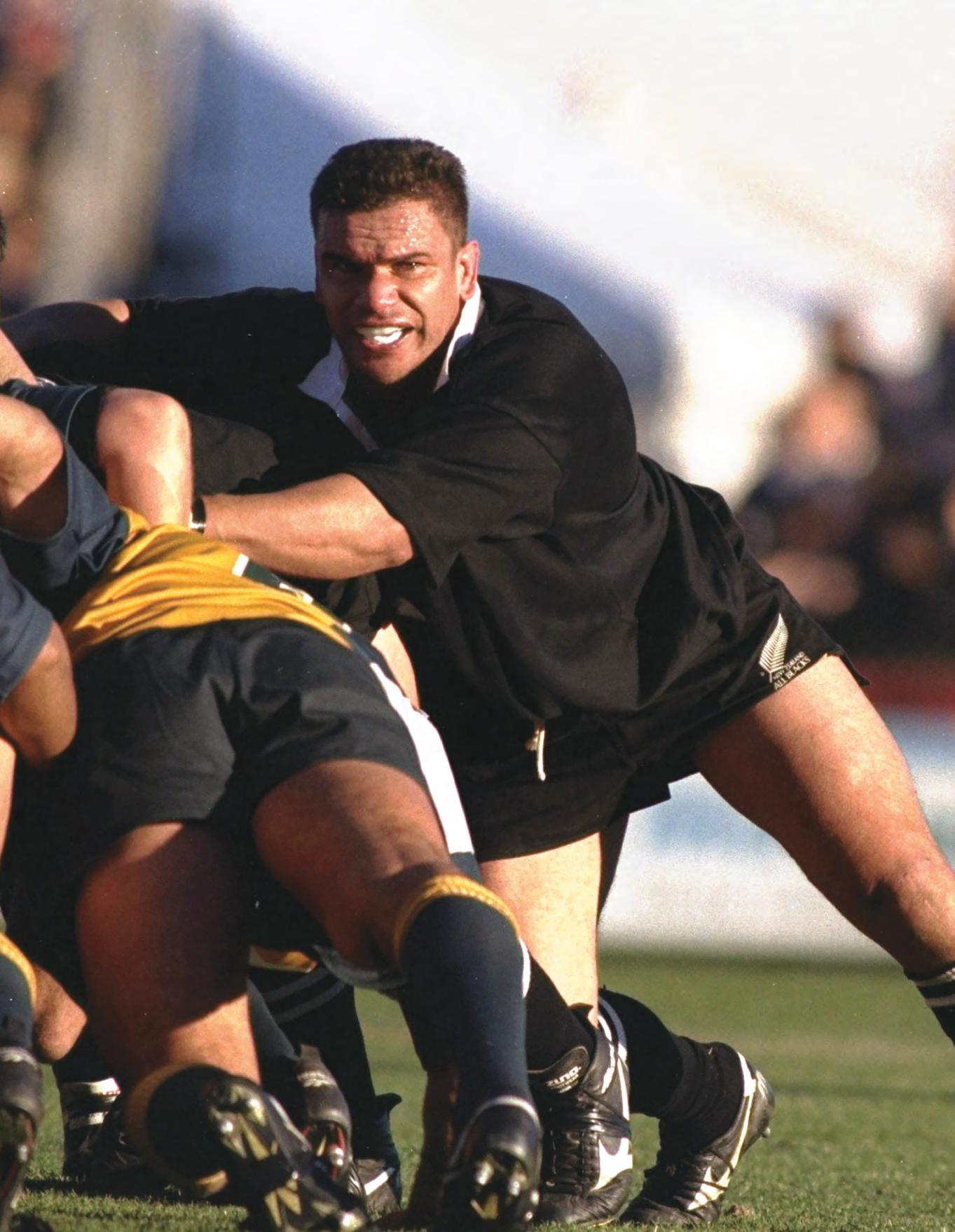


There are several strands to what makes Michael Jones such a dominant player, but also why he had such a transformative impact on the game. There is Jones the player, but equally there is Jones, a proud product of blue-collar Henderson in Auckland’s multicultural west, the community leader and an inspiration to many who followed in his footsteps.
Jones was an athlete in the truest sense of the word. Tall, muscular, agile and spring-heeled, Jones was quick and strong. He was an excellent basketballer in his youth, which assisted his footwork and aerial skills. All of those physical and technical gifts combined to give the All Blacks something truly unique. “The lines he ran, the short balls, we hadn’t seen a seven play that way before,” Fitzpatrick says.
His opening try at the 1987 World Cup was the perfect distillation of the sort of skills that marked him out as a game changer. Winning a tighthead scrum deep in Italian territory, the All Blacks probed the blind through Wayne
Shelford, Alan Whetton and Grant Fox. When Fox was tackled 10 metres from the line he looked for an inside pass and who was ranging up but Jones, who had run a perfect line to get there from the openside of the scrum. He caught the pass, fended off a would-be tackler and dived full length to score. That spectacular dive has since been immortalised in bronze, with Natalie Stamilla’s statue welcoming visitors inside the gates of Eden Park.
Jones was more than just athletic. He was rugby smart, running incisive lines in the days when an openside supported the inside shoulder of his wings. “When he was a seven I didn’t have to look for him on my wing, I just knew he would be there,” Sir John Kirwan recalls.
Sir Graham Henry, who coached Jones as a blindside flanker at Auckland and the Blues, says he played the game two or three moves ahead of anyone else. “His anticipation was the greatest of any player I coached. He was always in the right place at the right time.”
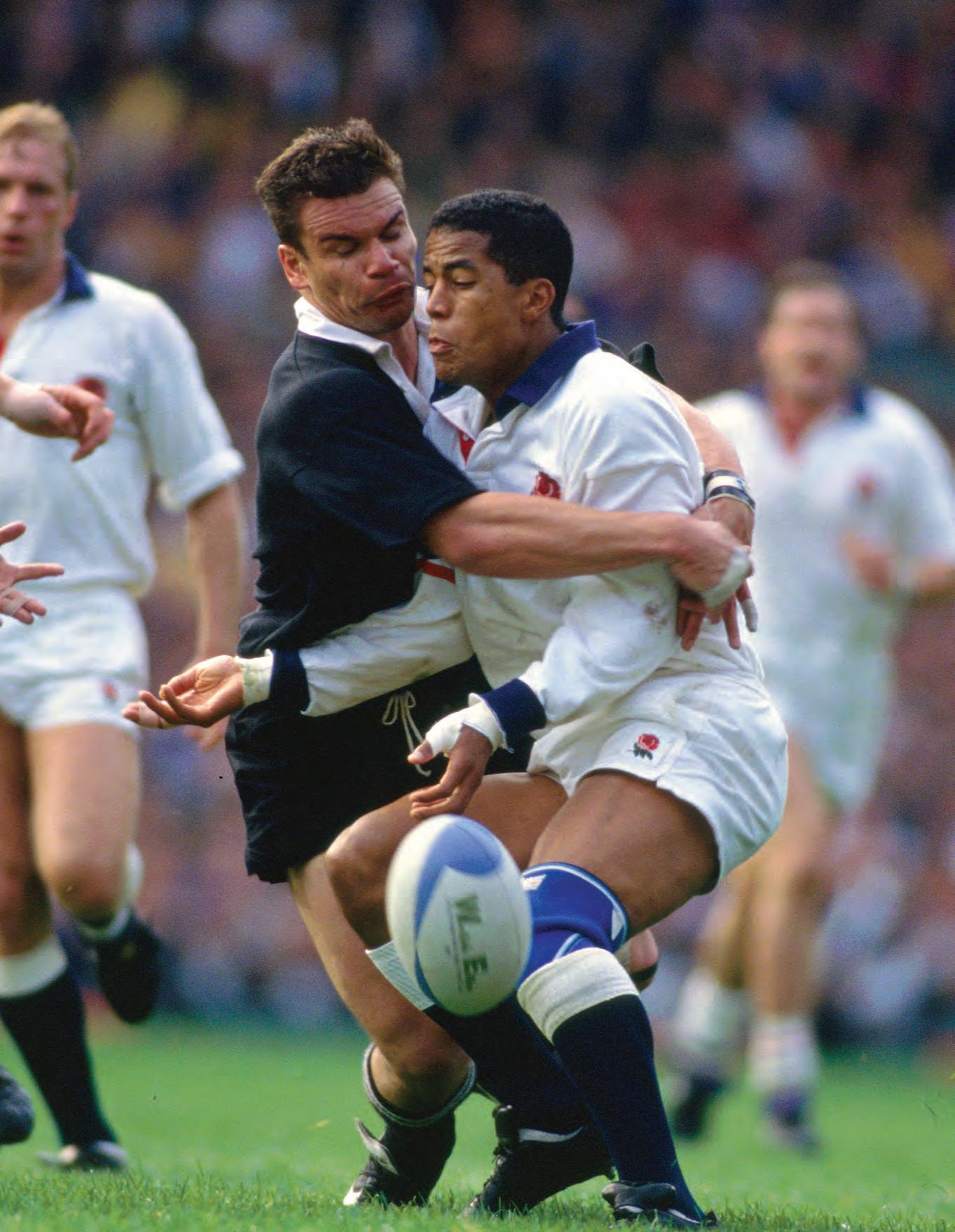

Jones changed the way we thought about opensides, which is an achievement in itself. To do it again at blindside flanker, where he started 19 of his 55 tests, speaks again to his gamechanging greatness. The switch from number seven to six for the final third of his career was largely due to one of the defining moments of his career: a catastrophic knee injury suffered while playing Argentina at Wellington’s Athletic Park in 1989.
“I ruptured every single ligament in my knee,” Jones would later say, “and I remember the doctor gave me the prognosis that it was the end of my career.
“The injury was like being hit by a car at 40km/h, and it was the worst knee injury the doctor had seen. I didn’t want to give up on the dream; I didn’t want any regrets. It was excruciatingly difficult [to come back], but my faith was important.”
His first-class return was for Auckland against Southland at Eden Park and when Jones took a pass from Terry Wright with about 30 metres to run and no defender in sight, the modest crowd rose to their feet. They were still standing as he ran back to halfway to join his teammates.
“JONES CHANGED THE WAY WE THOUGHT ABOUT OPENSIDES, WHICH IS AN ACHIEVEMENT IN ITSELF. TO DO IT AGAIN AT BLINDSIDE FLANKER, WHERE HE STARTED 19 OF HIS 55 TESTS, SPEAKS AGAIN TO HIS GAMECHANGING GREATNESS.”
A month later, he was back in the All Blacks for the 1990 tour to France, starting at openside in both tests, which is where he would remain through to the end of the All Blacks’ bitterly disappointing 1991 World Cup campaign.
Jones knew he had lost pace and that a shift to the other side of the scrum was inevitable. “I had to reinvent myself,” he said. “I had to live with a lot of related niggle injuries due to the fact my knee was basically reconstructed. I think that’s why my other knee went in 1997, when I ruptured the patella tendon. I lost a metre or two of speed but got wiser and smarter.”
Michael Jones was universally respected for what he did on and off the field.
The man dubbed Ice was as gentle off the field as he was ferocious on it. Asked in the This is Your Life television show how he reconciled his brutal tackling with his deep Christianity, Jones smiled and said: “The Lord says it is better to give than to receive.”
Kirwan still chuckles at the story.
“We used to see tackling as something you had to do before you got the ball back, but Michael thrived on smashing people and we thrived on him doing that. He led the way for others like Jerry Collins and Jerome Kaino who were passionate about smashing people on defence.”
The softly spoken Jones overcame his shyness to become a leader off the field. He was resolute in his faith and his determination to not play on Sundays, even though that saw him miss several key matches, such as the semifinal of the 1991 World Cup when New Zealand were humbled by a David Campese-inspired Wallabies side. That strength of conviction led to the next All Blacks coach, Laurie Mains, omitting him from the 1995 World Cup squad because two pool games and the likely semifinal were on Sundays.
Despite such setbacks, Jones, a Samoan who represented that country once in 1986 before he switched his allegiance to New Zealand, never swayed from his stance and that resonated with many who followed in his footsteps, especially Pasifika players. There had been a sprinkling of others of Pacific Island heritage who had played for the All Blacks, with wing Bernie Fraser and Sir Bryan Williams the highest profile, but Jones captured the attention of a burgeoning Polynesian rugby population.
“He was an inspiration to me,” says 132-test veteran Keven Mealamu. “It’s not just the way he played the game but how he carried himself. He was an All Black who wouldn’t play on Sundays and he stood behind that, saying ‘this is what I believe in, this is who I am’. That stood out to me,” says Mealamu.
“He was a man of values.”



ZINZAN BROOKE COULD DO IT ALL. TOUGH AND UNCOMPROMISING, HE HAD THE SKILLS OF A BACK AND THE COURAGE TO KICK DROP GOALS IN TEST MATCHES.

Jon Preston had never been happier to have the ball bypass him.
Late in the second test against South Africa in Pretoria in 1996, in what became a historic win, the All Blacks led by just four points, 30-26. From a ruck on the 22m line and just to the left of the posts, halfback Justin Marshall looked first at Preston on his right, then turned to his left and fired a pass to Zinzan Brooke.
The No 8 calmly slotted a drop goal, one of three he will kick for the All Blacks.
“We were on either side of the ruck and calling for the ball, and Zinny must have called louder than me,” Preston says. “I wasn’t unhappy when the ball went to him and he slotted it.”
Preston wasn’t shy of pressure — he had earlier kicked a critical penalty immediately after replacing Simon Culhane — but Brooke was the man for the moment.
“Zinny thought he could do everything,” says his long time Marist, Auckland and All Blacks teammate Sir John Kirwan, “and he probably could.
Zinzan Brooke
Born 14 February 1965 in Waiuku, New Zealand
All Black 883 All Blacks Test Debut Monday, 1 June 1987 v Argentina at Wellington aged 22 years, 107 days Test Caps 58 Test positions No 8, blindside, openside High School Mahurangi College Club Auckland Marist
“When you look at Zinny as an athlete, he wasn’t chiselled, he wasn’t cut, but he was tough, he was uncompromising and skilled. He would stay out for an hour after training having a competition with the kickers about who could kick better. He would have a parking competition, just because he could. He never played for fun; he hated losing.”
As talented as Brooke was, it took three years and a controversial dropping for him to establish himself as an All Black. Having shone in the New Zealand sevens team in 1987, Brooke was part of the All Blacks World Cupwinning squad that year, playing in one test, against Argentina, at openside flanker.
It wasn’t until 1990 and in his fifth test, that he got his first start at No 8 following skipper Wayne ‘Buck’ Shelford’s sensational dropping. The axing shocked a nation and saw “Bring Back Buck” signs adorn sports grounds for decades to come. As Shelford’s immediate replacement, Brooke was
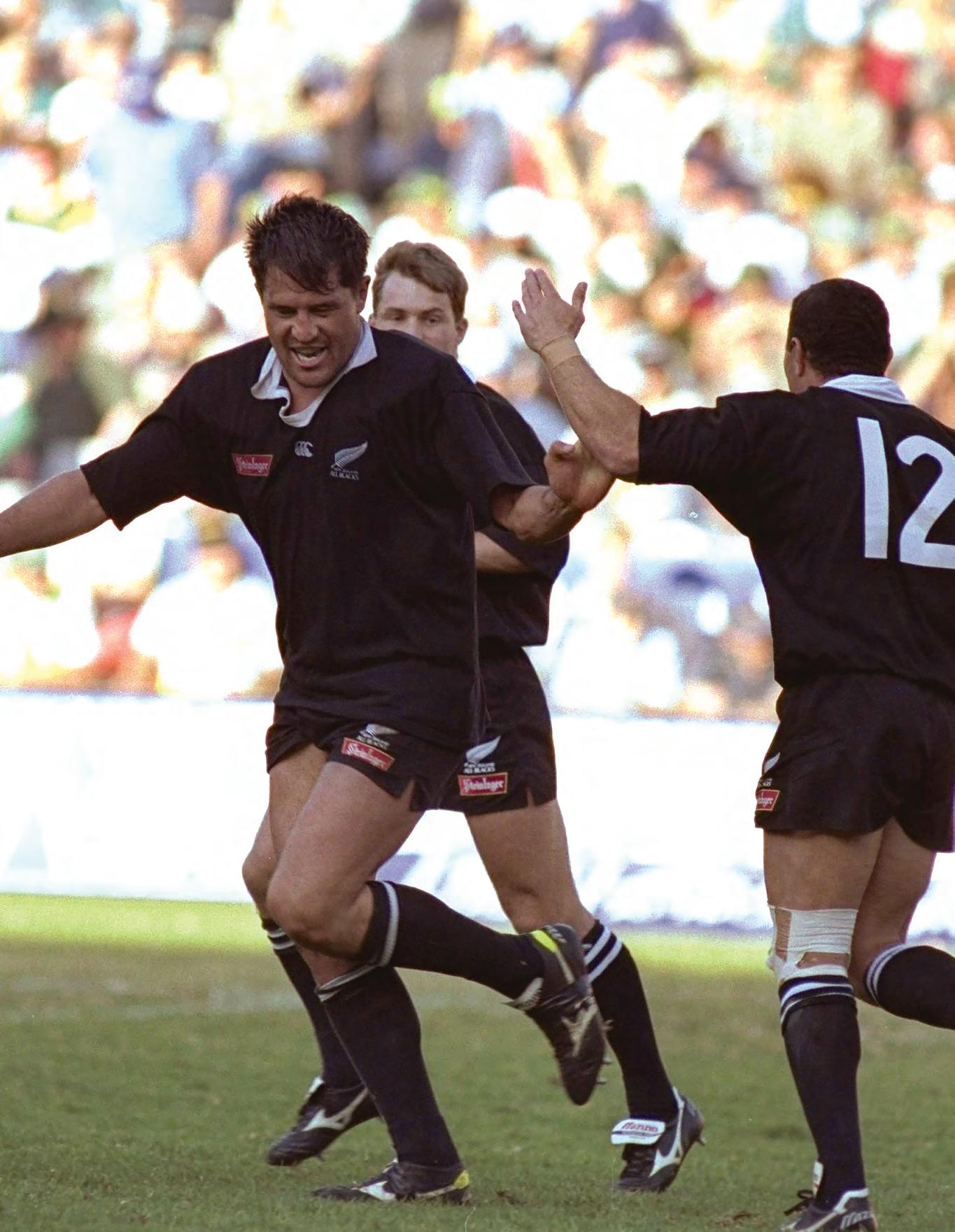


the subject of intense scrutiny and criticism. It was probably no surprise that he struggled to become a fixture at the back of the scrum, especially when Laurie Mains won the job to replace co-coaches Alex Wyllie and John Hart at the conclusion of an underwhelming 1991 World Cup campaign.
Mains flirted with Arran Pene and Richard Turner, but Brooke’s skills and competitive drive, and Sean Fitzpatrick’s support, eventually wore the southerner down.
“I wasn’t a big fan of Zinny,” Mains admits. “I was disappointed when Buck Shelford got dropped because I really rated and respected Buck. Fitzy talked me into taking Zinny to Australia in ’92. I said, ‘Okay Fitzy, that’s a captain’s pick and I’ll go with it.’
“Fitzy said to me, ‘You tell Zinny what you want him to do, and he will do it.’ Well I found out over the next four years that whatever you wanted Zinny to do, including playing openside flanker, Zinny could do it. He could do anything.”
Brooke carried much of the blame for Shelford’s axing, as if he had unduly influenced coach Wyllie, but for the all the glitz in his game, with audacious long-range reverse passes or receiving long kicks from the opposition by trapping the ball with his feet, he was tough and unflinching. While Shelford might still be considered the toughest of No 8s, Brooke was no softie.
Veteran journalist Phil Gifford loves to recount the first time he saw a skinny, teenaged Brooke.
“I first met him in 1982 when he was 17, the youngest entrant in a gravel-shovelling contest at a Henderson

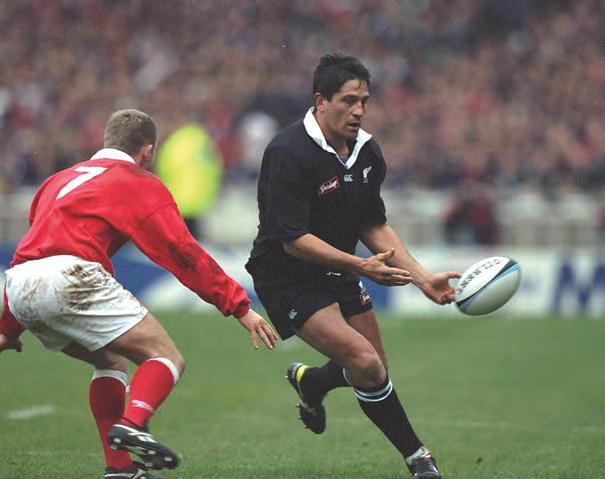
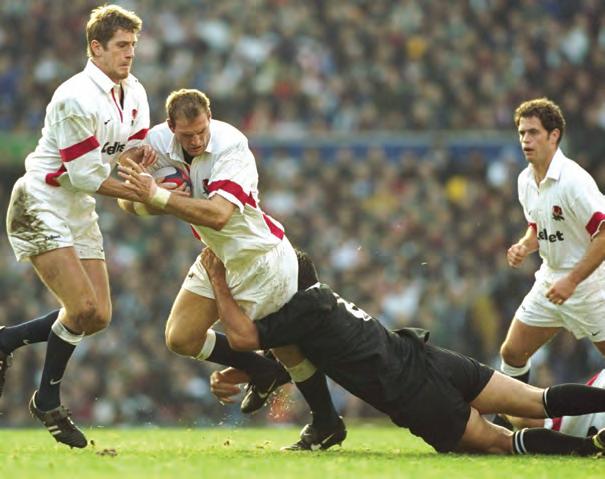
hardware store, sponsored by the radio station I was working for. There were about 100 contestants, many of whom defined ‘hard bitten’: timber workers, road builders, bushmen from Tokoroa, most with muscles on muscles and tattoos on tattoos, all grimly determined to take home the $1000 prize. We all watched in astonishment as the lanky kid from Puhoi cleaned them up.”
Brooke was naturally strong from a farm upbringing that saw him shearing 300 sheep a day aged 14. He brought that innate toughness to his rugby with defence nearly every bit as staunch as the hugely respected Michael Jones.
It was his skill set that set him apart, though, and even those who had been on the receiving end of Brooke’s
outrageous talents had to admit he was one of a kind. In 2007, former England centre and captain Will Carling published his list of the “50 Greatest Rugby Players” in The Daily Telegraph, and ranked Brooke the ninth-best player of all time.
“For a forward his skills were outrageous,” Carling wrote. “As comfortable playing sevens as 15s, he had better kicking and handling skills than some fly-halves playing international rugby. You align that with his strength and ability as a forward to read the game — he was unique.”
Carling would have seen Brooke up close and personal when the No 8 signed for his Harlequins club in England in 1997. Professionalism had come just in time for Brooke to put himself on the open market, having previously eyed
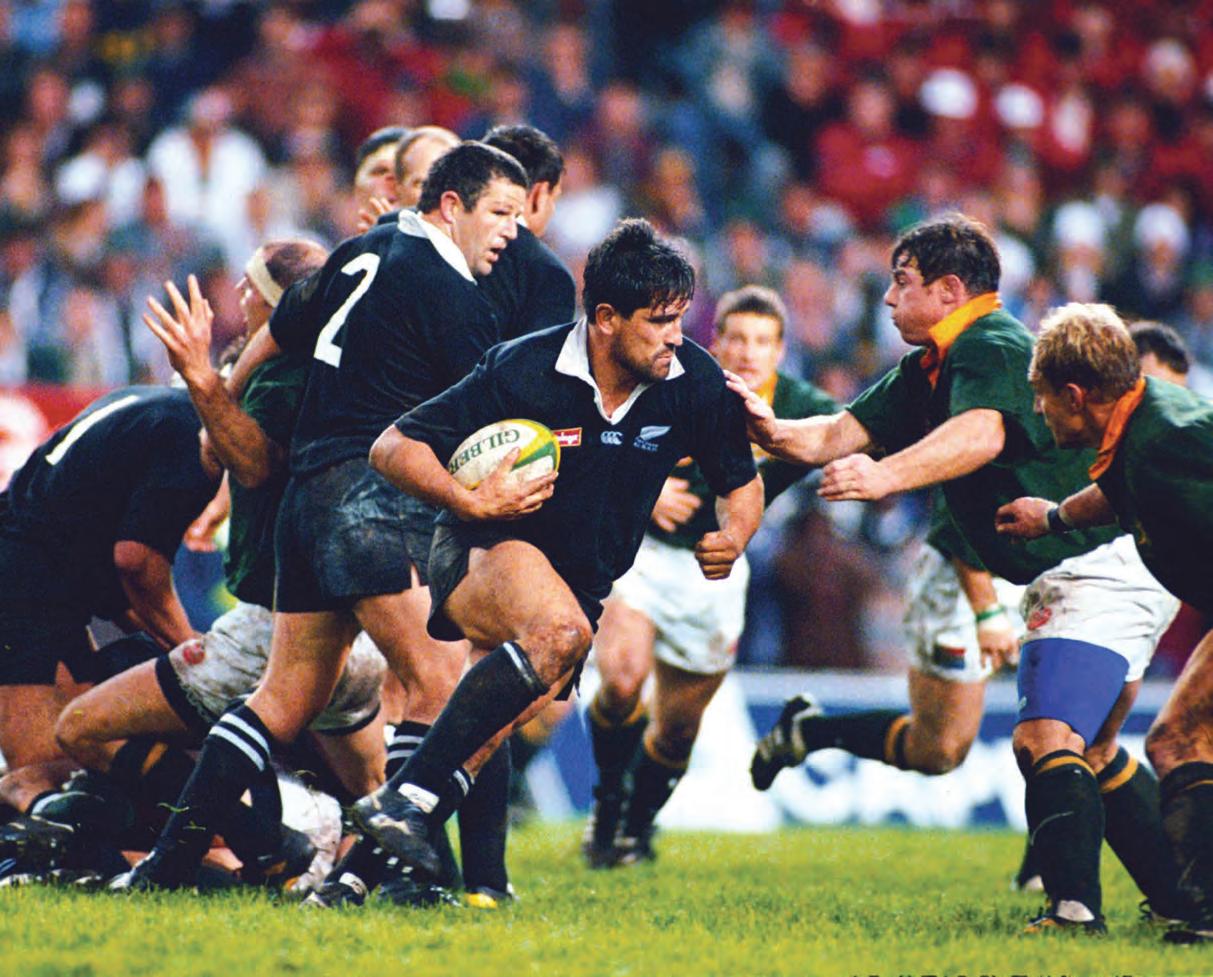
“BROOKE
WAS NATURALLY STRONG FROM A FARM UPBRINGING THAT SAW HIM SHEARING 300 SHEEP A DAY AGED 14. HE BROUGHT THAT INNATE TOUGHNESS TO HIS RUGBY WITH DEFENCE NEARLY EVERY BIT AS STAUNCH AS THE HUGELY RESPECTED MICHAEL JONES.”
Ultra competitive, Brooke won 45 of the 58 tests he played for the All Blacks.
up a big-money switch to rugby league. He had in fact signed with the Manly Sea Eagles in 1989 before asking for the contract to be annulled, and he was also close to moving to Japan where his older brother Marty was playing.
Marty had led the way in terms of making the call to join Marist out of Mahurangi College, which was in those days still in the North Auckland union, with North Harbour only coming into existence in 1985. Zinzan followed, as did younger brother Robin.
In age-grade rugby for Marist, Zinny was the long-range goal kicker and he never lost his sight for a goal. With the All Blacks he added the three drop goals to his 42 tries (17 in tests, which was a record) with the famous kick in Pretoria, one a year earlier against England in the 1995 World Cup semifinal and the third in his penultimate test, against Wales in 1997.
“Watching him you saw a guy who was quite prepared to gamble on his skills,” says Marshall, who stood behind Brooke in many of his 58 tests. “The reason he was able to do that was he practised his skills. Anything that was skill oriented, he didn’t believe anyone was superior to him.”
Which brings us back to Loftus Versfeld, Pretoria, and the droppie that drove a stake through Springbok hearts, helping to win the test and a historic series victory in South Africa.
“That did not go according to plan,” Marshall admitted, saying all he could hear was a cacophony of voices calling for the ball as it emerged from the ruck. “As I turned around to pass, I saw Zinny in the pocket and I tried to stop but didn’t and the pass lobbed its way to Zinny. My thought was, ‘What are you doing there?’”
Nevertheless, it left Marshall in the ideal spot to watch history unfold as the ball sailed off Brooke’s boot and over his head.
“He hit it magnificently and I’m thinking, ‘That’s got a chance’.”
Of course it did . It was Zinny.



JONAH LOMU WAS RUGBY’S FIRST TRULY GLOBAL SUPERSTAR. THE SPORT WOULD HAVE GONE PROFESSIONAL EVENTUALLY, BUT THE PAINFULLY SHY KID FROM SOUTH AUCKLAND CERTAINLY SPED UP THE PROCESS.

At a media call to chat with Jonah Lomu ahead of the All Blacks opening World Cup game against Ireland in 1995, nobody turned up.
Lomu and the All Blacks media manager Ric Salizzo waited in the lobby of the team hotel for more than 20 minutes until they realised it was a waste of time.
The no-show might have been frustrating for Salizzo and was probably a relief for the painfully shy Lomu, but it was hardly surprising. Lomu had played his only two tests for the All Blacks against France the previous year and had not impressed. He was dropped after the second test defeat at Eden Park and hadn’t featured in coach Laurie Mains’ plans for the World Cup in South Africa.
It was only after a concerted fitness campaign and an injury to Eric Rush that Mains was persuaded by the senior players to pick the teenager who turned 20 a few days before the World Cup kicked off.
“I’ve often told Rushy the greatest thing he did for the All Blacks was pull a hamstring to let Jonah join the World Cup squad,” Salizzo says with a laugh.
The rest, as the saying goes, is history.
Lomu was outstanding in the opening match against Ireland and the man no one wanted to talk to before the game was all anyone could talk about after it.
Born 12 May 1975 in Auckland, New Zealand All Black 941 All Blacks Test Debut Sunday, 26 June 1994 v France at Christchurch aged 19 years, 45 days Test Caps 63 Test positions Wing High School Wesley College Club Weymouth
“The press conference was packed and every second question was about Jonah. We knew we had a movie star in our ranks,” Salizzo remembers.
By dint of his on-field deeds during those two months in South Africa, Lomu became a global superstar, his four tries in the semifinal against England catapulting him into a sporting and celebrity orbit no All Black had flown in before, or since.
Fame grabbed Lomu and never let him go.
There have been a lot of incredible All Blacks, many of whom have changed the game and their position. Colin Meads was a colossus. John Kirwan was the first of the truly big, strong and fast wings. Michael Jones was an athlete beyond compare who could play all three loose forward positions.



Sonny Bill Williams brought a skill set to rugby the game had never seen before. Richie McCaw dominated the game like nobody else and Dan Carter was simply the most complete first five-eighth the game had seen.
None of those men captured attention like Lomu. As the World Cup unfolded it became standing room only at Lomu’s media appearances, a depth of interest that accompanied him throughout his career. Lomu was often uneasy with the attention, but in his own way was an accommodating subject, even when the interest in him reached tabloid status — especially outside New Zealand. Lomu’s rise to stardom saw him hit the headlines for all manner of reasons beyond the white lines of the field. He
had a computer game and street named in his honour. He was the subject of not one but two This is Your Life shows — one in New Zealand and the other in the United Kingdom. In 2000, he hit the news when a New Zealand First MP urged him to end his bid to have the loudest car stereo in the world, citing the country’s grim hearing-loss statistics among youth. He was often in the gossip-driven sections of newspapers and magazines due to a string of failed relationships and his three marriages, while the revelation that he was battling a chronic kidney disease, nephrotic syndrome, which would eventually require a donor transplant, was front-page news and led bulletins.
His commercial heft was recognised by global corporate heavyweights Adidas, who personally sponsored him,
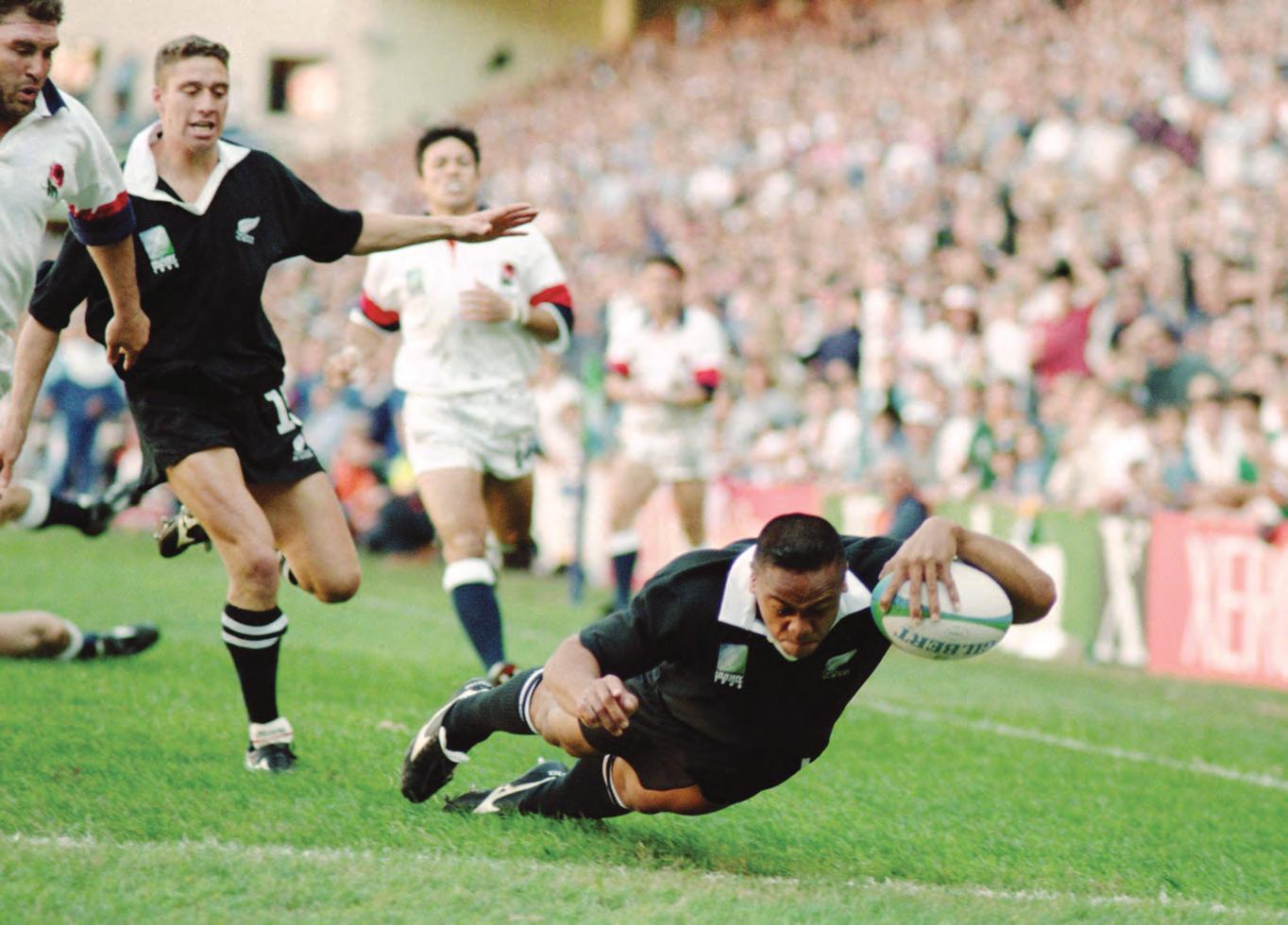
“AS THE ’95 WORLD CUP UNFOLDED IT BECAME STANDING ROOM ONLY AT LOMU’S MEDIA APPEARANCES, A DEPTH OF INTEREST THAT ACCOMPANIED HIM THROUGHOUT HIS CAREER.”
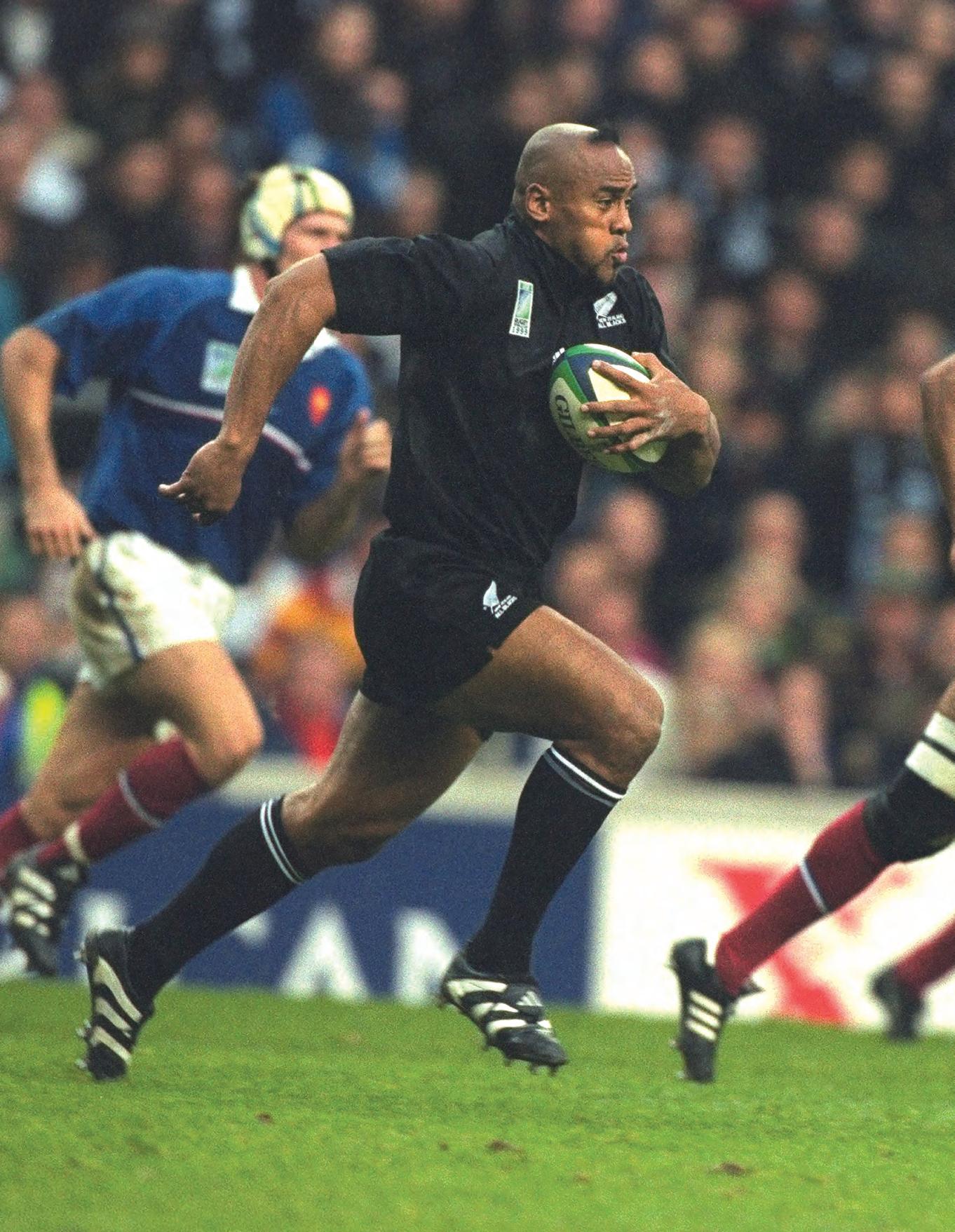

and McDonald’s, which rebranded its McFeast as the Jonah Burger in New Zealand. The NFL, the world’s richest professional sports league, was understood to be keen to tap into Lomu-mania and for a while he was linked with a potential move to the Dallas Cowboys — ‘America’s Team’ — as a one-two punch alongside legendary running back Emmitt Smith.
“ON THE FIELD, LOMU SET THE ATTACKING STANDARD NO OTHER WING COULD EMULATE.”
Yet, despite all his fame and global appeal, when Lomu died aged just 40, it was discovered he was virtually penniless. At his funeral, which was held at Eden Park, the ground where his test career nearly ended after just two appearances, Rush offered the most poignant portrait of his great mate, saying Lomu might have been the most famous player on the planet, but he was also the loneliest.
On the field, Lomu set the attacking standard no other wing could emulate. A schoolboy sensation at No 8, Lomu shifted to the wing at the request of Mains.
“As a loose forward he wasn’t going to be much bigger and certainly not a lot tougher than a lot of the international loose forwards, so his great ability would be nullified to an extent,” Mains says. “But if we were good enough to develop him as a wing, then he could be something the world had never seen and fortunately that was the way it turned out.
“Jonah was the most dangerous rugby player that has played the game, given a little bit of space. He was fast, he could sidestep three metres, or he could go straight over the top of almost anyone and we saw all of that in the semifinal against England at the ’95 World Cup.”
Ahead of his test debut against France, Lomu roomed with Kirwan in Christchurch. The great All Blacks wing preferred not to share his sleeping quarters with forwards and when Lomu knocked on the door the oblivious Kirwan told him he had the wrong room. At 1.96m tall and weighing a muscular 119kg it’s no wonder Kirwan mistook Lomu for the former No 8 he was.
Lomu’s deeds on the field for the All Blacks were indelible, but the raw numbers don’t do him justice. They do, however, show that he was the man for the big stage as 20 of his 37 tries were scored at the 1995 and 1999 World Cups.
After his anonymous start to the tournament in South Africa, a bewildered Lomu soon became the star attraction.
“We were at a shopping mall and a woman asked Sean Fitzpatrick to sign a rugby ball. He had got to about S-E-A when she ripped it out of his hands because she spotted Jonah,” Salizzo says. “No one has transcended rugby like him. Nothing has got close to what happened to Jonah.”
Fitzpatrick, whose legendary career was winding down as Lomu’s was elevating, agrees.
“Jonah Lomu is the only global superstar we’ve had in rugby; there hasn’t been one since and I don’t think there will ever be another player like Jonah. He [went from nobody to icon] in the space of five games — literally five games. When you think about it he shouldn’t have gone to the World Cup, but he came in and totally dominated. By ’96 he had been dropped.”


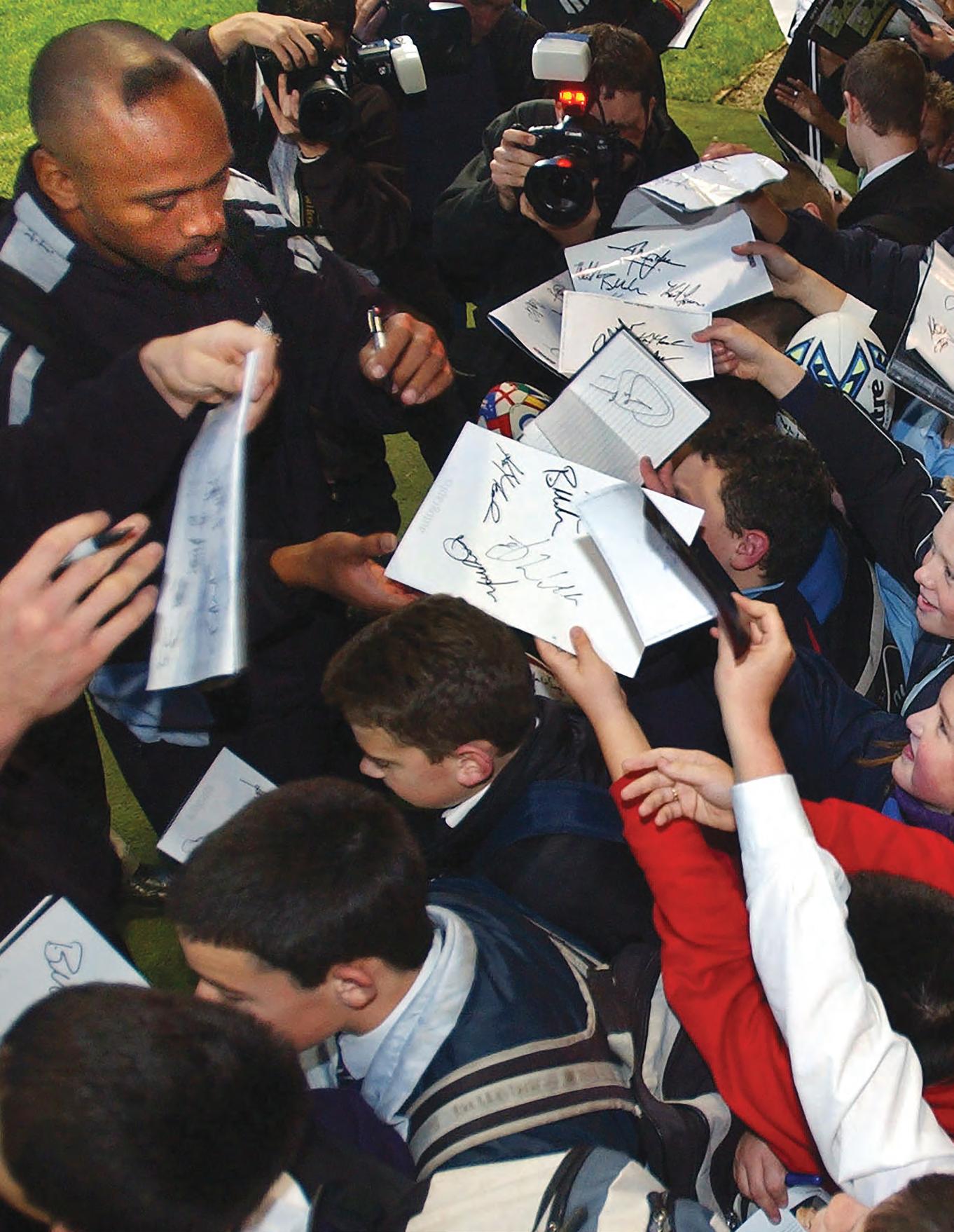

A major reason for that decline was the kidney illness that restricted Lomu’s international career between the 1995 and ’99 World Cups, when he should have been at his peak.
He missed most of the 1997 test season, but did help New Zealand win sevens gold at the 1998 Commonwealth Games, and he was back near his best at the 1999 World Cup in the United Kingdom.
“HE WAS A GLOBAL SUPERSTAR WHO SCORED TRIES THAT NO ONE ELSE WOULD HAVE SCORED, BUT I ALWAYS THINK, JUST WHAT WOULD HE HAVE BEEN HAD HE EVER BEEN TRULY FIT.” – JOHN HART
Even in the infamous semifinal loss to France, Lomu scored two tries and was one of the few All Blacks who enhanced their reputations that day.
By now, John Hart was the All Blacks coach and looking back he cannot help but lament what might have been.
“He was a global superstar who scored tries that no one else would have scored, but I always think, just what would he have been had he ever been truly fit,” Hart says. “We never saw him at his peak. He was at 60, 70, 80 per cent because of his illness. If he had ever been 100 per cent healthy, what would we have seen? We saw a colossus as he was, but I don’t think we have any idea what he might have done.”

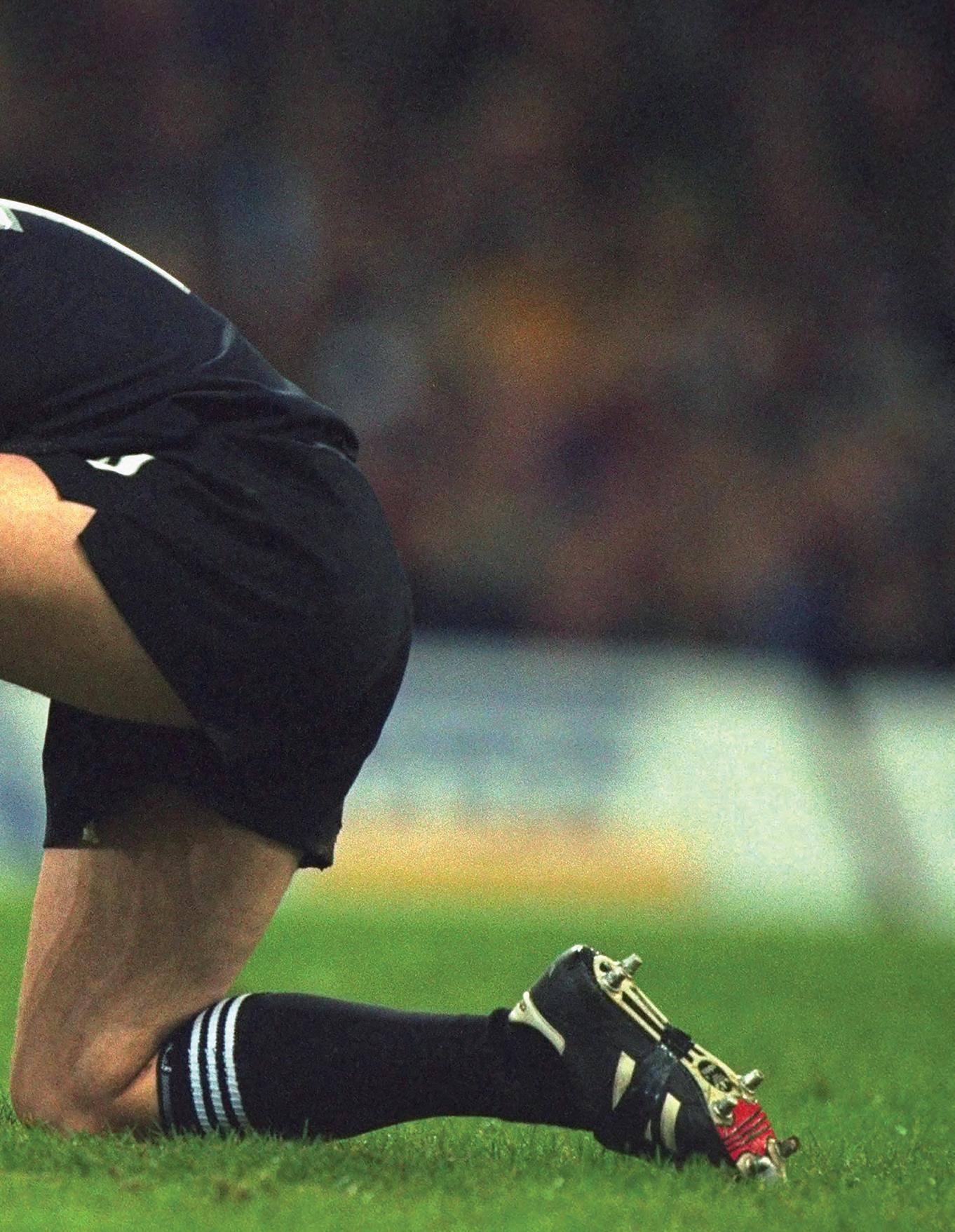
ANDREW MEHRTENS WAS AN EXPRESSIVE PLAYER, ON THE FIELD AND OFF IT, WEARING HIS HEART ON HIS SLEEVE, EVEN WHEN IT GOT HIM IN TROUBLE. HE WAS ALSO ONE HECK OF A PLAYER.
Andrew Mehrtens has always been a maverick.
Who could forget his flipping the bird to the Bulls faithful after a drop goal for the Crusaders at Pretoria’s Loftus Versfeld in 1999. Or, a few years later, when Adidas gave the All Blacks a much-hyped yellow ball to play with against Ireland and Mehrtens dubbed it both a lemon and a pig that wouldn’t fly.
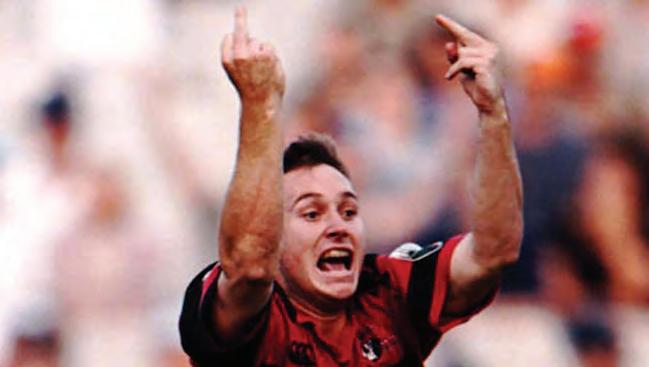
Born 28 April 1973 in Durban, South Africa
All Black 944 All Blacks Test Debut Saturday, 22 April 1995 v Canada at Auckland aged 21 years, 359 days
Test Caps 70
Test Positions
First five-eighth High School
Christchurch Boys’ High Club Christchurch HSOB
For the maligning of a sponsor’s product, he received a ticking off by All Blacks management — they actually tried to stop his quotes from being reported — and the executives at the German sports apparel giants were far from impressed, but Mehrtens was resolute. He knew his way around a decent rugby ball and that wasn’t one.
“The ball is dead. It doesn’t fly and we’ve told them that until we’re blue in the face,” Mehrtens told a couple of intrepid reporters, including this author, the morning after the All Blacks had beaten Ireland 15-6 at Carisbrook in the first of a two-test series in 2002. “The white ball we used in the NPC last year wasn’t too bad. They’ve kept telling us the white and the yellow balls are the same, but they’re not. I’m not using that as an excuse but the ball’s a pig. It’s slippery.”
Team media manager Matt McIlraith tried to stop us using the quotes and later that day manager Andrew Martin called both reporter and editor with the same request.
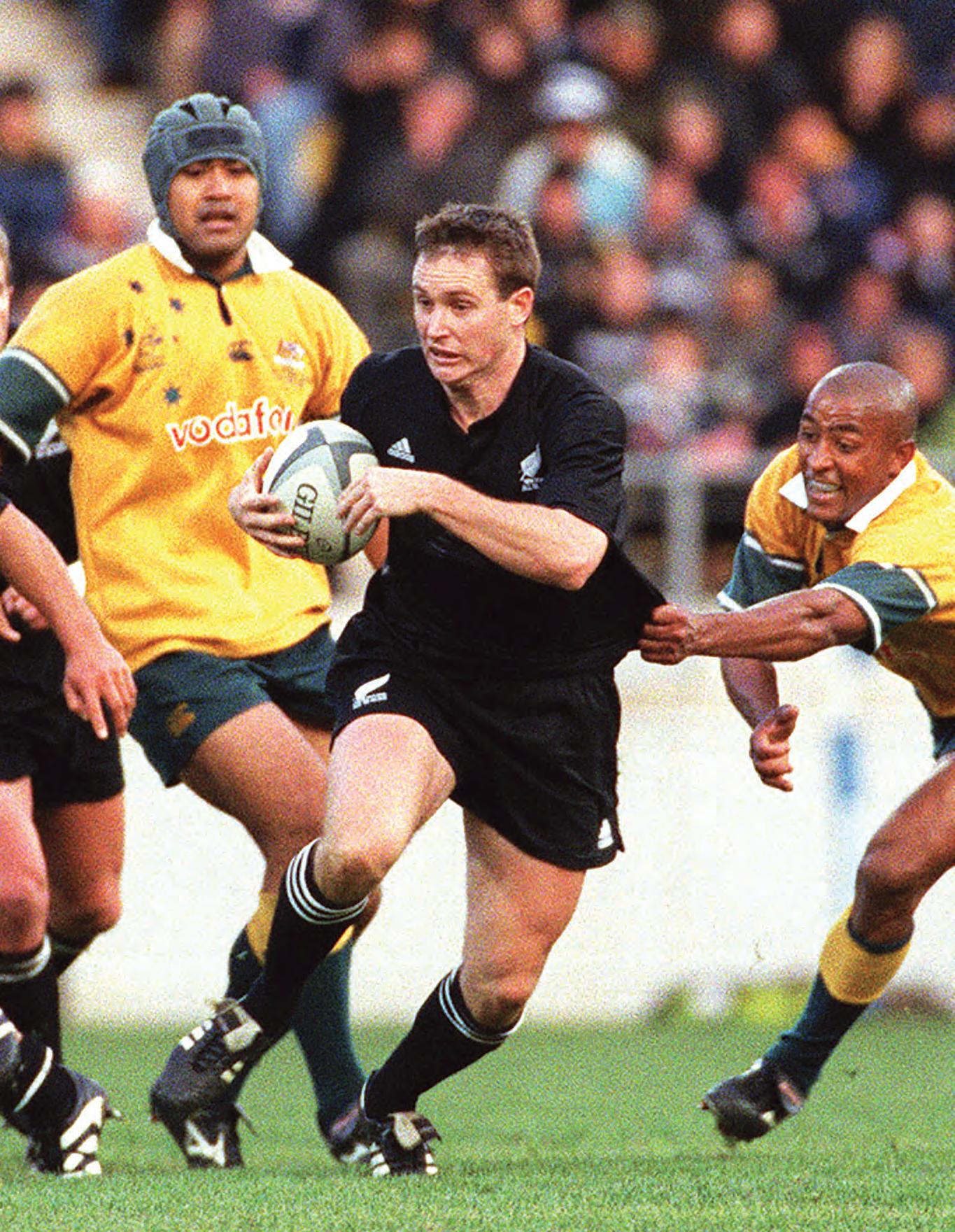

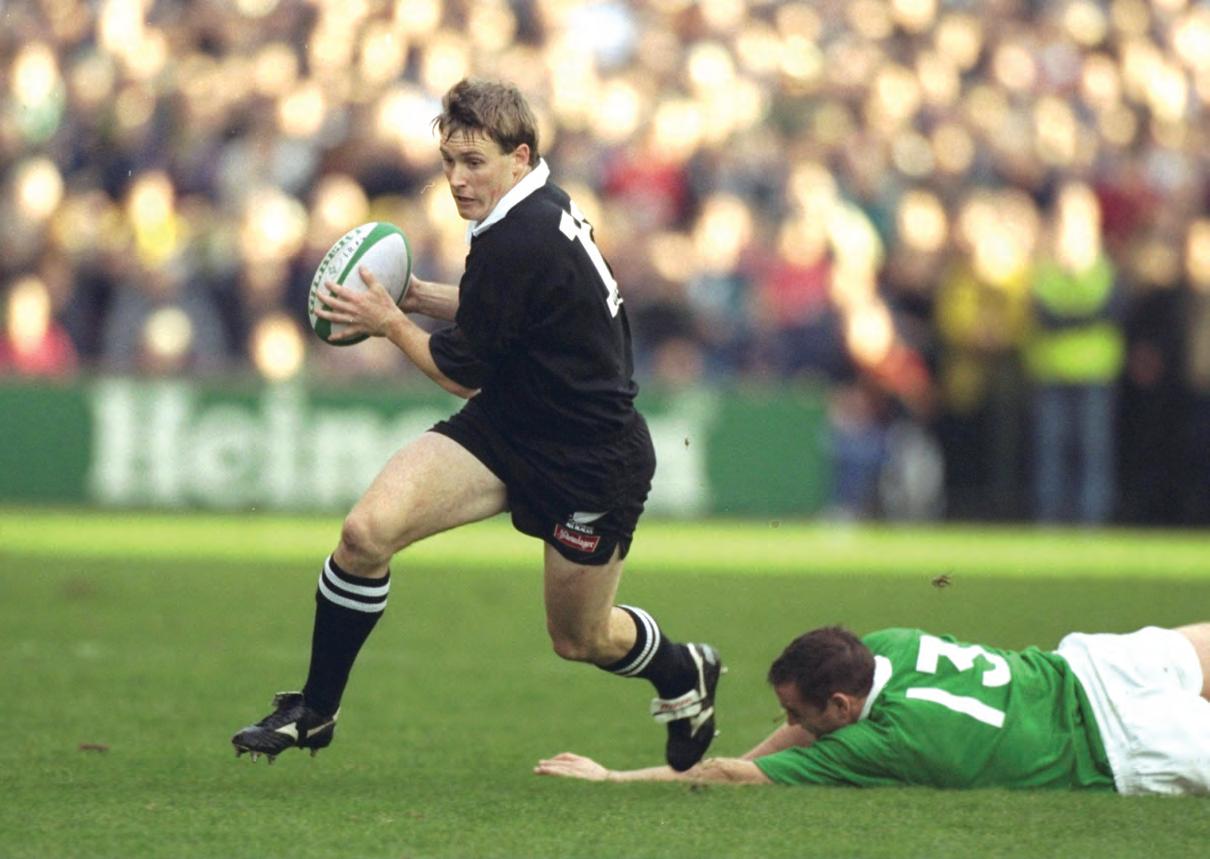
Mehrtens’ comments carried weight. While Adidas suggested the articulate first-five was trying to deflect from a sub-par All Blacks performance, they also sent the match balls away for testing.
The player himself would have chuckled as he watched the story gather momentum. He never stressed too much. He was a gift for journalists of that era because he was one of the few prepared to be open and honest in his media interviews and he wore his heart on his sleeve on the field. You were never short of angles and stories when he was around, which must have driven his more media wary coaches and managers to distraction.
Against the Bulls that day in Pretoria, the Crusaders were under huge pressure and Mehrtens had been copping abuse from the crowd whenever he lined up a kick. So, when the match winning droppie sailed through the posts, he vented with two single-fingered salutes.
Justin Marshall, who played inside Mehrtens for Canterbury, the Crusaders and All Blacks, says one of his mate’s greatest strengths was his ability to deal with pressure — to ignore the weight of the occasion.
“When the pressure was on he wasn’t fazed by it and didn’t make panicked decisions. Mehrts would think so quickly that he always made the right decision to get himself out of trouble, or to get us into the right area of the field. That’s uncoachable. I’ve never seen a player with his time and awareness.”
The great Colin Meads once dubbed Mehrtens a “cheeky little bastard” but he almost wasn’t afraid to tell all who would listen that he thought he was the best first fiveeighth New Zealand had produced. There was indeed, underneath all the wit and wisecracks, a serious side to Mehrtens the rugby player.
“He was a larrikin, he liked to have a bit of fun, but when he walked onto the pitch he was green for go,” Steve Hansen says.
Born in South Africa while his parents were there on a working holiday, Mehrtens had a strong pedigree. His grandfather, George, played for Canterbury in the 1920s as a fullback and was an All Black in unofficial internationals against New South Wales in 1928. His father, Terry, also a first-five, represented Canterbury between 1964 and 1976, was a New Zealand under-23 player, and while living in South Africa played as a fullback for Natal against the 1970 All Blacks.

It was therefore fitting that Mehrtens, with just one test against Canada in Auckland under his belt, truly burst onto the international scene in South Africa at the 1995 World Cup, alongside fellow newbies Jonah Lomu and Josh Kronfeld. Mehrtens had an outstanding tournament, but as we all know history is written by the winners and what he’ll best be remembered for is missing a match-winning attempt at a drop goal in normal time, while his opposite Joel Stransky nailed his in extra time.
It was the high point of Stransky’s career, while Merhtens kept growing his legend across 70 tests and 967 points.
“The timing was right for him,” says Jeff Wilson. “He was a confident young man with a great skill set, good athlete, great speed and a great kicking game as well. He played on instinct. If the best option was to run, he would take that and he had great fast hands so as a teammate you had to be ready to react because he had the ability to change the game in a second.”
One thing Mehrtens was not renowned for was his defence. All Blacks coach Scott Robertson often jokes that playing alongside him for Canterbury and the All Blacks boosted his tackle count as he had to make the first-five’s as well. If he was poor on defence, Mehrtens was a genius with the ball and his speed allowed him to ghost across the field before straightening either to take the gap himself or put someone else in it.
Hansen first coached Mehrtens at club level in Christchurch and vividly remembers chatting with the 18 year old on his front porch about how he would cope in a team full of seasoned men.
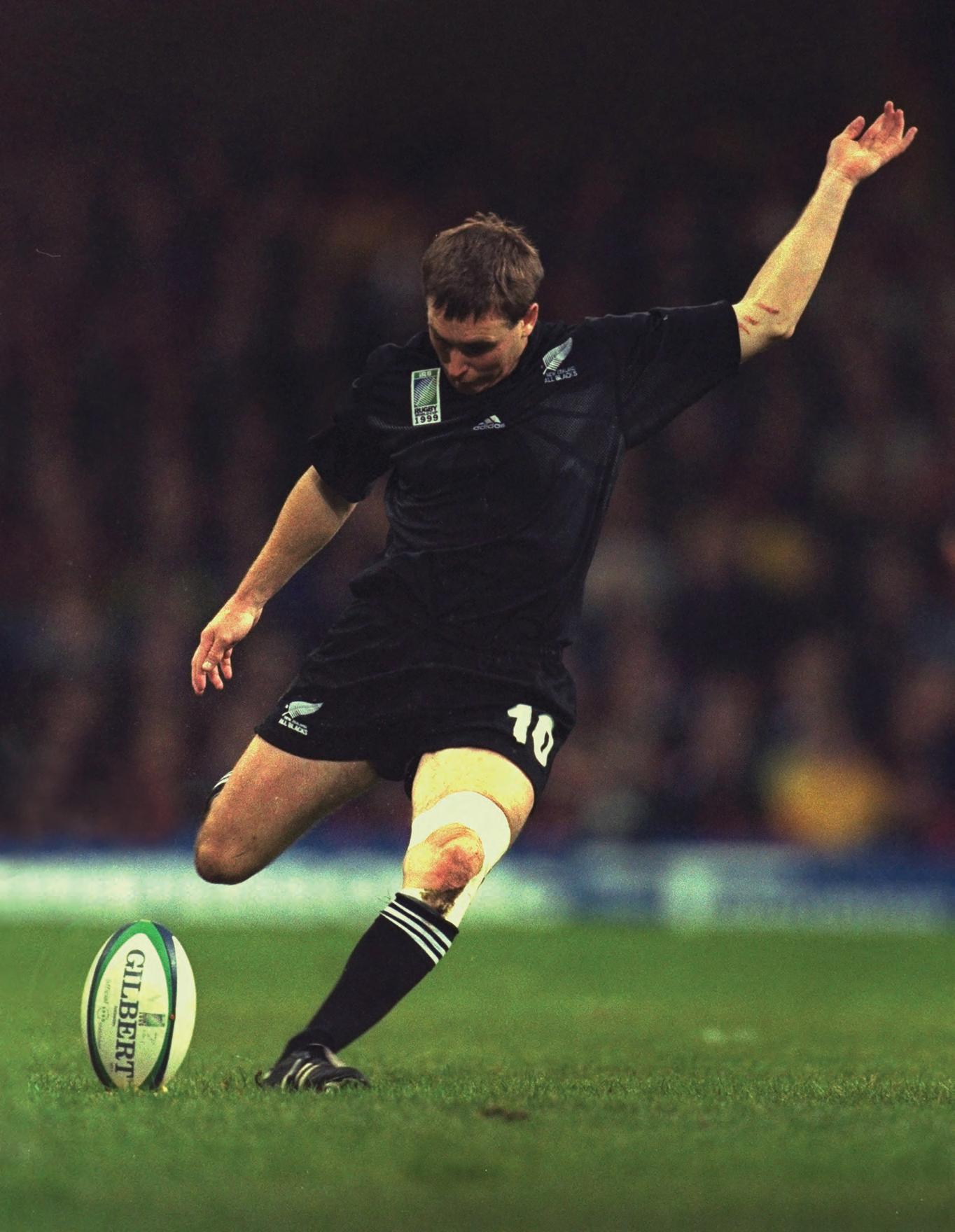
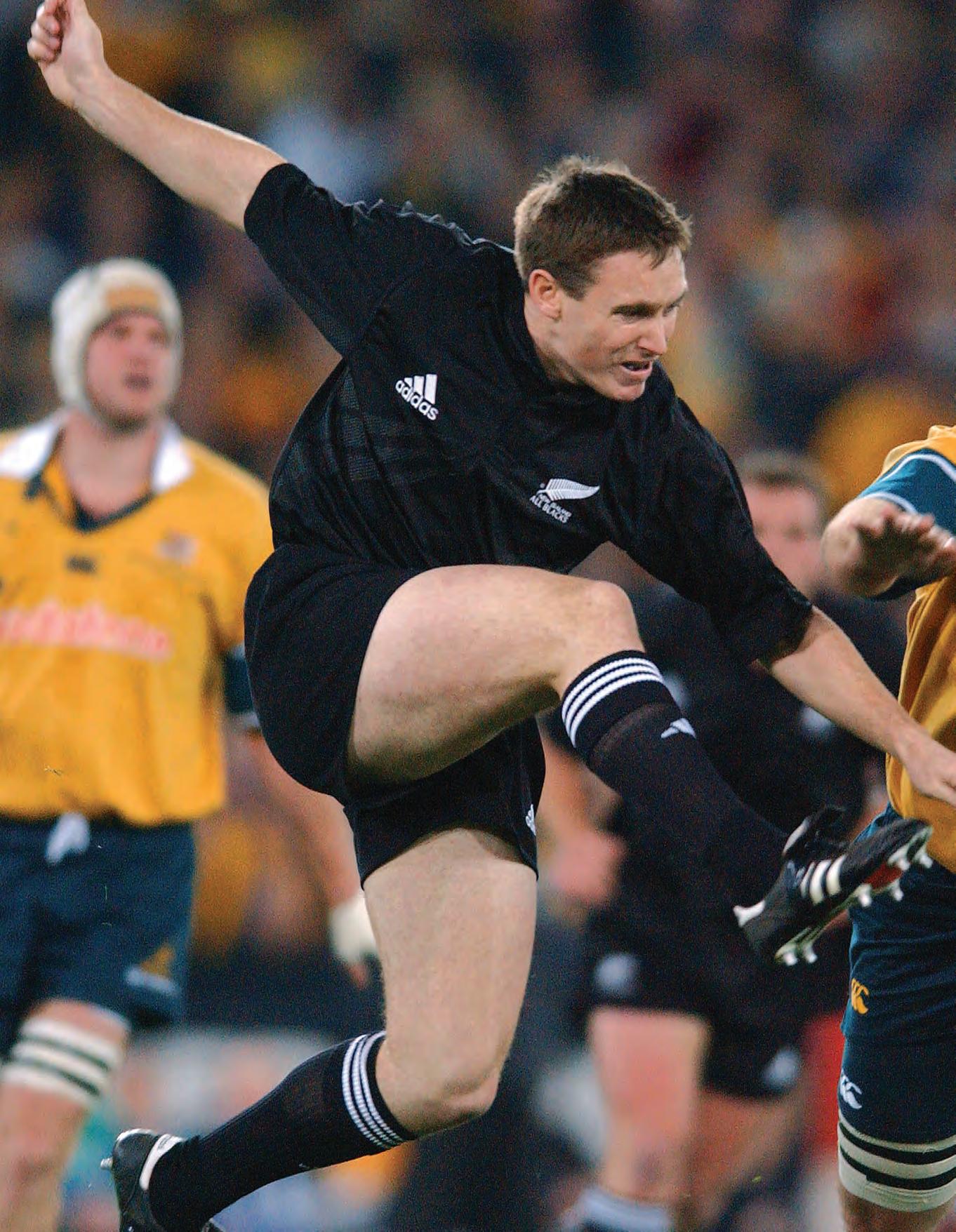

“I wasn’t sure that he could lead the team because he was only a baby and I’ll never forget he said, ‘I’ll run the team Steve, don’t worry about that’. He wanted to be in charge, doesn’t matter what it was,” Hansen says. “If you were playing a game of cards he wanted to be in charge, if you were doing the dishes he wanted to be in charge. That’s one of the things that made him a great player, but he also had the time and space to play a game of footy that at that time no one else could play.
“His passing game was unbelievable. He could throw the ball 25 metres and put it on a dime and his kicking game was great. He certainly changed the game. Grant Fox was a great player but he didn’t have Mehrts’ running game. Carlos had the running game but he didn’t have the same tactical nous as Mehrts. He was a combination of both Foxy and Carlos and that is a rare commodity — and he had a massive influence on the next guy, who was Dan Carter.”
Mehrtens enjoyed huge success with Canterbury (scoring 1056 points across 108 games) and the Crusaders (87 games, 990 points), and saw off three strong contenders in Carlos Spencer, Tony Brown and Simon Culhane, who played 59 tests between them, to be the regular first-choice No 10 for most of his time as an All Black.
After he stopped playing in New Zealand, Mehrtens had stints with Harlequins in England and Toulon, Racing Metro and Beziers in France. Since retiring, Mehrtens has lived mainly in Australia and has been a kicking coach for the Waratahs. His intelligence and wit means Mehrtens is a popular after-dinner speaker and he has enjoyed regular work as a pundit on Australian television where, it should surprise nobody, he likes to crack a joke from time to time and treats the game as something less than a life-or-death matter.
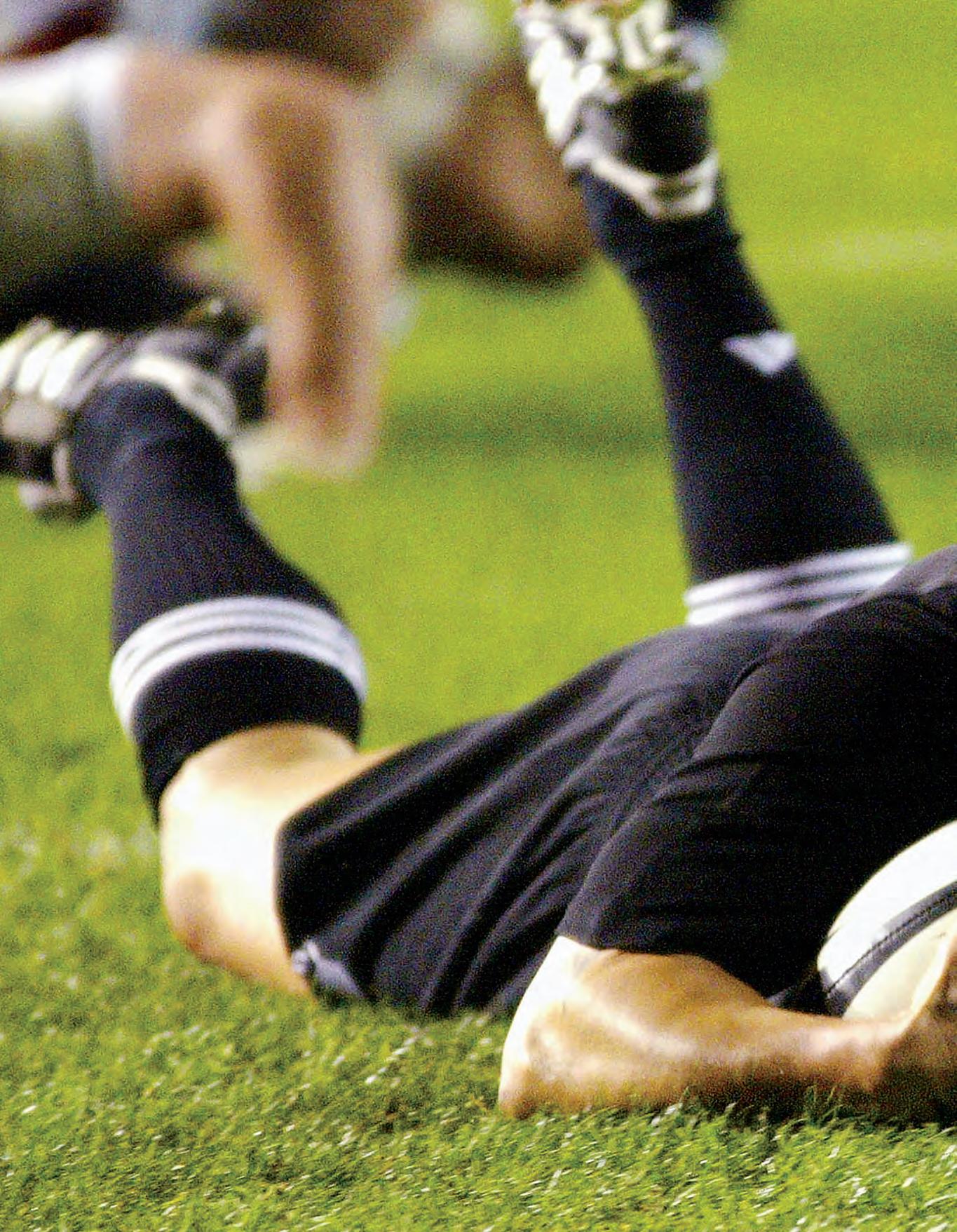
CARLOS SPENCER WAS A SCHOOLBOY PRODIGY WITH A RANGE OF SKILLS AND BAG OF TRICKS THAT HIS FANS LOVED AND DETRACTORS DETESTED.

Born 14 October 1975 in Levin, New Zealand
All Black 951 All Blacks Test Debut Saturday, 21 June 1997 v Argentina at Wellington aged 21 years, 250 days Test Caps 35 Test Positions First-five High School Waiopehu College Club Ponsonby
It has become something of an iconic YouTube clip — and it got veteran radio broadcaster Brian Ashby into hot water.
Playing for the Blues at Christchurch’s Lancaster Park, Carlos Spencer caught a pass on his line with two Crusaders players bearing down on him. Spencer threw a long pass across the front of the posts to wing Joe Rokocoko, who launched a daring break out before passing to Justin Collins. The flanker in turn found Spencer on his shoulder, who proceeded to race toward the Crusaders’ posts for a stunning try.
Except he didn’t put the ball down straight away, as is customary. Spencer instead trotted to the corner, where he placed the ball just inside the deadball line, then kicked the conversion from out wide and sealed the deal by flipping the finger to an infuriated and febrile Christchurch crowd.
It was vintage, swaggering Spencer, but as he ran toward the sideline, Ashby, calling the game on Radio Sport, let rip.
“I think I said something along the lines of, ‘He’s been superb tonight but now he’s behaving like an absolute dickhead’,” Ashby says, recalling the 2004 Super 12 game won 38-29 by the visitors. “I reasoned at the time that giving himself a sideline conversion wasn’t the best idea. Just a few months earlier, he’d had the goal kicking yips at the World Cup. Had he missed on this night, the Crusaders would’ve secured a bonus point which could’ve proved crucial later in the season.
“He nailed it beautifully.”
Ashby was given a ticking off by his boss, talk-radio legend Bill Francis, who told him that it wasn’t appropriate language in a commentary. Ashby stands by the rationale for his outburst, however, and for balance adds that he was critical of the crowd throughout the match for their boorish behaviour toward Spencer. Fair comment or not, it wouldn’t have bothered Spencer who delighted in winding up opposition crowds as much as he enjoyed running at tiring forwards.
Spencer was a polarising figure whose maverick play thrilled his fans, who dubbed him King Carlos, but infuriated those who thought he was a show pony. While he had fans and detractors in all corners of the country, as a general rule the bulk of the first group lived in Auckland while the second group resided in the South Island — and Canterbury in particular.
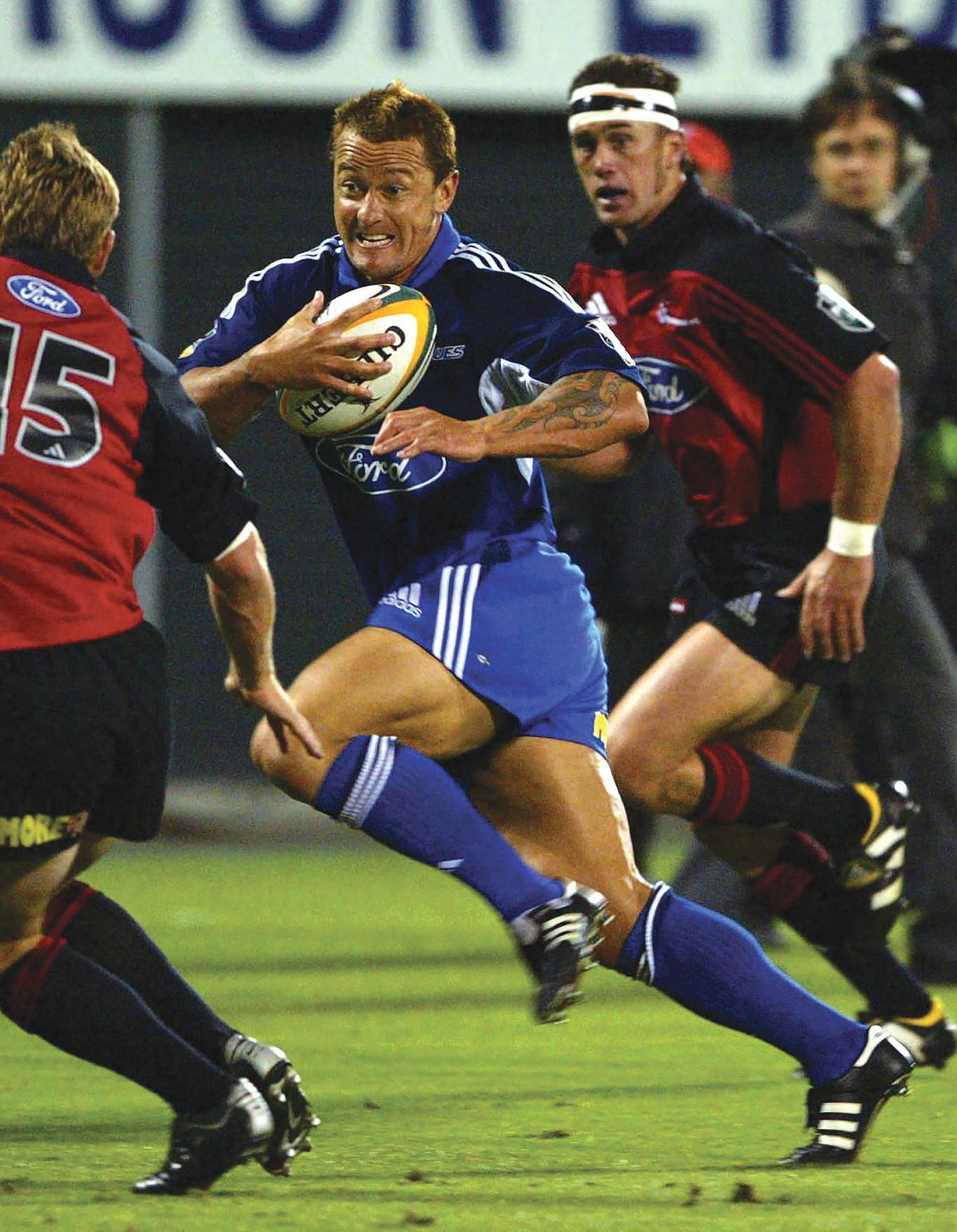


Exacerbating matters was the fact that he was in a battle for the All Blacks first five-eighth slot with Canterbury’s favourite son, Andrew Mehrtens, and Otago’s cult-hero Tony Brown.
Never outwardly short of confidence — he starred, topless and rippling with muscles, in a Toffee Pops commercial — Spencer was ahead of his time when it came to flair on and off the field. He delighted his fans with a dazzling array of skills that included corkscrew kicks, using his knee or thigh to chip and chase, through-the-legs passes and passes to himself that dumbfounded defenders. He also retained a canny ability to isolate lumbering tight forwards to run at.
Jeff Wilson says much of what Spencer did was far
from the orthodox or the percentage play but it was his confidence to have a crack, even in the All Blacks, that made him so special.
“If it comes off, fantastic, but if it doesn’t you have to live with the consequences and that was Carlos — he was always happy to live with the consequences because he had worked on it so much that it was a calculated risk.”
Spencer’s daring play was almost a push back against the hyper-analysis and structured play that came in with professionalism.
“We went from planning two or three phases to five or six, so the play was a lot more patterned and players knew the areas they had to be in,” says former Crusaders
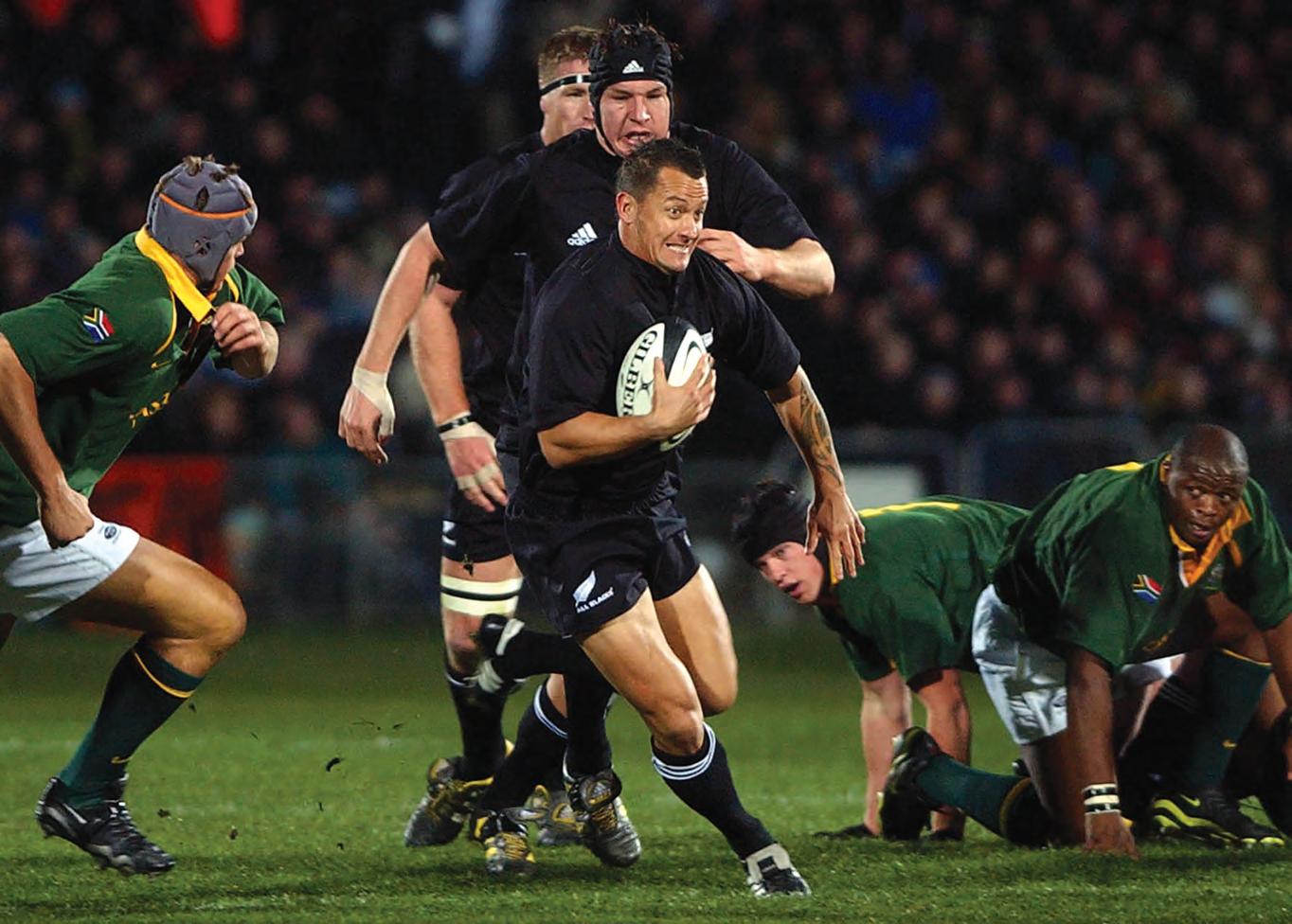
“IF
IT COMES OFF, FANTASTIC, BUT IF IT DOESN’T YOU HAVE TO LIVE WITH THE CONSEQUENCES AND THAT WAS CARLOS — HE WAS ALWAYS HAPPY TO LIVE WITH THE CONSEQUENCES BECAUSE HE HAD WORKED ON IT SO MUCH THAT IT WAS A CALCULATED RISK.”


and All Blacks halfback Justin Marshall. “Within those patterns, if Carlos saw something, he would take it. If he saw a defender he could beat, he would take him on and I would always feel sorry for the forwards he preyed upon.
“He was happy to gamble on his skills and his skill set was off the Richter scale. His ability to pass pre- or post-contact off either hand, one-handed offloads, and his ability to see who was coming at him and use those around him — he was a genius at that.”
“HE WAS HAPPY TO GAMBLE ON HIS SKILLS AND HIS SKILL SET WAS OFF THE RICHTER SCALE.”
Yet his cavalier style didn’t always impress the selectors at the international level. Spencer played 35 tests to Mehrtens’ 70, despite them both making their debuts for the All Blacks in 1995, and playing their final tests in 2004.
Mehrtens was seen as the more solid option: less flighty, a better positional kicker and thus better able to drive a game and construct wins. Or so conventional wisdom suggested, except that Spencer’s test win rate of 77 per cent was higher than Mehrtens’ 70 per cent.
Spencer’s prodigious talents were recognised early. He made his first-class debut for Horowhenua aged just 16 and while still a pupil at Levin’s Waiopehu College. A year later he scored a spectacular try against Auckland when the blue-and-whites took the Ranfurly Shield on tour and coach Sir Graham Henry was quick to lure him north.
“HE HAD THE ABILITY TO PLAY FLAT, HE HAD THE HANDS AND THE PASS AND THE SKILL LEVEL TO PLAY IN THE TRAFFIC AND CREATE OPPORTUNITIES NOT ONLY FOR HIMSELF, BUT FOR OTHERS. HE HAD THAT CHEEKINESS.”
– GRAHAM HENRY
“He was a genius. I don’t think he knew he was a genius and I don’t know if he always knew what he was doing, but what he did was fantastic,” Henry says. “He had the ability to play flat, he had the hands and the pass and the skill level to play in the traffic and create opportunities not only for himself, but for others. He had that cheekiness.”
Henry says the Lancaster Park try that riled up the locals, including Ashby, should have been scored under the posts instead of the corner flag. “But that was Carlos. He just loved playing in the big environment, with a big crowd. That was his stage, he was an actor, and he loved it and there were not many better.”

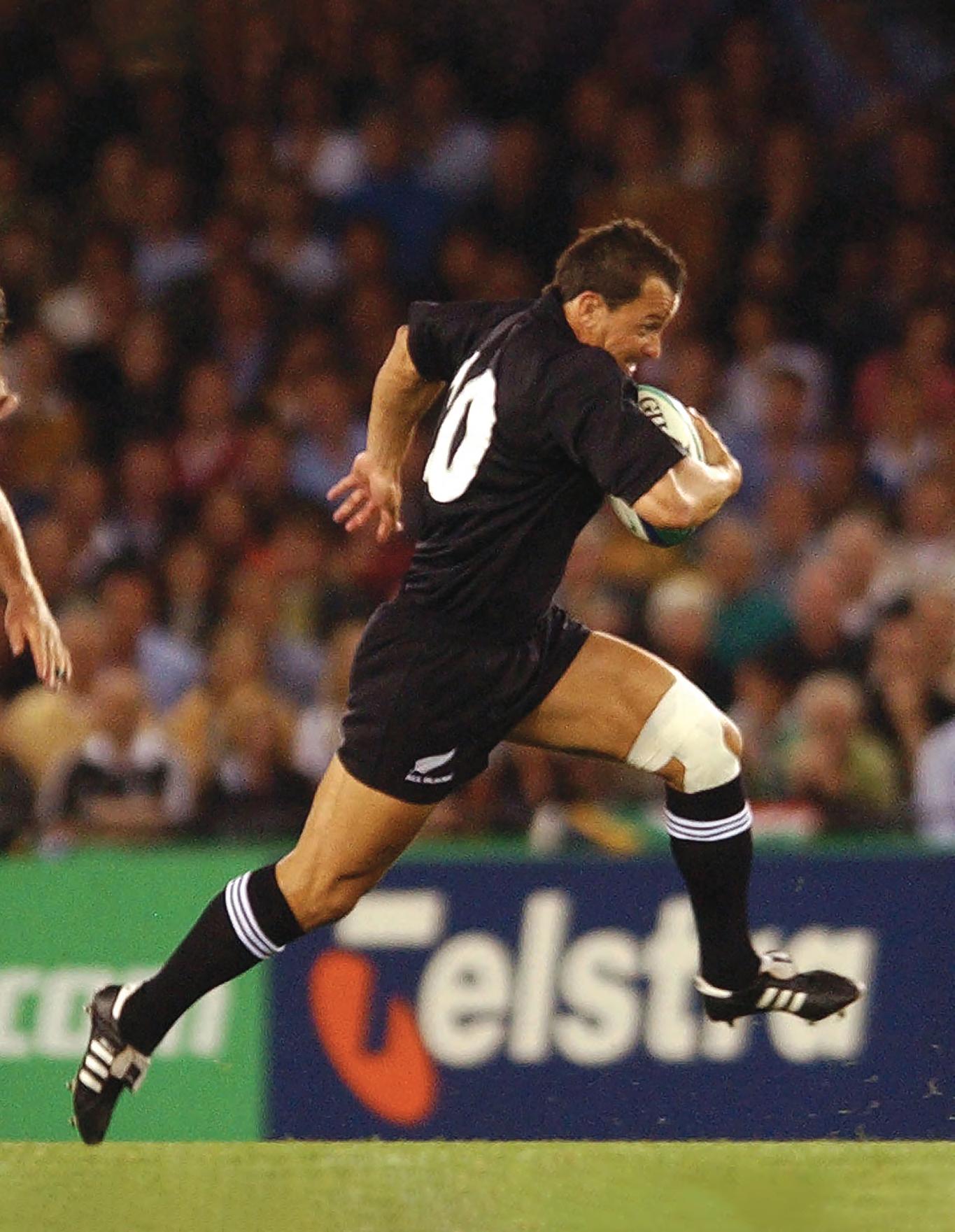

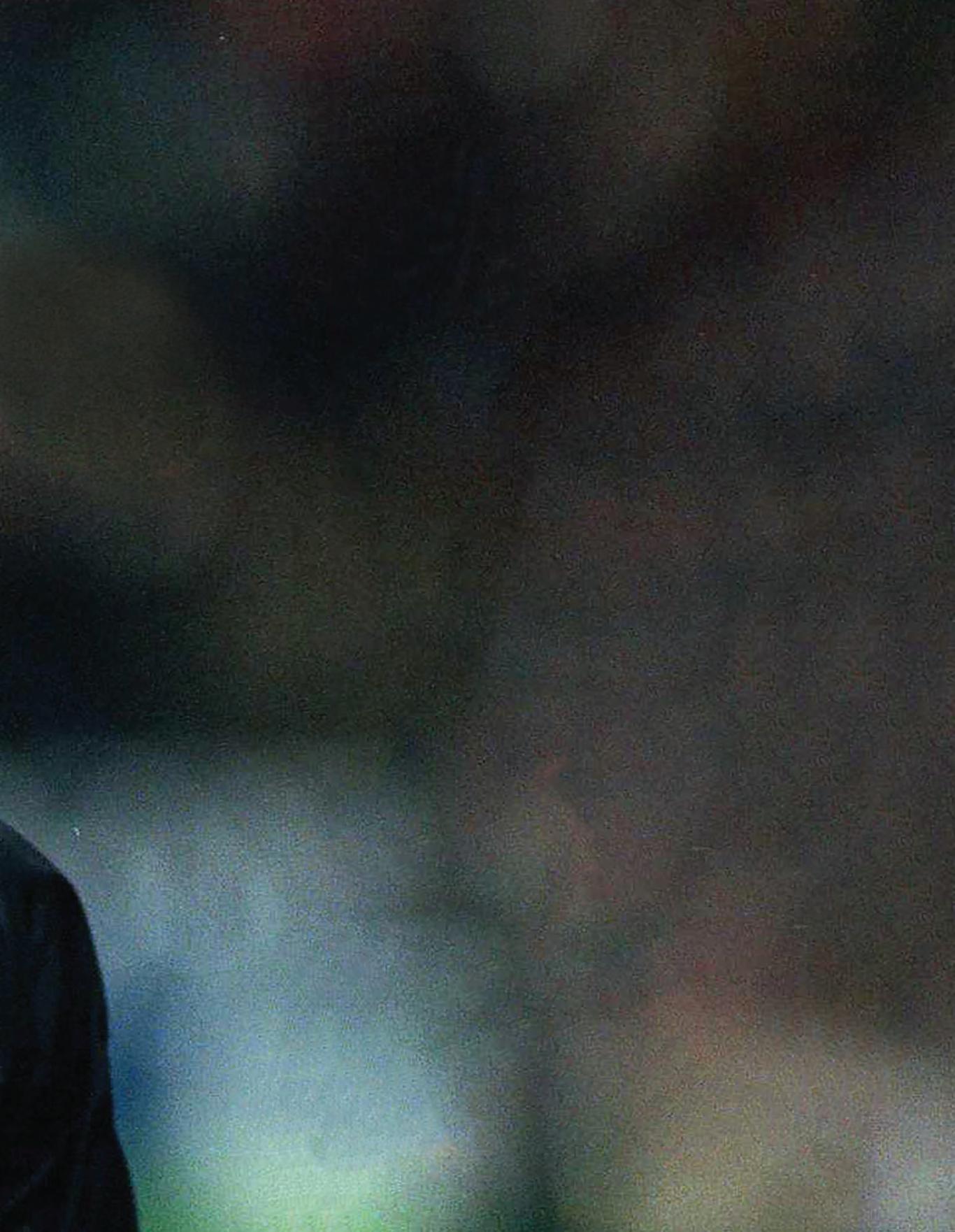
AN EXCITEMENT MACHINE, CHRISTIAN CULLEN COULD CHANGE DIRECTION WITHOUT BREAKING STRIDE AND IN DOING SO, RAN RINGS AROUND DEFENDERS, AND HIMSELF INTO THE PANTHEON OF GREATS.
Such was Christian Cullen’s iconic status, it is difficult to reconcile the fact that by the standards of today’s legends, his test career was relatively brief. It is also crazy to think that the fullback who used to run past and around defenders while scoring tries for fun, never got to play a full World Cup campaign in the No 15 jersey.
Dubbed the Paekākāriki Express by the Evening Post’s rugby correspondent David Ogilvie, there was no great mystery behind Christian Cullen’s nickname; nothing cryptic that required code breaking.
“I called him that because he was fast and he came from Paekākāriki,” says Ogilvie, who penned the line as Cullen emerged as a free-running fullback in the mid-90s.
From there it took on a life of its own, with a sign erected in his honour at the train station in the small Kapiti Coast town north of Wellington.

Christian Cullen
Born 12 February 1976 in Paraparaumu, New Zealand
All Black 952 All Blacks Test Debut Friday, 7 June 1996 v Samoa at Napier aged 20 years, 116 days Test Caps: 58 Test Positions
Fullback, centre, wing High School Kapiti College Club Kia Toa
Cullen also had a standardbred horse named after him and the four-legged version was a champion in his own right, winning 22 of 31 starts and reaping prize money of $1.25 million. After winning the New Zealand Cup in 1998 with a typically dominant front-running performance the commentator remarked that “in a galaxy of stars, he’s the brightest of all”, and the same might have been said of his rugby namesake, though Cullen the man was very much a thoroughbred.
“He was limitless in his attacking ability,” says Jeff Wilson who would shift from fullback to the wing to accommodate Cullen in the All Blacks. “There was nothing, if you gave him the ball, that he couldn’t do. He was powerful, dynamic, had a fantastic sidestep, was incredibly fast and his fend was strong.
“He added this electricity to the game and the moment it was time to go, he was gone. He didn’t hesitate. He never second guessed himself. He wanted to run, he didn’t want to kick.”


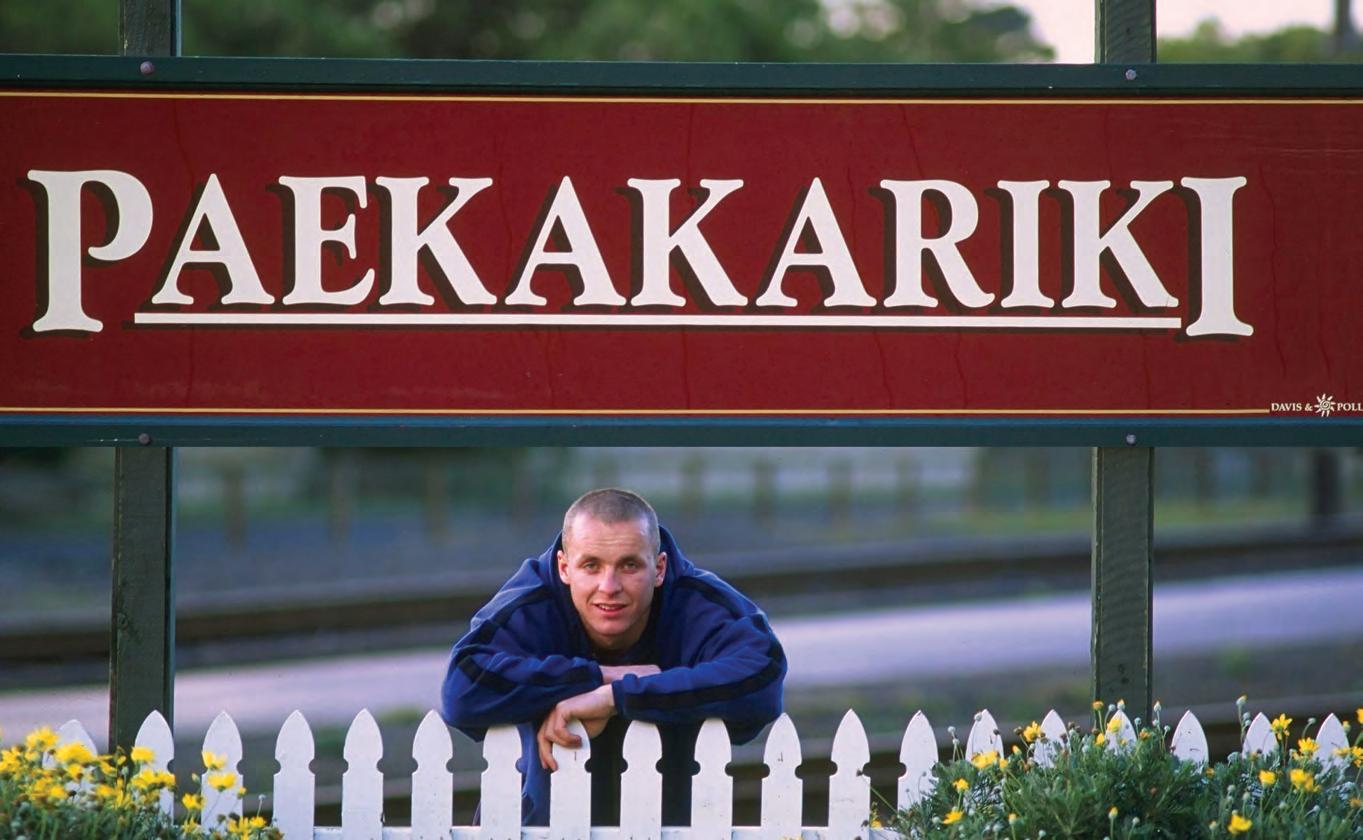
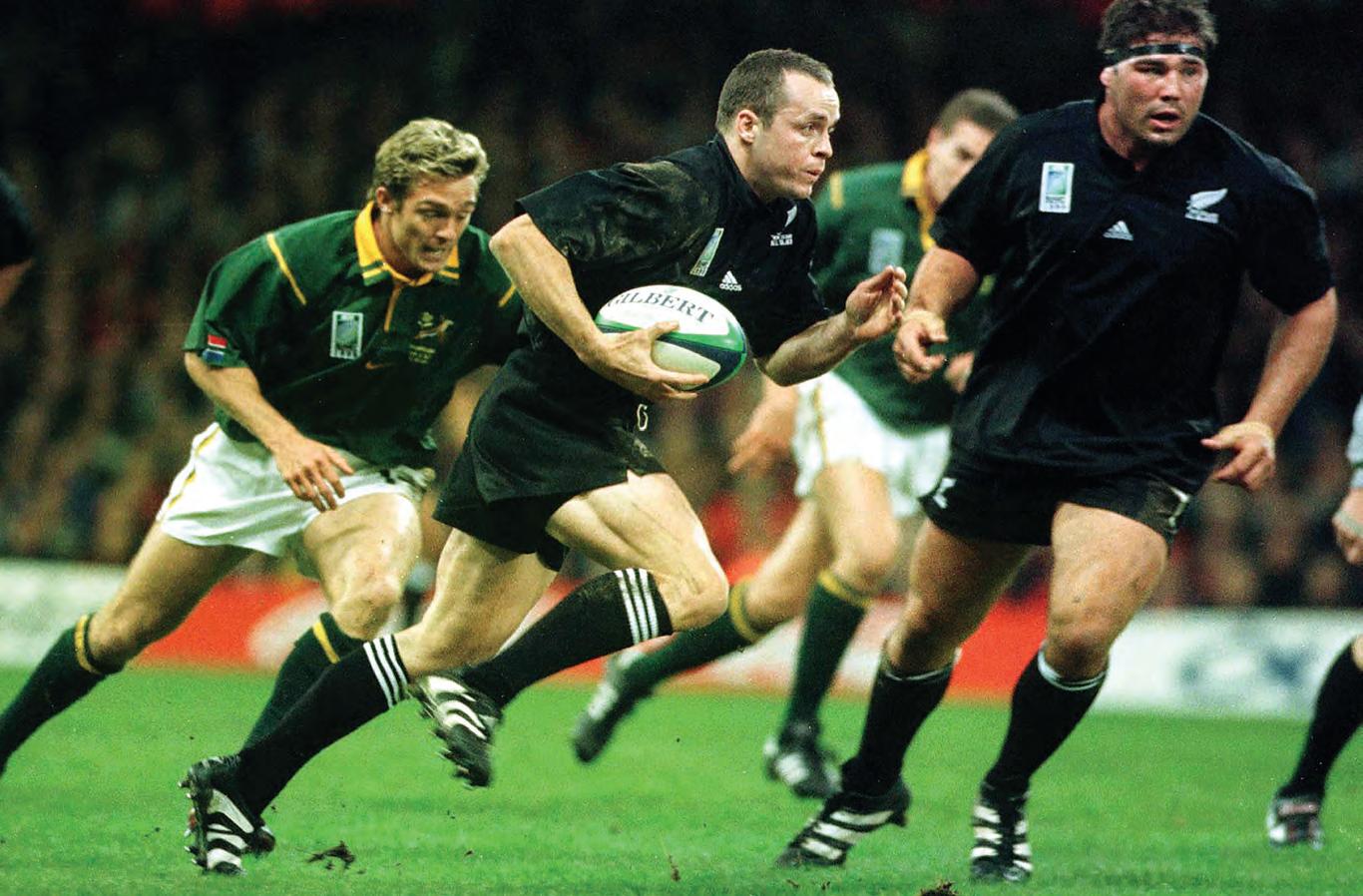
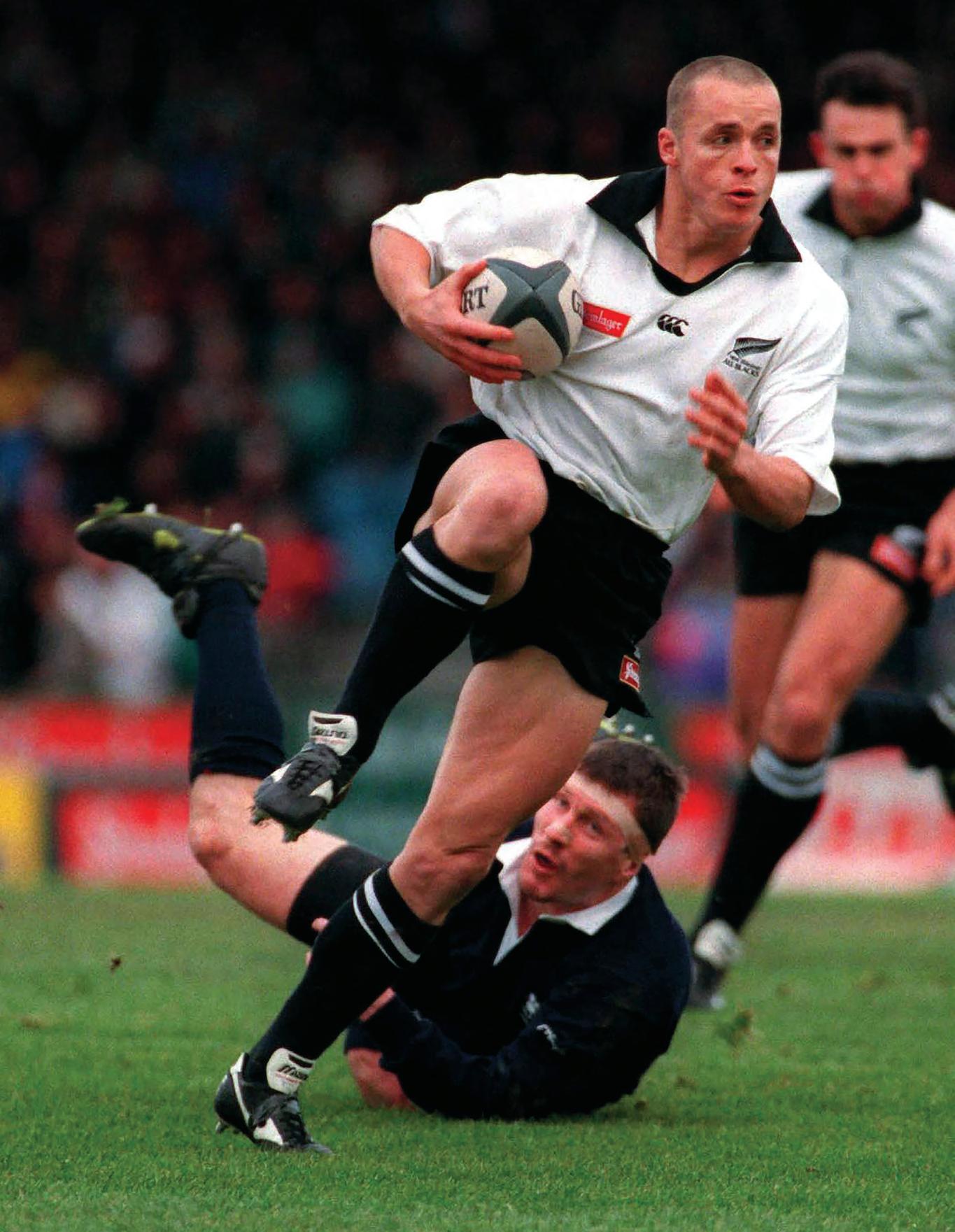

It is that last comment that set Cullen aside from all other fullbacks and was such a large part of how he changed not only the way fullbacks played, but how the All Blacks attacked. The template had been to kick for territory, but Cullen preferred to run there.
“We hadn’t seen that before,” Cullen’s All Blacks skipper Sean Fitzpatrick says. “A player running those sorts of lines — he changed our attack and when we demolished Scotland at Carisbrook in 1996, a lot of that was down to him.”
Cullen scored four tries that afternoon, the first a remarkable effort where he beat his marker on the outside then chopped his way back infield with a series of rightfoot sidesteps. When he dotted down he had either beaten or shrugged off seven would-be tacklers. To prove he was no one-trick pony, his second try saw him execute two massive left-foot steps that left defenders grasping at shadows. All this came a week after he had scored three tries on debut against Samoa in Napier, a test notable for being the first played at night and outside New Zealand’s four main centres.
Night rugby became a permanent fixture as did Cullen, scoring tries for fun as he notched 46 in 58 tests, and more than 150 in a first-class career that spanned more than 200 games.
The All Blacks have had plenty of prolific try-scoring fullbacks, with John Gallagher, Wilson and Glen Osborne featuring before Cullen came along, while Mils Muliaina, Leon MacDonald and Ben Smith were exceptional attacking fullbacks who followed in his wake.
“TO PROVE HE WAS NO ONE-TRICK PONY, HIS SECOND TRY SAW HIM EXECUTE TWO MASSIVE
It was where Cullen launched his attacks from, however, and his ability to change angles without slowing down, that set him apart.
Those talents were well known in the age-group system, despite Cullen attending his local Kapiti College, which was not a noted rugby nursery. He made his first senior appearance at the 1995 Hong Kong Sevens, back then the gold-standard tournament for the truncated version of the game, and although he scored a try in his first game, he spent the rest of the tournament watching from the sidelines as New Zealand went on to win.
The following year it was a different story, with Cullen scoring 18 tries and marking himself down as a young man for the big occasion when creating a breathtaking try from difficult circumstances in the final against crowd favourites Fiji. With New Zealand under pressure from a sloppy lineout on their line, Bradley Fleming shovelled the ball under pressure to Cullen, who caught it deep in his in-goal. Cullen cut against the grain, skirting the dead-ball line while escaping the attentions of
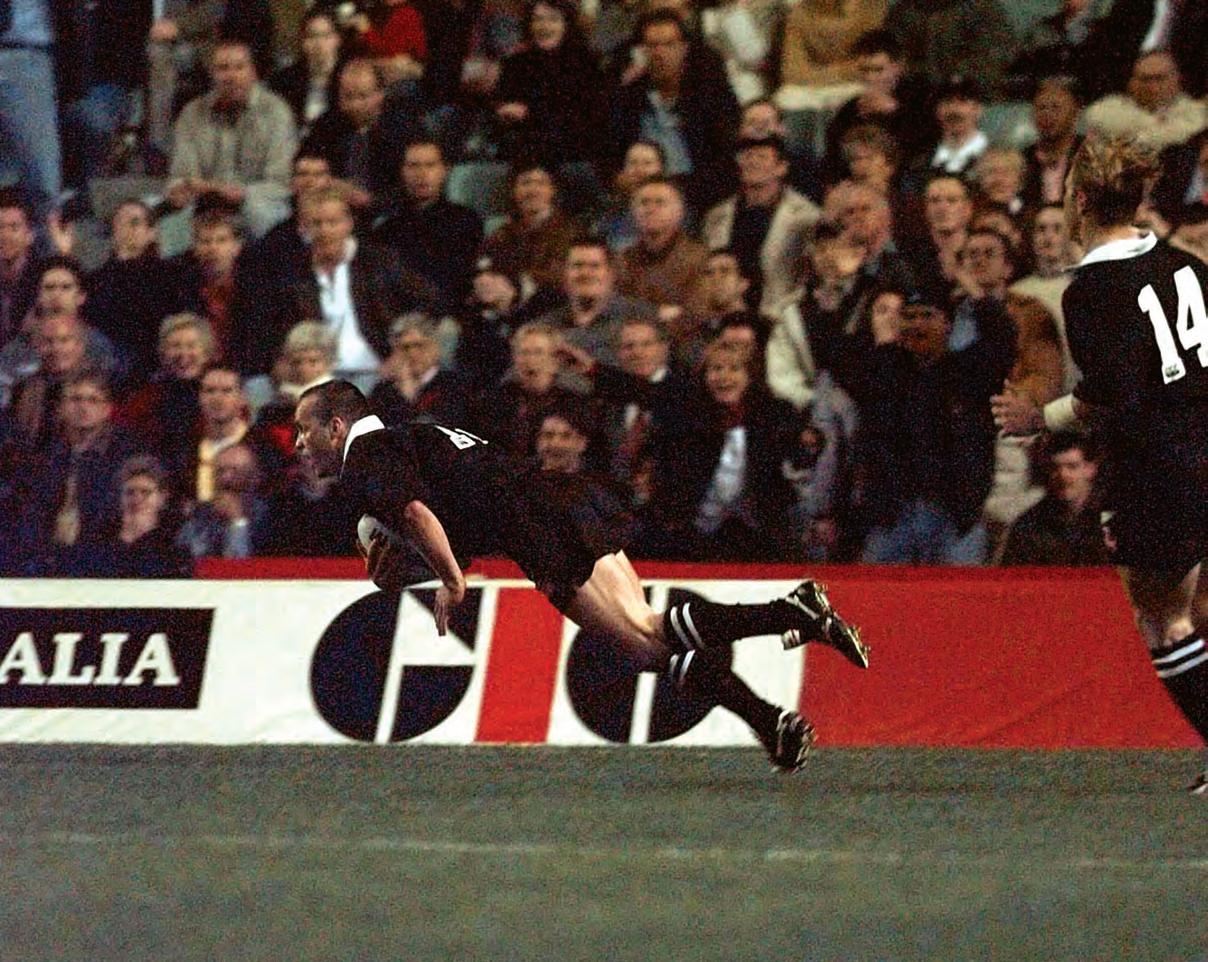
three Fijian defenders, before surging clear through the posts and passing to Waisake Masirewa who had no one between him and the try line. New Zealand would go on to win the final 19-17 in controversial circumstances when Fiji were not given the opportunity to restart after scoring a late try.
“That’s my favourite try that I never scored,” Cullen says.
Cullen debuted for the All Blacks later that year, bringing those attacking instincts he nurtured in sevens to the 15s game. He had made his first-class debut for HorowhenuaKapiti against a touring Transvaal side two years earlier, before shifting north to Manawatu for three years, the final one as part of the short-lived Central Vikings concept, before settling in Wellington from 1998.
As freakish as Cullen was, he was helped by having great attacking players like Jonah Lomu, Tana Umaga and Wilson around him, the first two at Wellington and the Hurricanes, and all three at the All Blacks. The help was reciprocal. On one memorable night in New Plymouth in 2000, the Hurricanes thrashed the Reds 43-25 despite seeing little of the ball. Cullen assisted Umaga to a hat-trick and scored himself, while Lomu also crossed for a try.
Few can forget, also, the ‘Game of the Century’ against the Wallabies in Sydney later that year, when the All Blacks raced to a 21-0 lead with Umaga scoring after two minutes, Pita Alatini from the following kickoff and Cullen in the fifth minute. Lomu scored the match winner on full time after a remarkable Wallabies comeback.
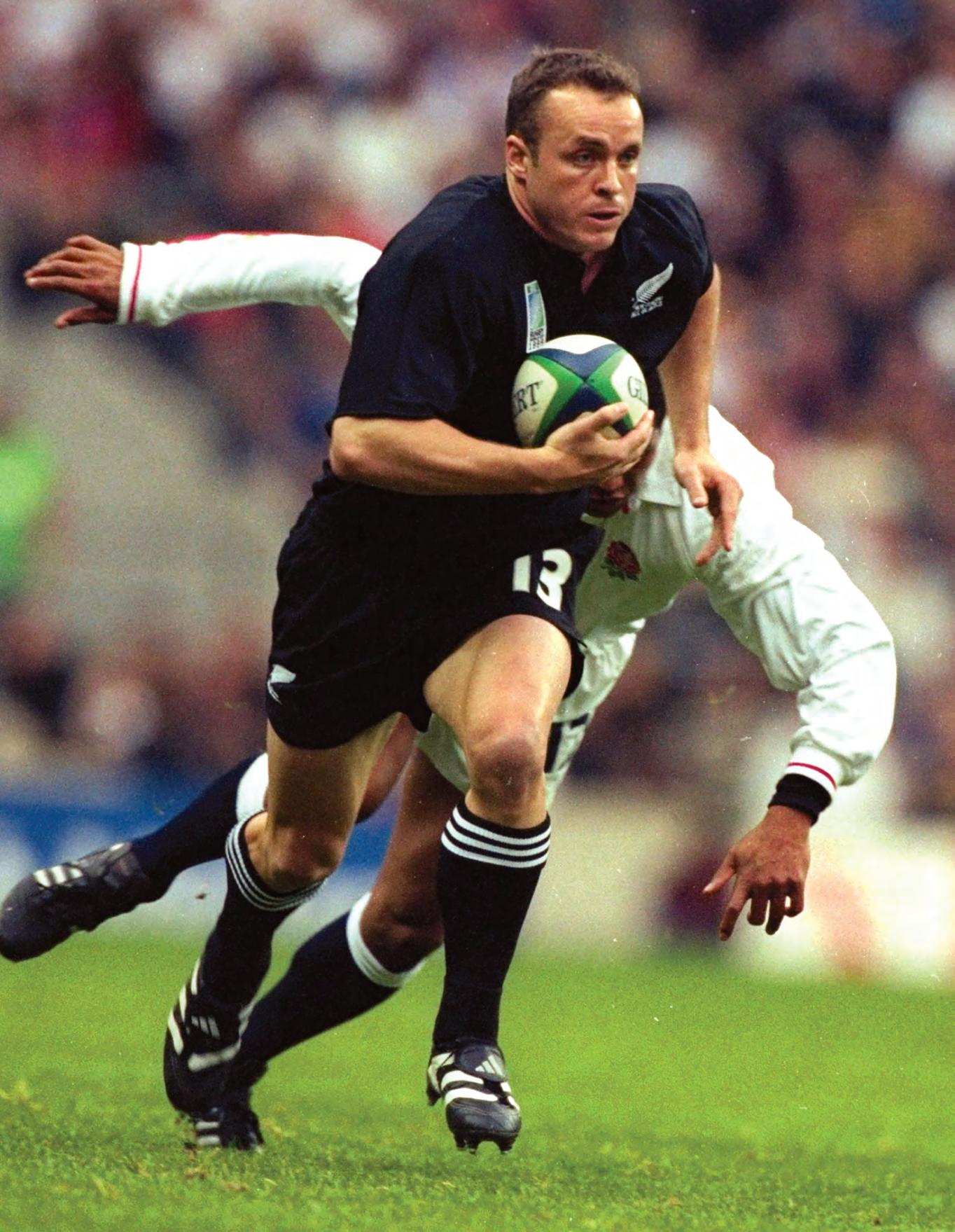
As an attacking back three, Cullen, Umaga and Lomu were beyond formidable. Add in Wilson, as John Hart did when he shifted Cullen to centre at the 1999 World Cup, and you had four of the best attacking players of their generation in the same backline.
Cullen had played a lot of age-grade rugby at centre, but those four never quite gelled in the way the public expected them to and the coaches hoped. In fact, Cullen’s positional shift is often blamed for the All Blacks semifinal loss to France. It’s a ridiculous assertion as a lot went wrong for the All Blacks that day, especially up front, but it was ironic that a year later it would be Umaga shifting from wing to centre, immediately establishing himself as a world-class midfielder.
A bad knee injury in 2000 saw Cullen lose a shade of his exceptional pace, but it was still a shock when he was sensationally dropped by John Mitchell for the end-of-year tour in 2001.
The dropping left a bad taste in Cullen’s mouth because he claimed that he had already been left out on medical grounds. The fullback was never notified that he was being “dropped”, with Mitchell, who had just taken over from Wayne Smith, saying he didn’t owe Cullen a call because he had never picked him in the past. In his book, Life on the Run, Cullen made his antipathy for Mitchell and his assistant Robbie Deans clear, saying the latter made his love for his Canterbury boys very clear and that Mitchell was a “bit of a dick”.
Though the 2001 dropping was poorly handled and a PR nightmare, it didn’t take the gloss off Cullen’s reputation — if anything, it enhanced it with the New Zealand public.
Mitchell made a u-turn in 2002 when he picked Cullen for six tests, but the 20-20 draw against France in Paris that November was Cullen’s last test.
Grant Nisbett had witnessed Cullen’s transcendent career from start to finish from Sky’s commentary box. The veteran caller is in no doubt about the quality of what he saw.
“Christian Cullen is the greatest rugby player I have ever seen,” Nisbett says. “I have never seen another player with the ability to change the course of a match so often in one game. He could do everything.”

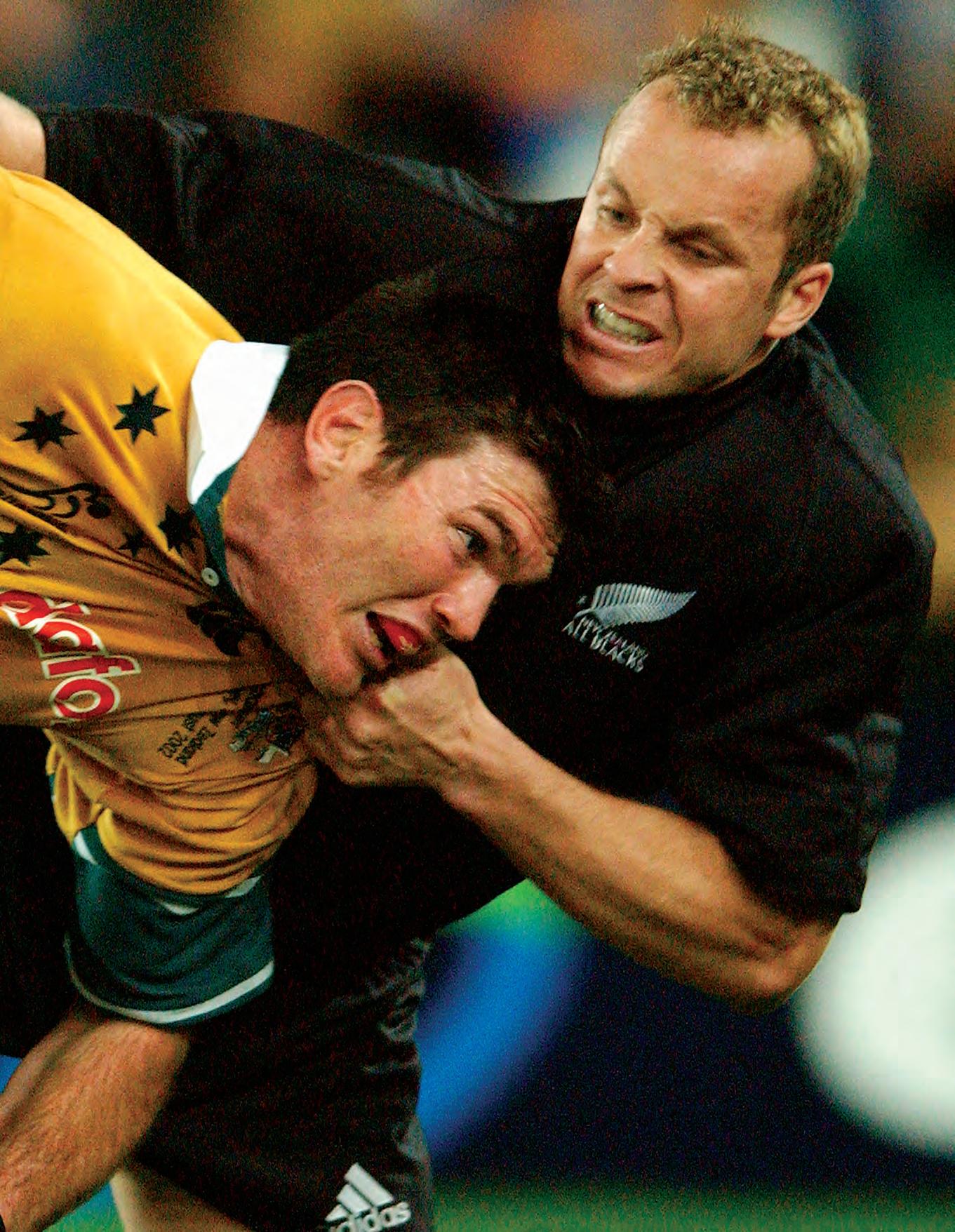

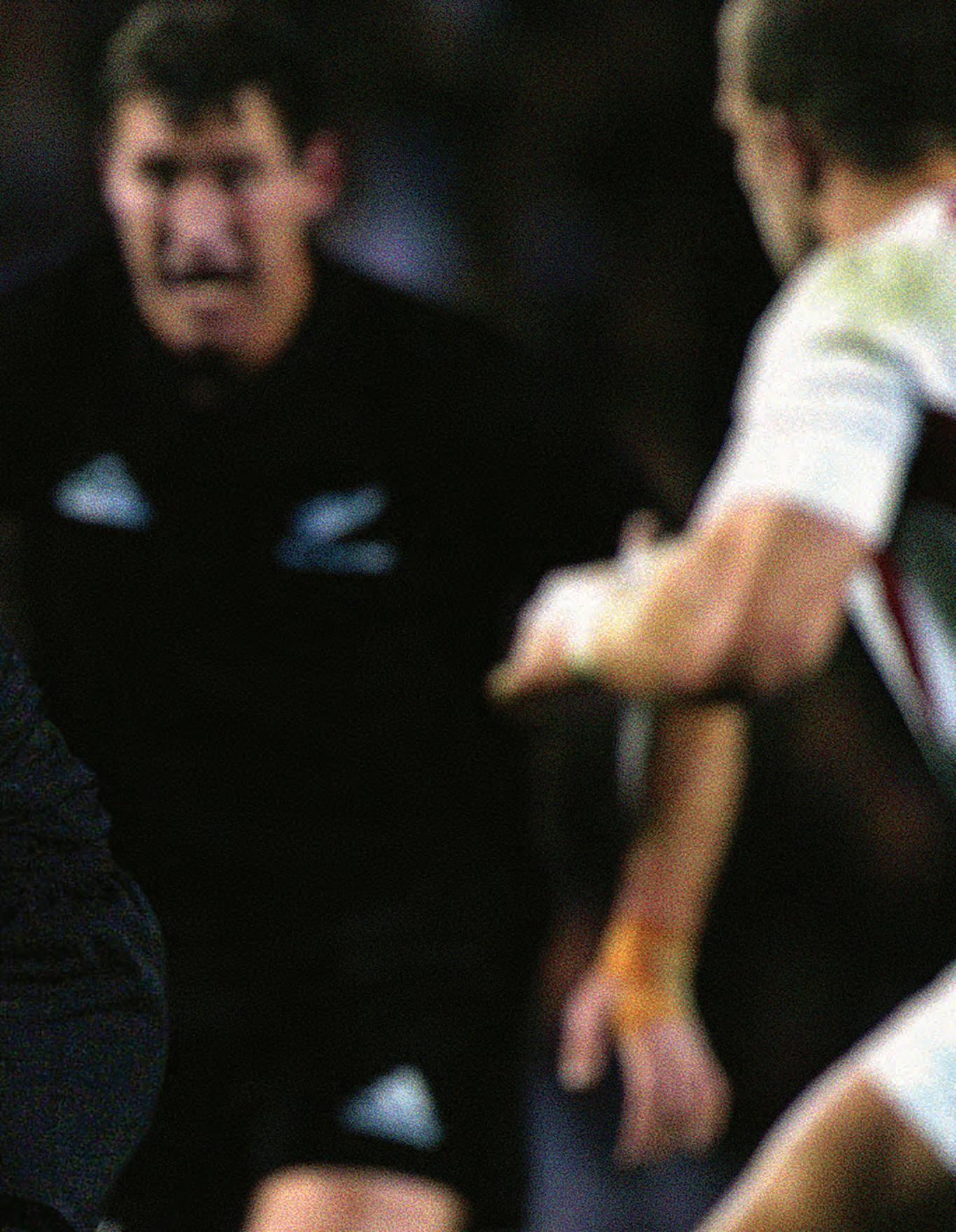
FA’ALOGO TANA UMAGA WAS THE ALL BLACKS FIRST PASIFIKA TEST CAPTAIN WHO ALSO SUCCESSFULLY MOVED FROM WING TO BECOME A WORLD CLASS CENTRE.
Tana Umaga wasn’t the first Pacific Islander to captain the All Blacks. That honour fell to Joe Stanley, born in Auckland of Samoan heritage, who led New Zealand against a French XV at La Rochelle, in 1990, and against Mar del Plata in Argentina a year later. Auckland-born Frank Bunce, who is Niuean and played for Western Samoa at the 1991 World Cup, captained the All Blacks against Italy A at Catania in 1995.
But Umaga, who was born in Lower Hutt to Samoan parents, was the first to lead the All Blacks in a test, and he did it 21 times from June 12, 2004, in a win against England, through to his international retirement against Scotland in late November 2005, a 29-10 victory that sealed New Zealand’s second Grand Slam.
Umaga opened the door for more to follow. Rodney So’oialo captained the All Blacks in five tests; Jerry Collins, Mils Muliaina and Keven Mealamu in three, while Ardie Savea has worn the skipper’s armband in nine tests at the time of writing.
“Coming from Samoan heritage, it was a very proud moment for us,” Mealamu says of Umaga’s elevation to the test captaincy.
Born 27 May 1973 in Lower Hutt, New Zealand
All Black 961 All Blacks Test Debut Saturday, 14 June 1997 v Fiji at Albany aged 24 years, 18 days Test Caps 74 Test positions Wing, centre and second-five High School Parkway College Club Petone
Under his captaincy the All Blacks won 18 of 21 tests, including a clean sweep in the three-test Lions series and the Grand Slam — beating all four Home Unions in a single tour — in 2005. Umaga also led the adoption of a new haka, Kapa o Pango, that reflected the Pasifika heritage within the team.
For those of us who reported on the game, Umaga was an interesting choice as captain for Sir Graham Henry. He could be stubborn and had a prickly relationship with the media. He imposed several bans on the Dominion newspaper for various slights and refused to talk to TV3 after the network aired footage of him stumbling drunk, through Christchurch’s Cathedral Square, after a post-match celebration. Intensely private, Umaga felt the use of the footage was a gross invasion of his personal life.
His attitude toward the media had to change when Henry offered him the captaincy as he realised it was a role that required him to be front-facing and a conduit between the players and the public. But it was not a case of


forgiving or forgetting and once he walked away from playing, he slammed the door shut again on those he didn’t like.
Whether he liked it or not (and rest assured, he almost certainly didn’t), Umaga was a magnet for a headline as a player and captain.
On one famous occasion he could be heard telling Australian referee Peter Marshall “we’re not playing tiddlywinks” after what he felt was an unfair penalty for a high tackle while playing for the Hurricanes. He also courted controversy when he and Mealamu were accused of a spear tackle on Brian O’Driscoll early in the first test of the 2005 British and Irish Lions tour — a tackle that ruled the Ireland superstar out of the rest of the doomed tour.
In his autobiography Up Close, Umaga labelled O’Driscoll a sook and insisted that what some said was a spear tackle was instead a legitimate clean out at the ruck. He also used his book to settle a few scores, saying that Wellington teams were victims of biased refereeing and that coaches Graham Mourie (Hurricanes)



and Aussie McLean (Wellington) couldn’t relate to Polynesian players.
If that all paints an image of a player fuelled by slights and animus, it is far from the full picture. Umaga could also be a statesman and was part of the New Zealand Rugby Union delegation — alongside Prime Minister Helen Clark and All Blacks great Sir Colin Meads — that persuaded World Rugby to grant New Zealand the 2011 World Cup hosting rights.
He was awarded the Pierre de Coubertin medal in 2003 for coming to the aid of Wales captain Colin Charvis after he was knocked out in a Jerry Collins tackle. He has been awarded the New Zealand Order of Merit and he is a Samoan matai, bestowed with chiefly title of fa’alogo.
On the field, Umaga was an immense player who moved from wing, where he started 24 tests, to the midfield, where he started seven at second five-eighth and 42 at centre. Fast and in possession of a good step, Umaga knew his way to the line, with 36 tries from 74 tests including a hat-trick against France in Wellington in 1999. He was also




one of the first backs to act as a quasi-loose forward at the breakdown, where his strength and timing saw him regularly win turnovers.
He played on the right wing in the ill-fated 1999 World Cup campaign, but was in the midfield by the time the next tournament rolled around. Umaga suffered a knee injury in the opening 70-7 win against Italy at Melbourne, which created one of the more curious mysteries in that tortured period of All Blacks World Cup history. The veteran believed he was fit enough to play the semifinal against Australia and was cleared to play by team doctor John Mayhew, but he was overlooked for selection by coaches John Mitchell and Robbie Deans, who instead selected fullback Leon MacDonald in the number 13 jersey for the test New Zealand lost 22-10. It was the second in a run of three World Cup knockout losses where a converted fullback was picked to play centre — following Christian Cullen in ’99 and preceding Mils Muliaina in 2007 — with little in the way of positive effect.
While Umaga could be a bit of a rough diamond he was an inspired choice as captain in many regards, especially as his elevation reflected the changing face of the All Blacks. The teams of the past had been largely European with a sprinkling of Māori, and leaned heavily on a rural backbone, whereas modern All Black teams were increasingly urban with a strong Pasifika element.
In the first All Blacks side he captained, five of the starting XV were of Pasifika heritage — Umaga, Mealamu, Muliaina, Doug Howlett and Joe Rokocko — as were two of the seven on the bench, Collins and Sam Tuitupou.
In his final test, Umaga was one of six Pasifika to start against Scotland and there were three more on the bench. In the first test of 2024 against England in Dunedin, there were eight Pacific Islanders in the starting XV and three more on the bench, with Savea the vice-captain.
“He brought a Pacific Island flavour to the role,” Mealamu says of Umaga’s captaincy style. “He knew his identity and who he was as a person, but he also grew in those shoes as an All Blacks captain.”
Henry says picking Umaga as his first test captain was an easy choice. “He was a world-class player and you need your captain to be world class, and he had an ability to connect with the players so they really respected him.”
Tana Umaga formed a formidable partnership with Jonah Lomu.
Umaga’s self-confidence manifested itself in different ways. Henry recalled with a chuckle a time when over a coffee at a cafe in Paris, Umaga told the coach that his pre-match speeches were missing the mark and he should save himself the time and effort. “I told him I thought they were inspirational and gave the team a bit of direction, and he said, ‘Are they for you, or for us?’
“He said that the team didn’t need them and he was right because you build up during the week and if they’re not ready to go you haven’t done it right, so that was the last time there was a pre-match team talk.”
There was a strong drinking culture in the All Blacks at the time with the infamous court sessions, where players and staff were made to down drinks for real or imagined infractions of team rules and protocols, still a big part of the post-match scene. One, following the loss to South Africa in Johannesburg in 2004, had some in the management fearing for their health. It was followed up by an incident on the flight home when some All Blacks spiked broadcaster Clint Brown’s wine with sleeping pills and then shaved off an eyebrow and drew temporary gang-style tattoos on his face.
With the encouragement of management, the leadership group under Umaga began to chip away at the traditional boozing culture where excessive alcohol use was seen as an appropriate reward for a week’s work.
“There were a lot of things changing, not only in All Blacks but in professional rugby as well,” Mealamu recalls. “Tana was at the start of that, which is something we can thank his leadership for. He took the reins when it came to looking at what it meant to be an All Black. What does that look like and what do our behaviours look like?’
“It’s not always perfect, but we were striving to be better people.”
Umaga’s impact on All Black rugby did not end when he retired. He played a significant role in Sonny Bill Williams’ early development when he coached the league convert at French club Toulon in 2008-09. In 2024, he took over as head coach of Moana Pasifika in Super Rugby having previously coached the Blues.
Umaga also has an aviation waypoint named in his honour. UMAGA is located south 10 nautical miles south of Wellington Airport’s Runway 34.

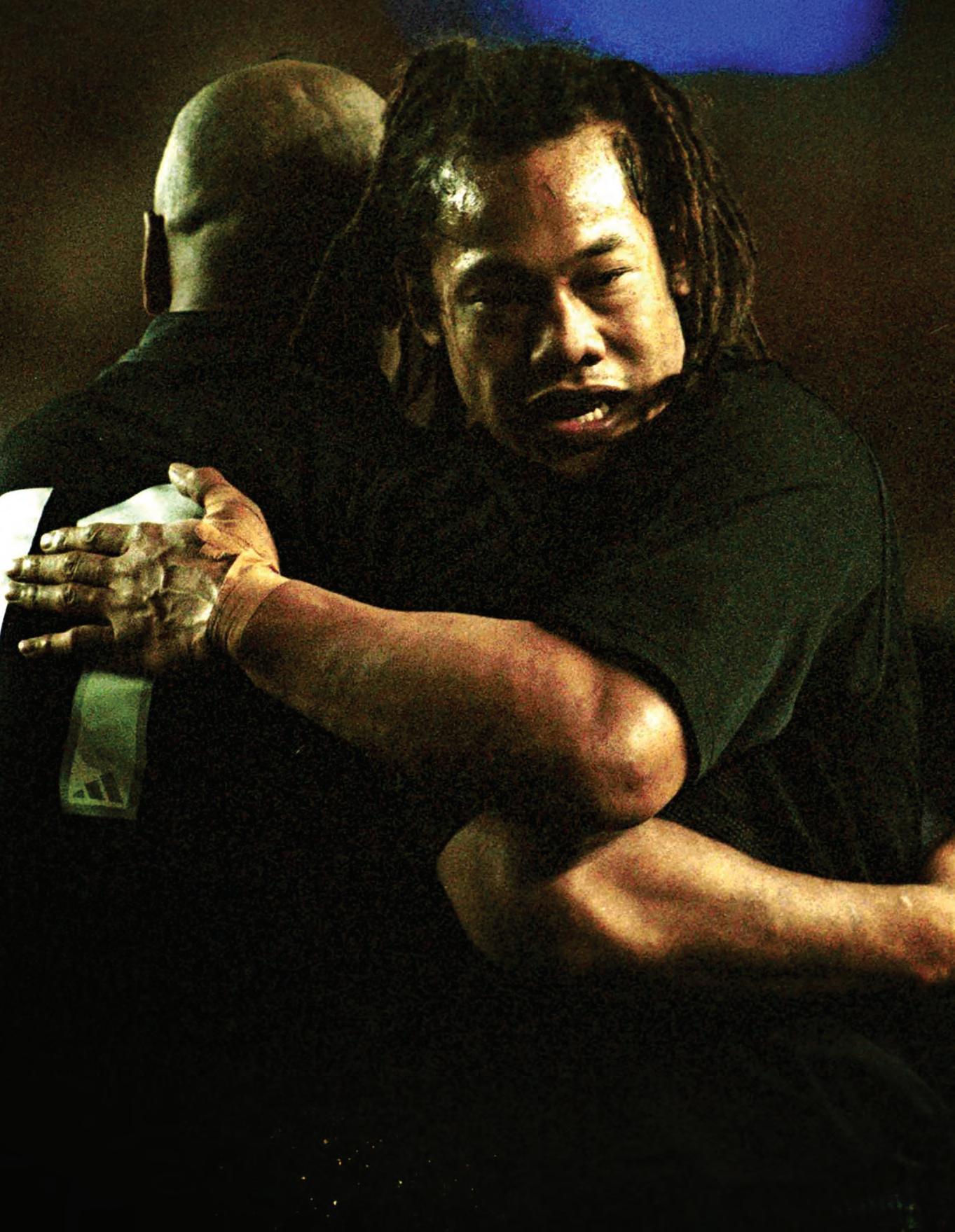
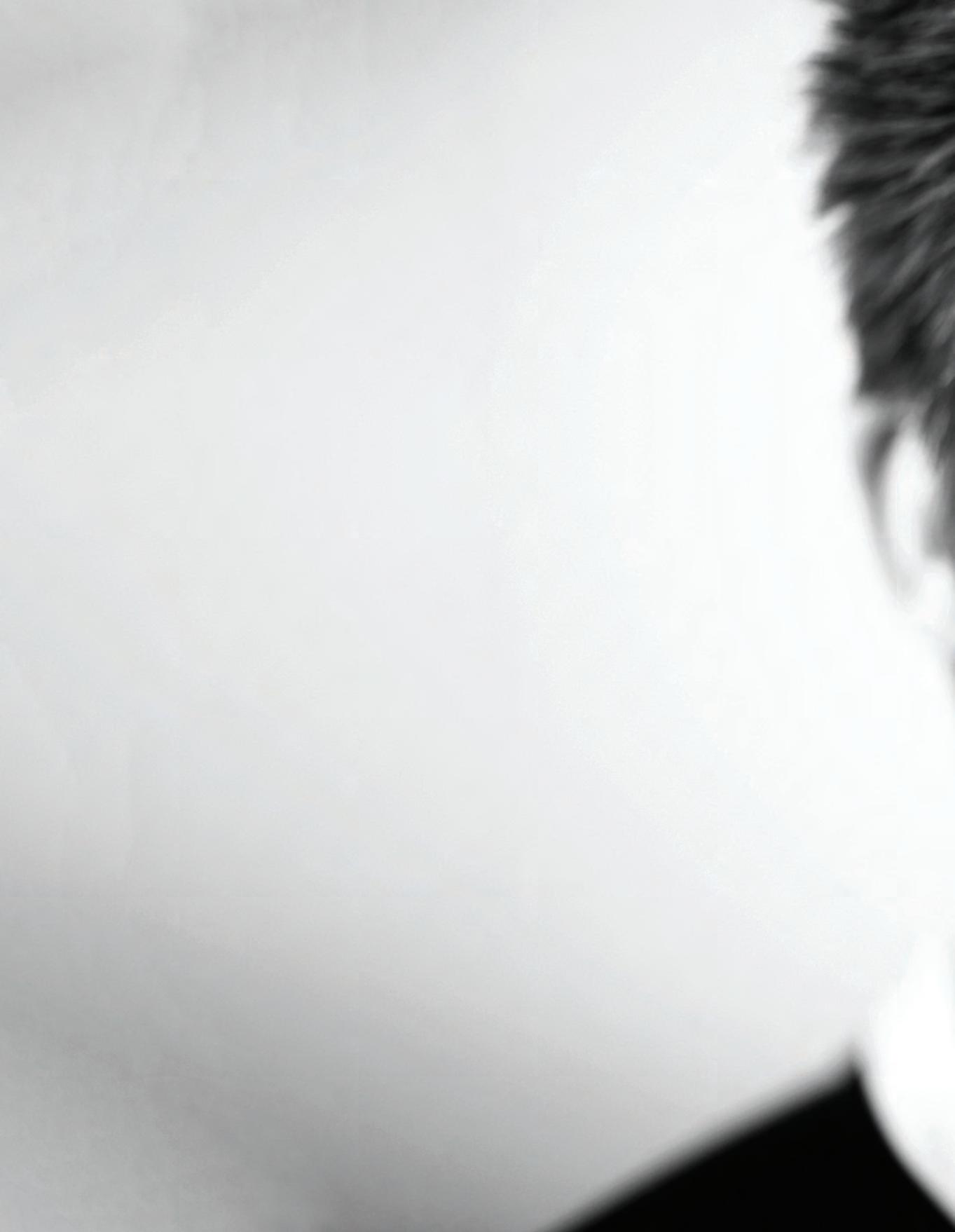
THE MOST DOMINANT FIGURE IN MODERN NEW ZEALAND RUGBY HISTORY, RICHIE McCAW MIGHT NOT HAVE BEEN THE MOST SKILFUL PLAYER TO HAVE STRAPPED ON BOOTS, BUT NOBODY HAD A BIGGER ENGINE OR A MORE RELENTLESS DESIRE FOR PERFECTION.

Born 31 December 1980 in Oamaru, New Zealand
All Black 1104 All Blacks Test Debut Saturday, 17 November 2001 v Ireland at Dublin aged 20 years, 321 days Test Caps 148 Test positions Openside, Blindside, No 8
High School Otago Boys’ High Club Christchurch
n the eve of the 2011 World Cup final, at the captain’s press conference, the only talking point was Richie McCaw’s foot.
We, the gathered media, knew it was injured and that he had been restricted in his training and as the final against France drew closer, Kiwi angst about the state of that foot rose by the hour. Heck, there was even a social media account created in the name of McCaw’s foot.
As we settled into our seats ahead of that final media call, all eyes were on the door to the conference room at the All Blacks’ Auckland hotel, waiting for McCaw to arrive.
He did so in full stride, pacing so quickly and with such a strut that the team’s media manager, Joe Locke, had to trot to keep up. McCaw took his seat, gazed out at the cameras and declared: “The foot is fine. Next question.”
Richard Hugh McCaw was the ultimate player’s captain, fitting all the leadership clichès, especially that one about leading from the front. He made it quite literal — first off the bus, first out of the changing sheds at training, first to the breakdown… you get the picture. He was tough, too, but not in a violent, thuggish way. His toughness was writ large through his actions.
Brad Thorn, who stood tall among the toughest in league before carving out a wonderful career in rugby, reckons McCaw is the hardest he’s seen. So too Nigel Owens, who observed the toughest of men from every rugby-playing nation in his role as the world’s best referee.
Sam Whitelock, who slipped past McCaw at the 2023 World Cup as the most capped All Black, says McCaw refused to show weakness in front of his teammates. In his biography, View from the Second Row, Whitelock wrote: “As a number seven, he had to show that he was prepared to get beaten up every weekend and still be first in line for more punishment at training. There were many times I knew he had a sore knee or that his shoulder was killing him. The physio would come around the team for check-ups and he’d say, ‘Yeah, I’m all good,’ and walk away. I’d be sitting there thinking, ‘How is this guy getting through this work unscathed?’ Once I’d played with and

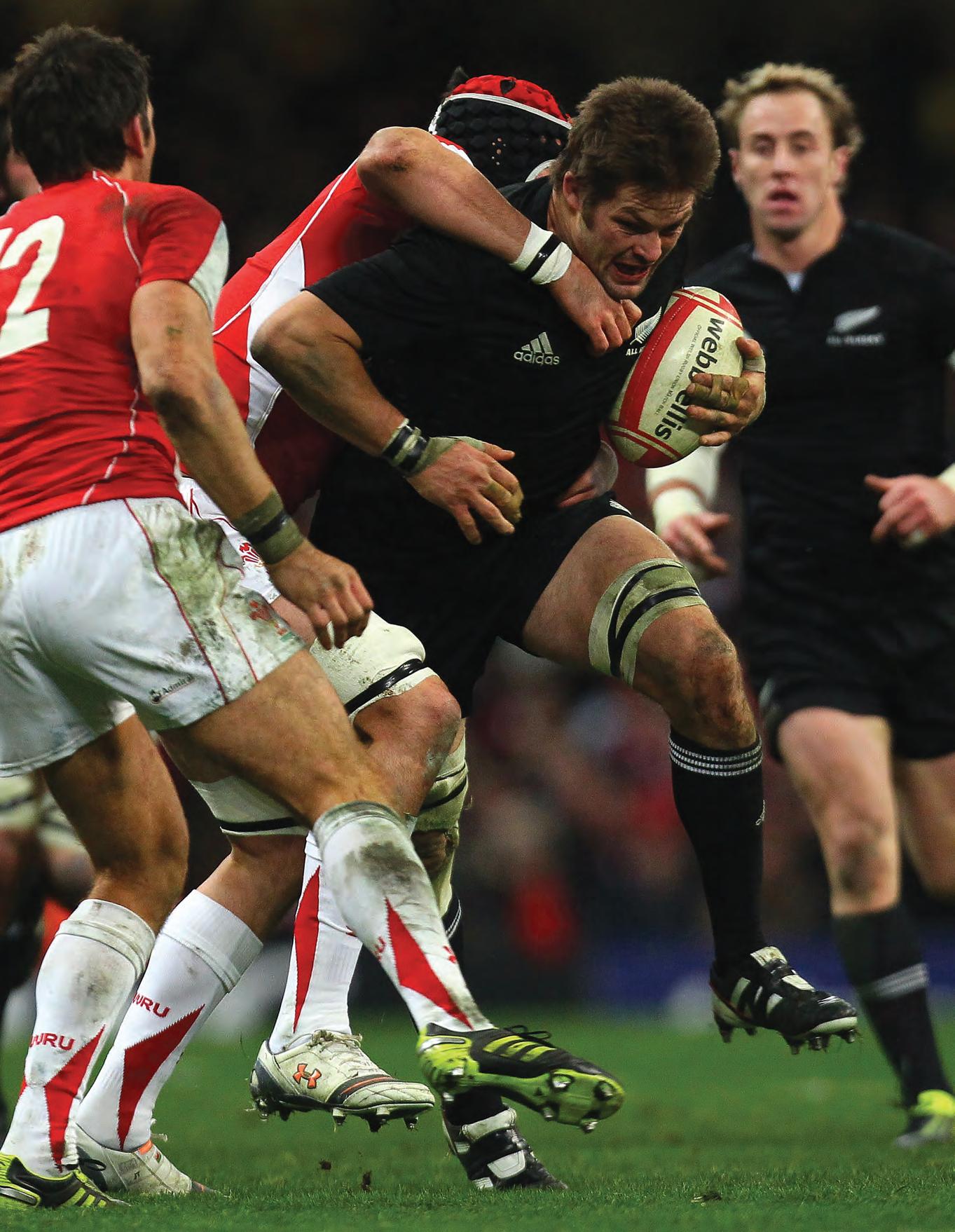
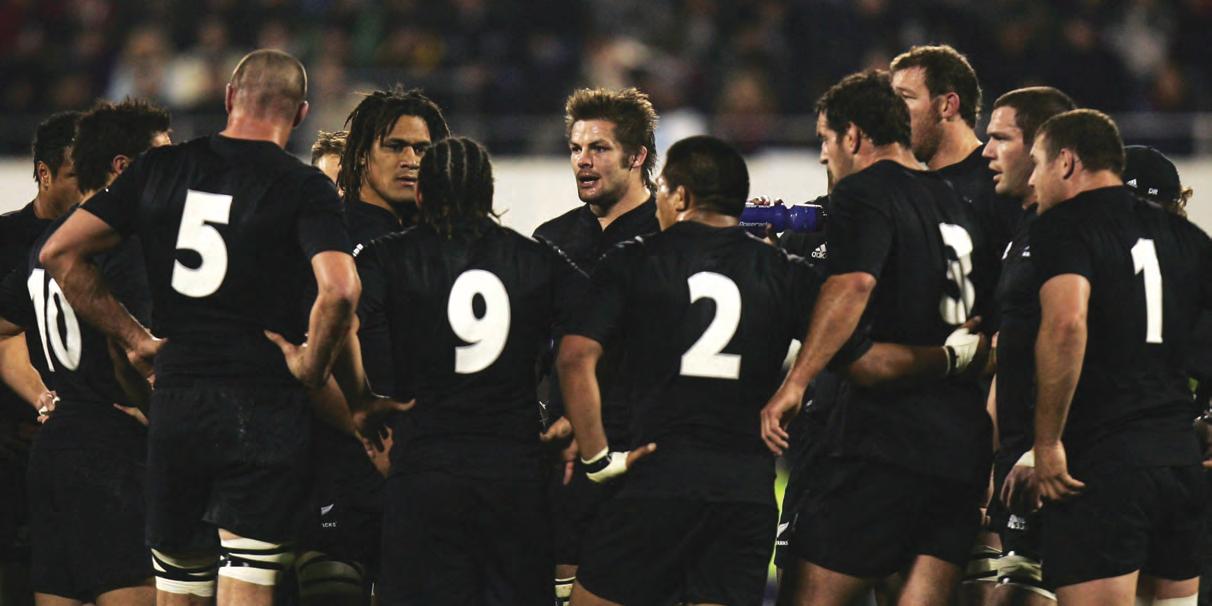
observed Richie for long enough, I noticed that this was done for the benefit of the rest of the men in the team. An hour or two later, when nobody was watching, he’d sidle up to the physio and book in some time to get his knee or shoulder sorted. Publicly, he refused to show weakness, and that set the tone for his leadership.”
While he wasn’t the most loquacious, McCaw could hold an audience and understood his role with the media as captain.
He had plenty of practice, leading them in 110 of his 148 tests, plus the only non-test he played, a loss to the Barbarians in 2009. That loss was a rarity, with McCaw in the winning team a staggering 131 of his 148 tests. As a captain he led the All Blacks to victory in 98 of the 110 tests, with two draws and 10 defeats. To give some context, at the time of writing it meant that only 12 All Blacks had played as many tests as he had enjoyed victories as skipper.
McCaw’s influence in the All Black environment was total. The young players in particular held him in awe. Jerome Kaino said it took him several years to truly feel accepted as an All Black by McCaw, while Julian Savea admitted he
spent the first few months in the All Blacks hiding from his skipper. “If I saw him walking down a corridor I’d turn and go the other way,” the wing, who himself struck fear into many opponents, said.
“I don’t know if it was fear, but there was definitely that respect,” says Keven Mealamu, an All Black no teammate wanted to cross. “You didn’t want to muck up around him and we understood how focused he was on his preparation. I’d say he was revered and that’s not a trait every player has, so it was a powerful thing.
“The way he trained, the way he talked, and the way he carried himself around the team; he wasn’t the biggest talker but when he spoke, he had mana.”
That was never better exemplified than on a blistering hot day at Wits University, in Johannesburg, during a Thursday training run ahead of the 2012 test against the Springboks in Soweto. The All Blacks had thrashed Argentina the previous weekend but the travel from Buenos Aires was taking a toll. Training was sloppy. Balls were being dropped. There was no accuracy. McCaw summoned his troops and let rip, explaining in colourful language that yes they were tired, yes it was hot and yes there were a lot
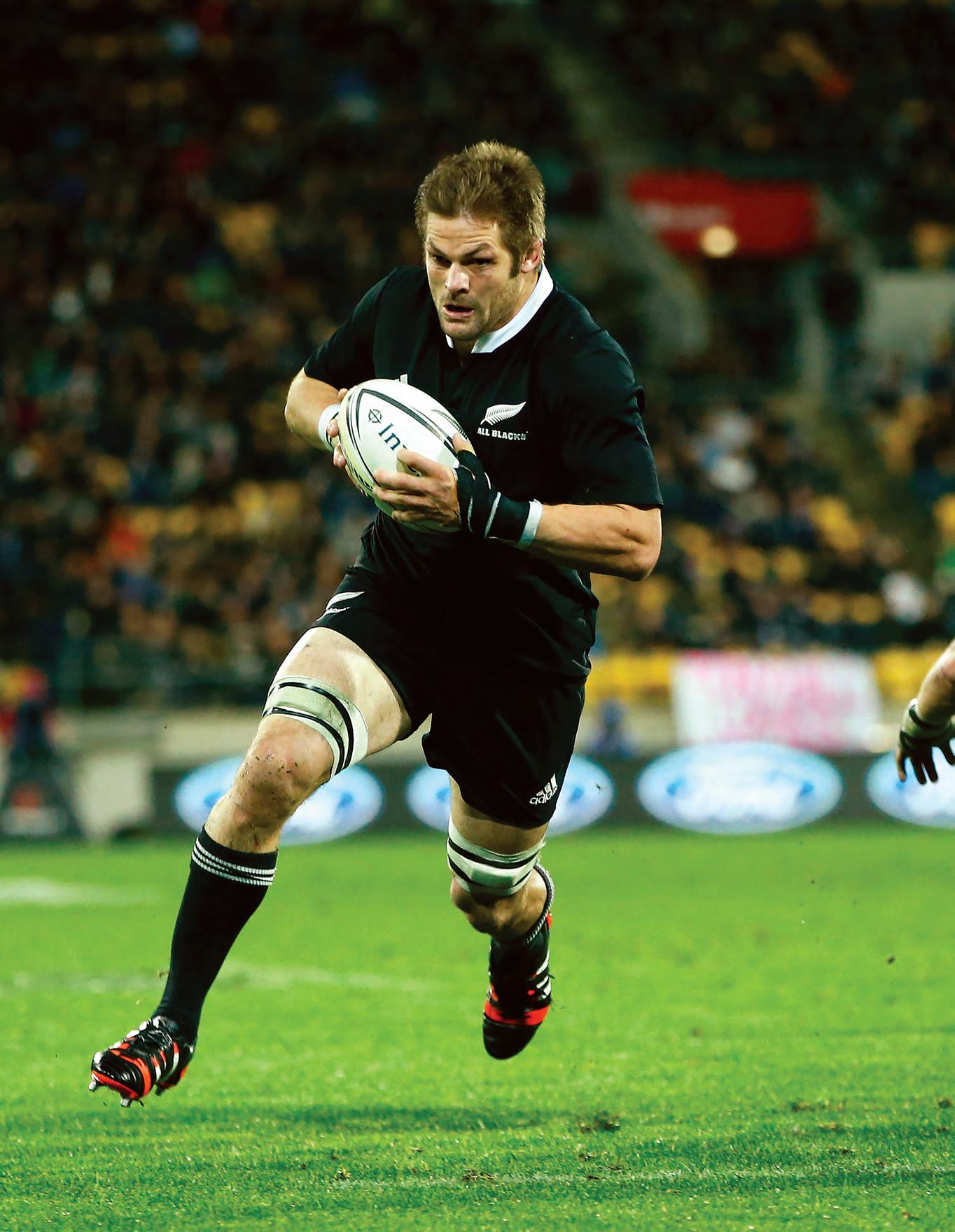

of excuses for the previous hour of rubbish training. None of that, he said, would wash on Saturday. Fix your attitude, was the message.
The final 20 minutes of training was sharp, and so was the performance on the weekend. Turning around with a 12-16 deficit, the All Blacks piled on 20 unanswered points in the second half to win comfortably. “Skip was always focused on accuracy,” Mealamu says. “That’s what made us different. He was all about performance.”
That was to the fore in 2008, as the All Blacks looked to bounce back from their quarter-final loss to France at the previous year’s World Cup. “It was an important year,” Sir Graham Henry says with a chuckle, as he had narrowly held off a challenge from Robbie Deans to remain head coach.
The All Blacks started well, beating Ireland, England twice and Samoa, before kickstarting the Tri Nations with a win in Wellington against South Africa. But with McCaw injured and Rodney So’oialo the stand-in skipper, they lost to the Springboks in Dunedin and to Australia in Sydney. They beat Australia in the return test at Eden Park, but needed to win in Cape Town and Brisbane to retain the Tri Nations title for a fourth year in succession.
“SKIP WAS ALWAYS FOCUSED ON ACCURACY,” MEALAMU SAYS. “THAT’S WHAT MADE US DIFFERENT. HE WAS ALL ABOUT PERFORMANCE.”
“Before we flew to South Africa, Richie called a meeting at 4am to set the tone for what we needed to do on the plane to make sure our body clocks were right for the test in Cape Town,” Henry says. “We won that test 19-0 and then beat Australia. That’s Richie, attention to detail. He was a perfectionist.”
There was, of course, more to his game than leadership. While there were players who might have had more talent and finer skills, few could match his capacity for work, his huge “engine” and supreme fitness.


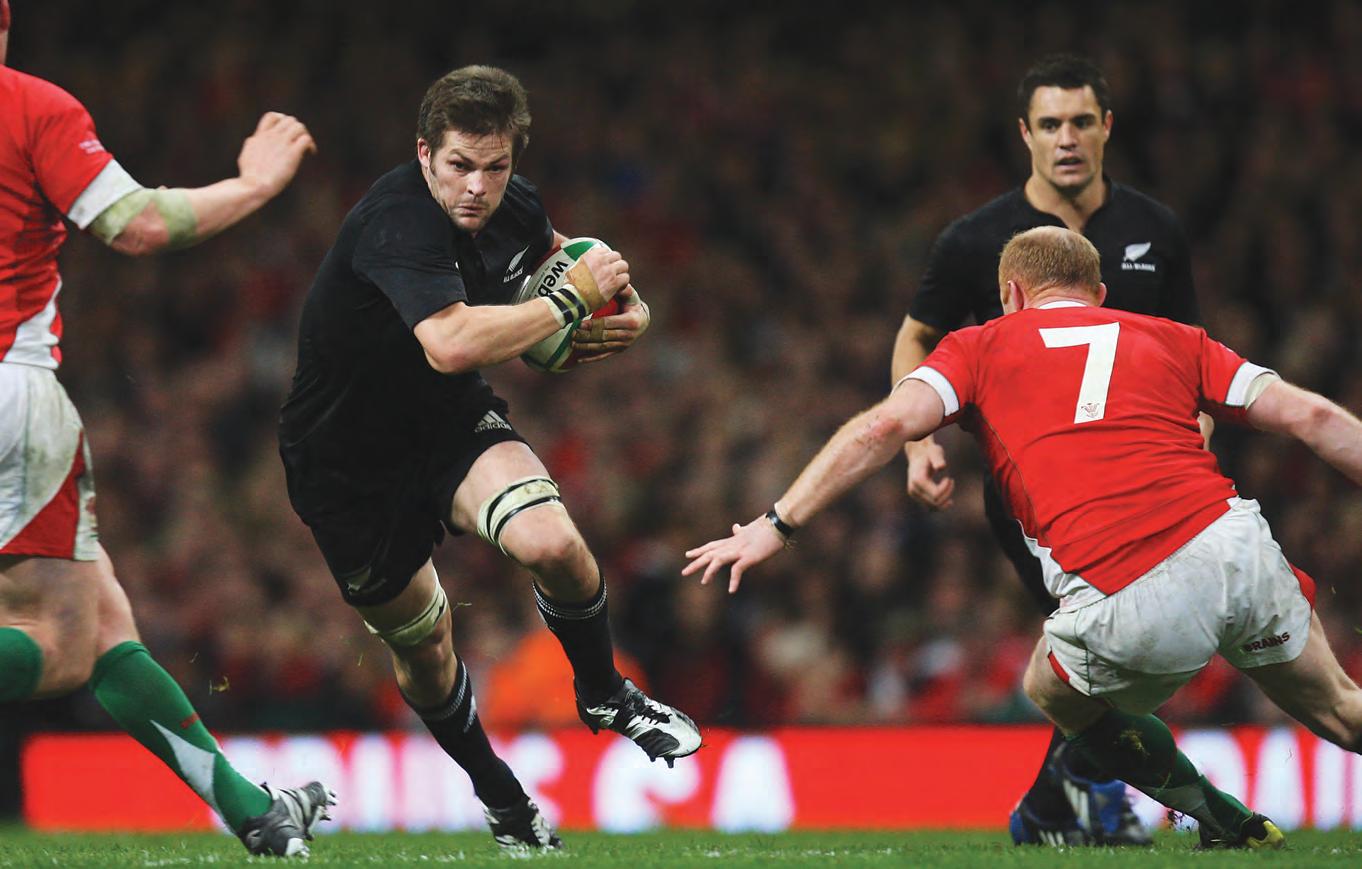

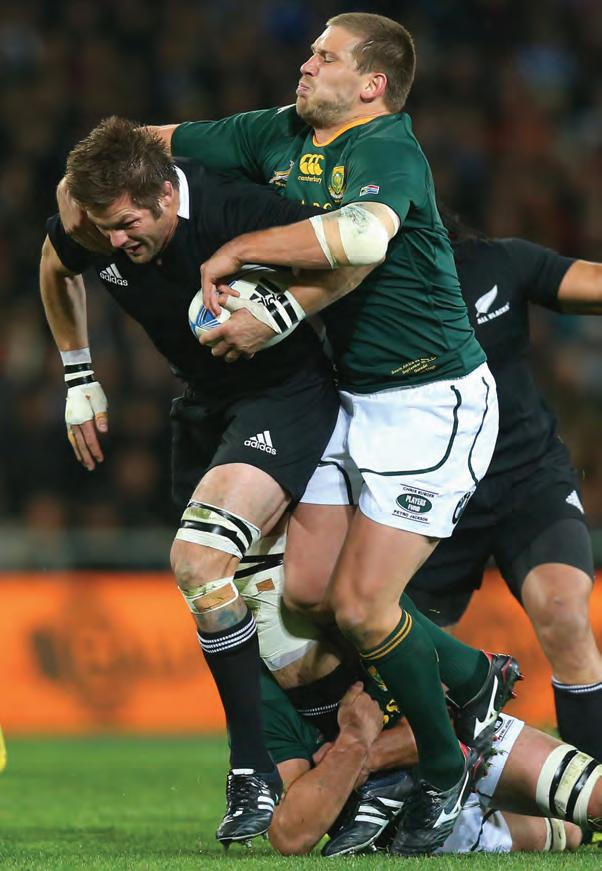


One of his many celebrated moments came early in the second half of the test against Australia in Brisbane in 2006, as the All Blacks protected a 10-6 lead. From a lineout, Stirling Mortlock broke the line on halfway and passed to wing Mark Gerrard who was flying for the corner. McCaw tracked him all the way, making a tackle just short of the line and effecting the turnover. The All Blacks held on for a tight 13-9 win.
McCaw’s attitude and his drive for perfection saw the All Blacks dominate the game for many of his 14 years, but especially the last half as he guided the All Blacks to World Cup wins in 2011 and 2015. He was named World Rugby’s player of the year in 2006, 2009 and 2010 — a trifecta only Dan Carter has matched — was the same body’s player of the decade for the 2010s and was New Zealand’s sportsman of the same decade, too.
He was, perhaps, the last of the true ‘fetchers’ in the game thanks to changes in playing style and tactics. Sir Steve Hansen delights in a story about a young McCaw frustrating the senior players at a Canterbury training because he kept pinching the ball. Todd Blackadder complained and Hansen said, “If you get better at stopping him then you’ll be better at stopping the opposition in games.”
Hansen said that transformed training from a largely passive, routine-based exercise into something more competitive. They were training to be dominant, not to be efficient.
“So he had an influence there and he had an influence on how we prepared mentally, because he was such a tough guy — we saw that in the 2011 final.
“As a leader, he was called our worst captain ever after the 2007 quarter-final and he became our best, which shows his mentality. He’d had a failure, but that wasn’t going to stop him from being successful.”
Neither was a broken foot.
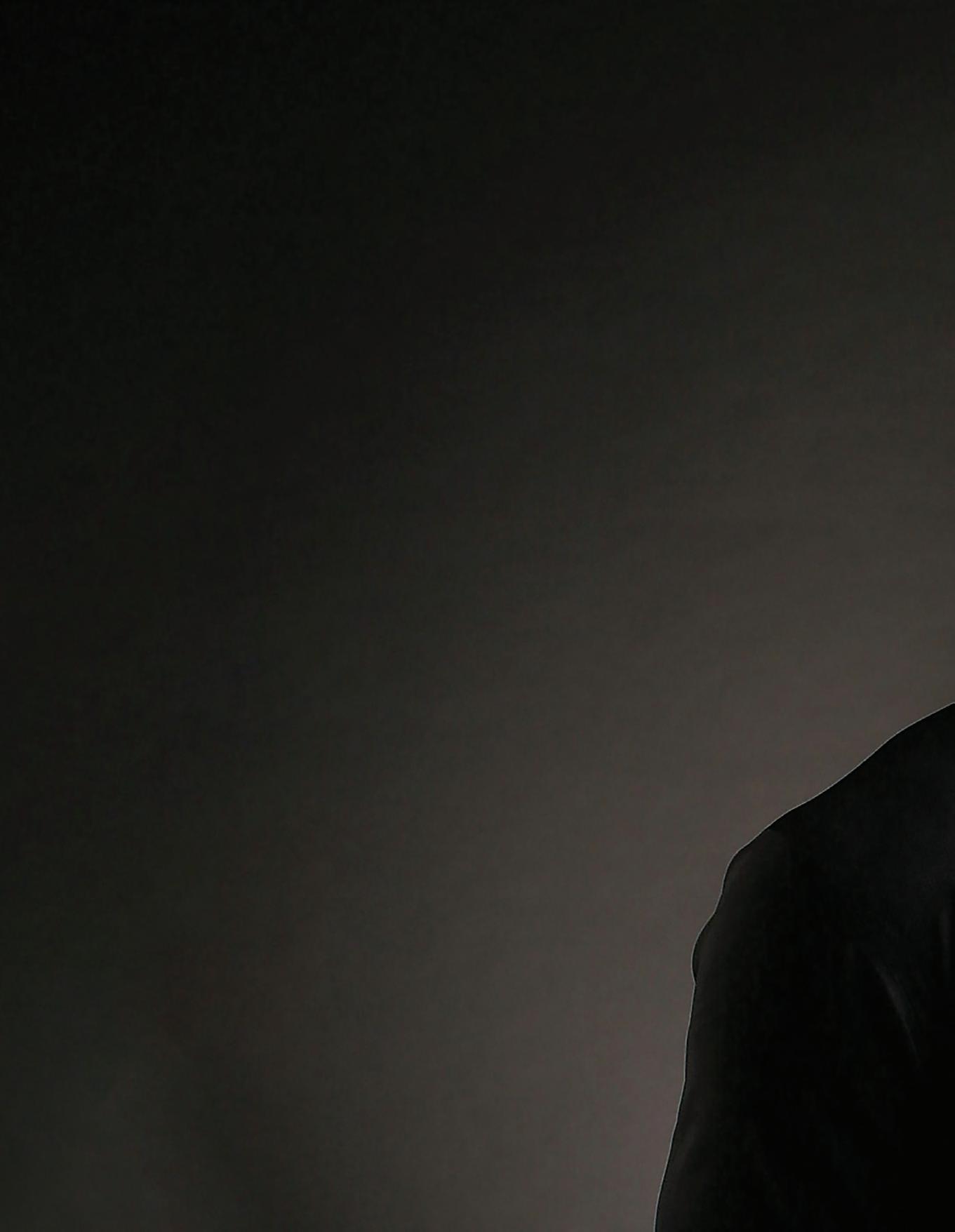
DAN CARTER IS REGARDED AS ONE OF THE GREATEST PLAYERS OF ALL TIME AND BECAUSE HE HAD SUCH A GOOD ALL-ROUND GAME, EVEN THE STAUNCHEST OF ALL BLACKS CRITICS HAILED HIM AS A RUGBY GENIUS.
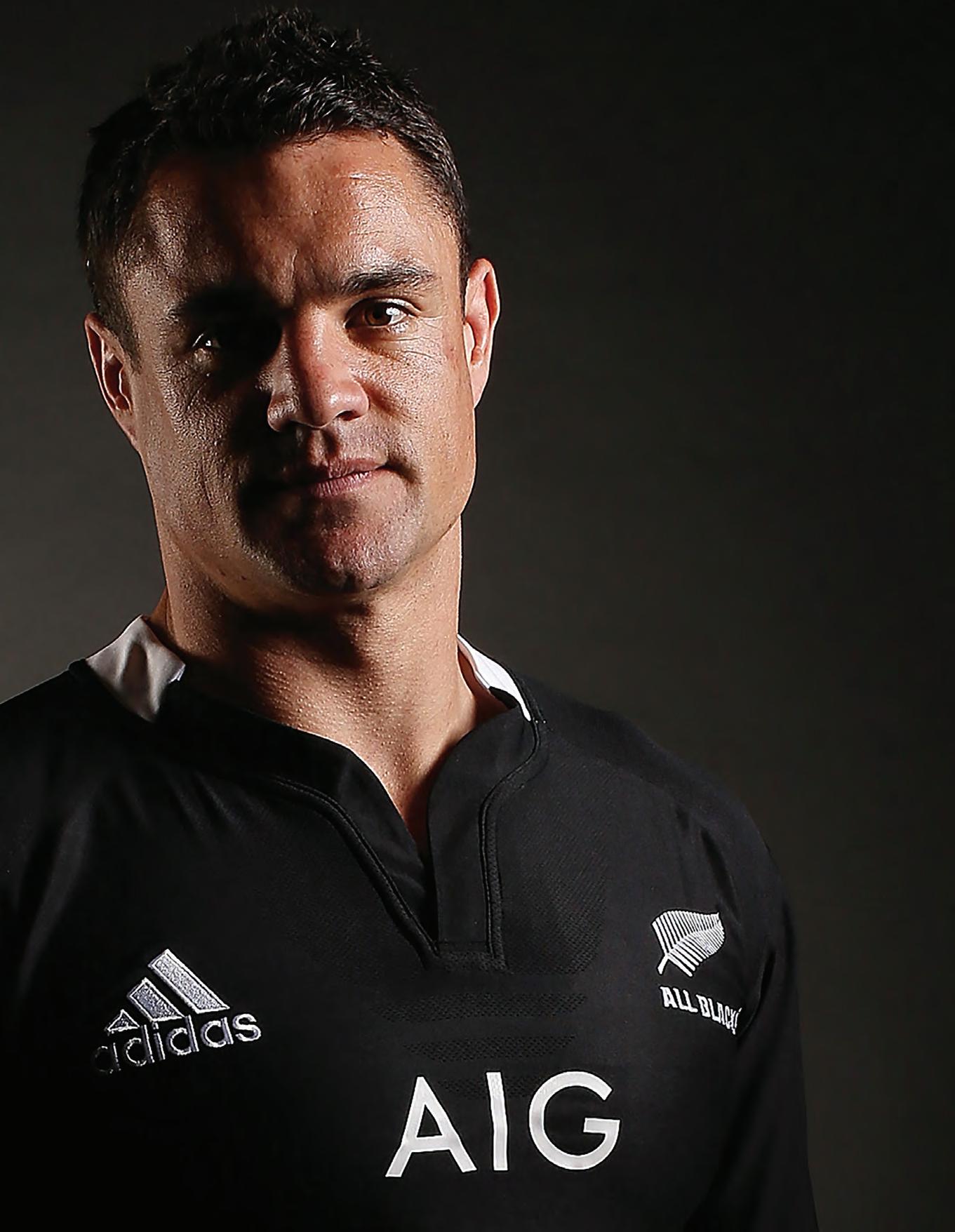
Dan Carter had two career-defining tests in his glittering career.
The first was the second test against the British and Irish Lions in 2005 when he scored two tries, and kicked four conversions and five penalties for 33 points in the 48-18 thrashing of the tourists.
Even Lions coach Sir Clive Woodward hailed Carter’s performance that evening as the best he has seen from a first five-eighth, labelling Carter “the perfect 10”, while his counterpart Sir Graham Henry said it “was probably the greatest performance by any rugby player ever”.
“It was life-changing for me,” Carter said in a later interview with British media. “That second test really kick-started my All Blacks journey. I was surrounded by international media asking me about this ‘perfect match’ I’d just played. I was young, naive and it was huge. Before that, I was a 23-yearold guy that most rugby people had never heard of.”
Some 92 All Blacks matches later, in his final test, the left-footed Carter produced another seminal performance, capping victory against Australia to win the 2015 World Cup by converting Beauden Barrett’s match-sealing try with his right foot.
It was a homage to his father, Neville, who gifted his son a full-sized set of goalposts on the back lawn of the family home and had always encouraged his son to practise kicking off both feet.
“I did it really quickly, hoping no-one would see, but when you’ve got a million cameras on you, it’s hard to get by,” he would say.
The kick saw Carter finish his 112-test career with 1429 points off the tee — all but two from his trusty left foot. Carter also scored 29 test tries, an impressive feat that is 22 more than Andrew Mehrtens, another gifted running first-five, and bettered only by outside backs.
Born 5 March 1982 in Leeston, New Zealand
All Black 1134
All Blacks Test Debut Saturday, 21 June 2003 v Wales at Hamilton aged 21 years, 108 days
Test Caps 112 Test Positions: First five-eighth, second five-eighth High School Ellesmere College Club Christchurch HSOB
“He had it all,” enthused Henry. “No weaknesses. He was a very good attacker but also a magnificent defender. He’s probably the greatest first five-eighth the world has ever seen.”
Henry noted that one of Carter’s unseen strengths was the homework he did. “He did a lot of prep so in his mind he had a map of how we were going to play the game for that particular test match, so not only was he a very gifted athlete, he was a very dedicated athlete.”
Carter made his All Blacks debut against Wales in 2002 playing at secondfive outside Carlos Spencer. He scored a try and kicked six conversions and a penalty in the 55-3 thrashing of a team coached by future All Blacks head coach Steve Hansen.


Carter had a set of posts at his childhood home to practise his goalkicking.

“He was wonderful that night,” Hansen recalled, “and you wouldn’t have thought he was playing his first test because he was confident and assured, and he had time. He always had time on the ball.”
By the end of the following year Carter was entrenched at No 10, where he would start 94 times for the All Blacks.
Hansen says Carter was driven to be the best firstfive the game had seen. The 2005 Lions tour, with the highly regarded Jonny Wilkinson opposite him, provided an ideal chance to showcase his class. Wilkinson started the series at second five-eighth, but was moved to No 10 for the second test.
His career did not follow a perfect arc, however, especially when it came to World Cups. He was forced from the field during the loss to France in the 2007 quarter-final and was seriously hurt when he tore an adductor muscle midway through the 2011 event, forcing him out of the tournament.
In the lead up to the 2015 World Cup Carter was struggling with form and injuries and for the first time the media and fans were questioning his
place in the starting side, with excitement machine Beauden Barrett, who was being utilised mainly as a super-sub, waiting in the wings. Hansen accepts that Carter was slow to find his form at the tournament, but that changed in the quarter-final against France, in Cardiff, when Carter saw an opportunity to right the wrongs inflicted upon the All Blacks in 2007.
“In that game he just went to another level and from then on he was sublime, drop-kicking goals, playing wonderful football and finishing with a right-foot conversion.”
That conversion brought the curtain down on a test career that had seen Carter dominate the No 10 jersey unlike any first-five before him.
Grant Fox had Frano Botica nipping at his heels and Andrew Mehrtens was always in a tussle with Carlos Spencer, but Carter had no real contenders to his throne, similar in that respect to Richie McCaw.
The All Blacks captain said part of Carter’s legacy is that across all of his tests there were few, if any, where he did not have a significant influence in how the All Blacks played .

“HE
HAD IT ALL,” ENTHUSED HENRY. “NO WEAKNESSES. HE WAS A VERY GOOD ATTACKER BUT ALSO A MAGNIFICENT DEFENDER. HE’S PROBABLY THE GREATEST FIRST FIVEEIGHTH THE WORLD HAS EVER SEEN.”

“That didn’t just happen by chance,” McCaw says. “It happened because he was dedicated and put the time in. He had great skills to start with, but he got better at them.
“The great players have time, and make things look easy when they’re not. Why does someone look like they have time? It’s because they are calm and execute under pressure and that’s something he did consistently throughout his career.”
Like McCaw, Carter hails from rural New Zealand, having grown up in Southbridge, a farming community about 50km outside Christchurch. He was educated primarily at Ellesmere College with only his final year spent at the more prestigious rugby school, Christchurch Boys’ High. And, just like McCaw, Carter was named World Rugby’s Player of the Year three times, in 2005, when he became the first New Zealander to win the award, 2012 and 2015.
“DANIEL HAD SPECIAL CHARACTERISTICS IN EVERY AREA OF THE GAME WHICH MAKES HIM, TOGETHER WITH MCCAW, THE GREATEST PLAYERS IN HISTORY, AND I’M NOT JUST TALKING ABOUT ALL BLACKS.
Wayne Smith is widely regarded as the greatest coach of the modern era, having enjoyed success with the Crusaders, All Blacks and Black Ferns. Often dubbed The Professor, he suggests Carter was the unseen coach within the All Blacks.
“Daniel had special characteristics in every area of the game which makes him, together with McCaw, the greatest players in history, and I’m not just talking about All Blacks.
“There’s no other word for him, other than sensational. As a coach I have always said I learnt more from Daniel than I actually taught him. I learnt a lot from watching him and listening to him. He could play at pace and execute stuff no one else could.”
On one such occasion, his mix of vision and skills put a try on a plate for Mils Muliaina that Smith still marvels at today. Playing England, defenders had got into the passing lane, so Carter circumvented them with the aid of his boot.
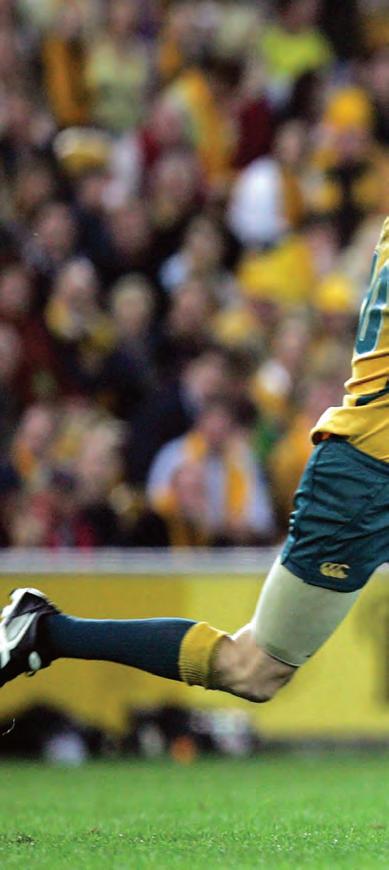
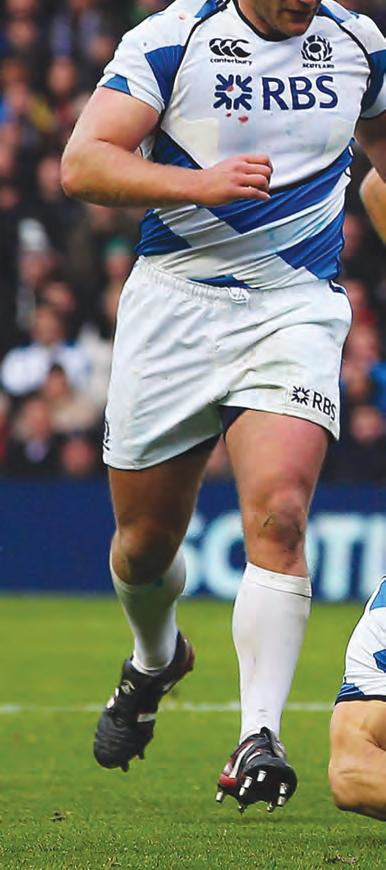


Carter was just as good on defence as he was attack.
“It was only 15 metres, so it wasn’t a big cross-field kick-pass, and he kicked it off the end of the ball so it went sideways to Mils who caught it and scored under the sticks. It was unbelievable how he could control the ball. It was mind boggling working with him.”
It wasn’t just his work with the ball that caught Smith’s trained eye. The coach, who played 17 tests as a first-five himself, rates Carter and Jonny Wilkinson as the two best defensive 10s he has seen. When Carter defended the narrow channel alongside McCaw, it was a virtual no-go zone for the opposition.
“You’re going to pick another channel, but you don’t want to pick Ma’a Nonu’s outside channel either, so it made devising game plans against us difficult.
“His passing skills were amazing, his running game was outstanding, all around he is the most complete player I have ever seen.”
Carter was also the first truly corporate All Black and he worked hard to present a carefully cultivated image. So much so that some within his own camp joked that Brand Carter was bland Carter, but the real Dan Carter was a good fella. He had several lucrative endorsements including Jockey underwear, a campaign he has shared with his wife, former hockey international Honor Carter (nee Dillon). One of those endorsements came off the books in 2017 when he was caught driving in Paris with a blood alcohol level nearly twice the legal limit, something that didn’t impress the account holders at Land Rover.
One of the undeniable factors in Carter’s desirability as a marketing front man was his easiness on the eye. In 2004 and ’05, he was voted sexiest New Zealand male in a survey. In 2008, American cable channel E! judged Carter to be 11th on its list of the world’s sexiest men, and two years’ later E! voted him the world’s third sexiest male athlete.
As a player and a front man, Carter had few peers.

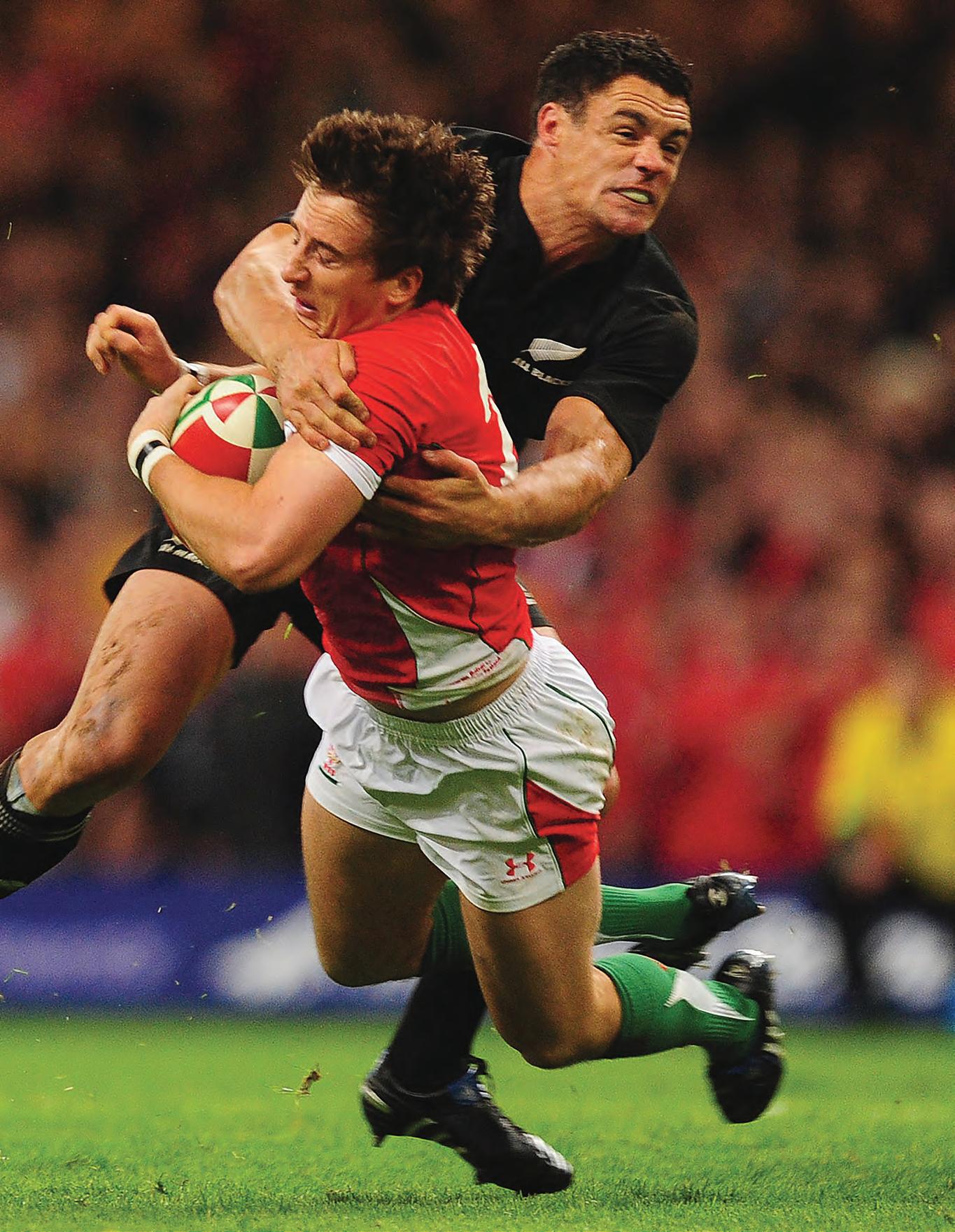

MANY YOUNG FOOTY PLAYERS CAME INTO THE CRUSADERS SYSTEM THINKING THEY WERE FIT, STRONG AND POSSESSED A GOOD WORK ETHIC – UNTIL THEY STARTED TRAINING ALONGSIDE BRAD THORN, THAT IS.
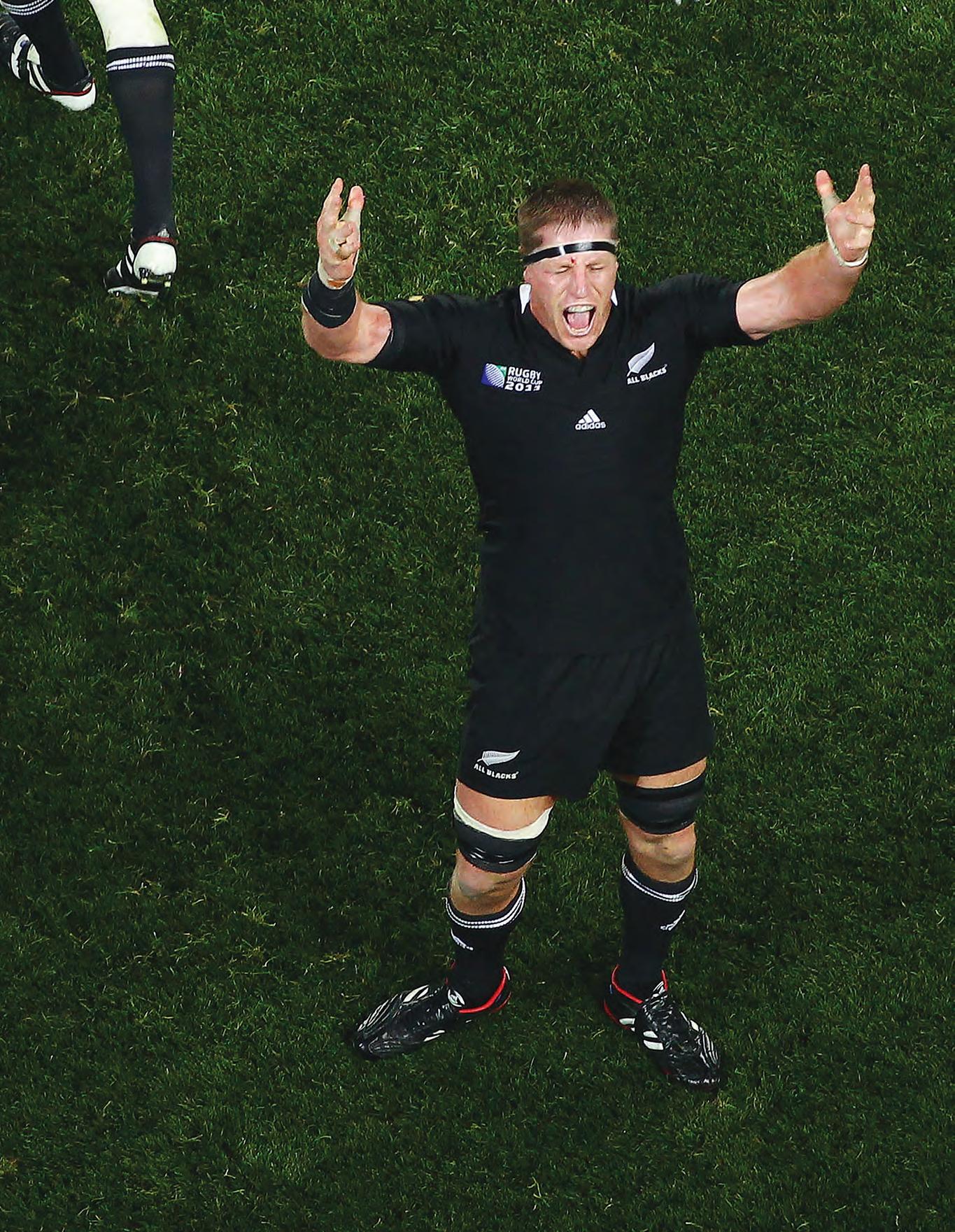
Brad Thorn
Born 3 February 1975 in Mosgiel, New Zealand
All Black 1035 All Blacks Test Debut Saturday, 21 June 2003 v Wales at Hamilton aged 28 years, 138 days Test Caps 59 Test positions Lock High School
Aspley State High School, Brisbane Club Burnside
Brad Thorn was a superstar in the NRL when he switched codes, and the ingrained professionalism he brought from that competition, which included mentorship from the peerless Wayne Bennett, enabled him to make a huge impact in rugby, on and off the field.
For a while though, it looked like Thorn’s impact in the 15-man game would be fleeting and fast forgotten when he sensationally withdrew from the All Blacks team to tour Scotland, Ireland and Argentina at the end of 2001. It was a near unprecedented move that paved the way for Wellington lock Dion Waller’s short international career as he was called up as a replacement.
Thorn said he didn’t feel he was ready to play for the All Blacks. His then Canterbury coach, former All Blacks coach Sir Steve Hansen, says he warned John Mitchell not to pick Thorn.
“I spent a lot of time talking to Brad through that period and I told him the selectors were going to pick him,” Hansen says. “He said to tell them he wasn’t ready and he would say ‘no’, but they didn’t want to listen.”
So Thorn was named in the initial squad, forcing him to publicly declare he wasn’t available.
“That’s the strength of his character, though,” Hansen continues. “He wouldn’t change if he believed in something. If he didn’t think it was right, he wouldn’t do it, and he didn’t think he was ready so he turned it down.”
Waller was called in and started against Ireland A and Scotland A, and came off the bench in the test against Argentina. That was the sum total of his All Blacks career and it was all thanks to the strength of Thorn’s conviction that he wouldn’t pull on the black jersey until he thought he deserved it.
Justin Marshall, an established All Black at that time, said Thorn earned respect for his decision, but there were also “a few raised eyebrows” as plenty of players had grown into the All Blacks jersey despite being picked before they were ready.




Thorn did say yes to the All Blacks in 2003, playing 12 tests that year and becoming only the second person, after Bill Hardcastle, to play league for Australia and rugby union for New Zealand. He returned to Brisbane and to league from 2005 to 2007, but switched back to rugby in 2008 and quickly became a fixture at lock, playing 47 tests from 2008 to his international retirement after the triumphant 2011 World Cup.
His days as a test player might have been over, but it wasn’t the end of his playing career as he went on to play professionally for Sanix Blues in Japan, Leinster, the Highlanders in Super Rugby, Leicester and finally two games for Queensland Country in Australia’s short-lived National Rugby Championship. His professional career spanned 22 years across both codes.
Thorn’s legendary toughness made him a cult hero in Brisbane and Queensland. He helped the Broncos win a Super League title in 1997 plus three NRL titles, and he played 14 State of Origin games for Queensland and eight tests for the Kangaroos.
Winning was his calling card and he brought it to rugby where he helped Canterbury win two NPCs, the Crusaders Super Rugby in 2008 and Leinster the Heineken Cup in 2012, while he was part of a dominant All Blacks side that won the World Cup in 2011 by the narrowest of margins.
In chaotic scenes of celebration on the field at Eden Park immediately following the final whistle, he wept openly as I interviewed him.
“I don’t know when I am going to come back down to earth,” he said. “When the siren went I was so overcome I broke down, I was bawling like a baby. You imagine this kid who grew up in Cromwell, Bannockburn, moved to Aussie, couldn’t make rep teams, and all this has happened. I’m just humbled. It’s emotional.”
Hansen wasn’t surprised at the reaction, saying the brutally tough man on the pitch is a big softie off it.
“Off the track he was such a lovely man, but he was intense once he walked over the white line because he wanted things to go right.”
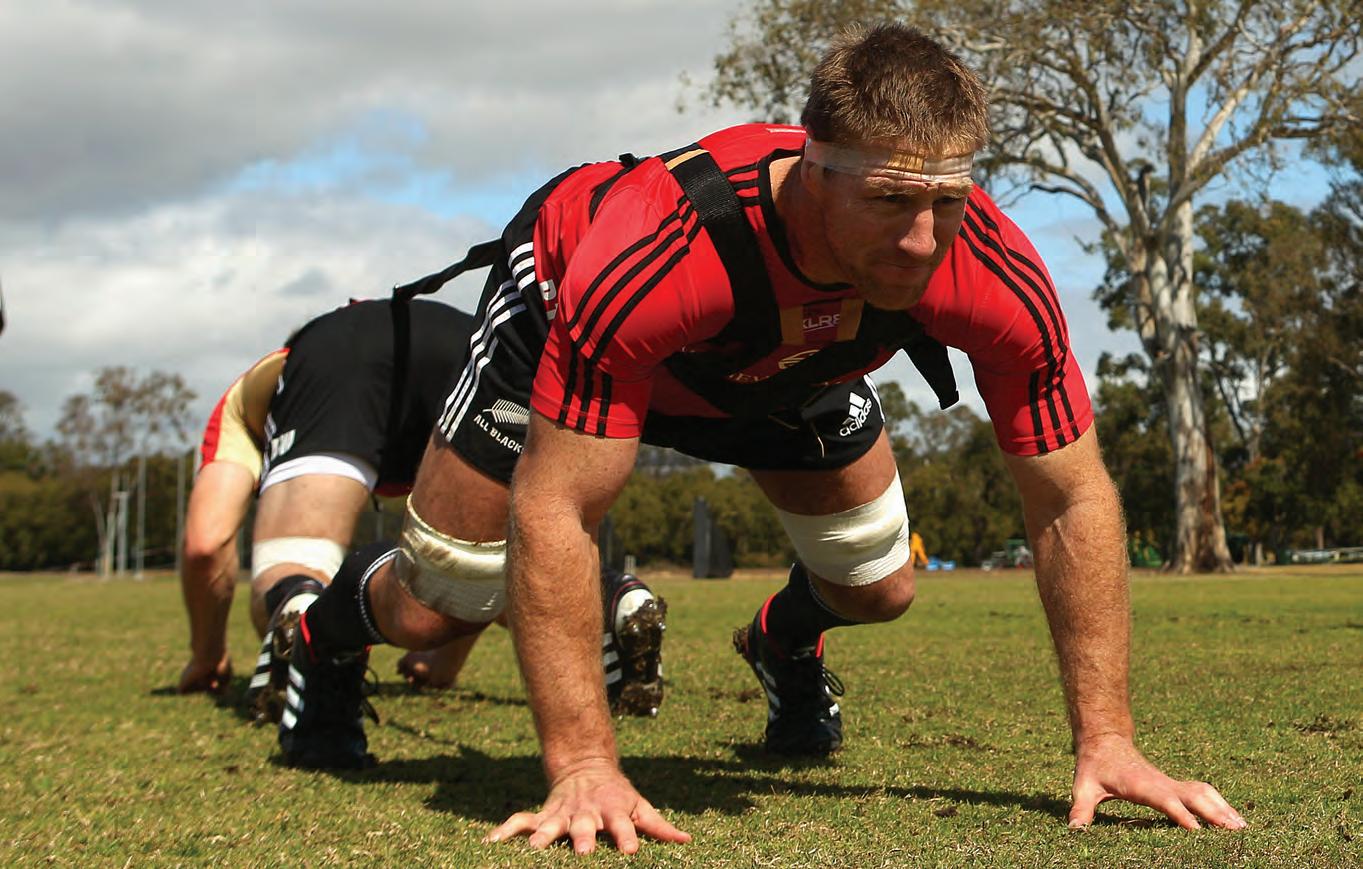
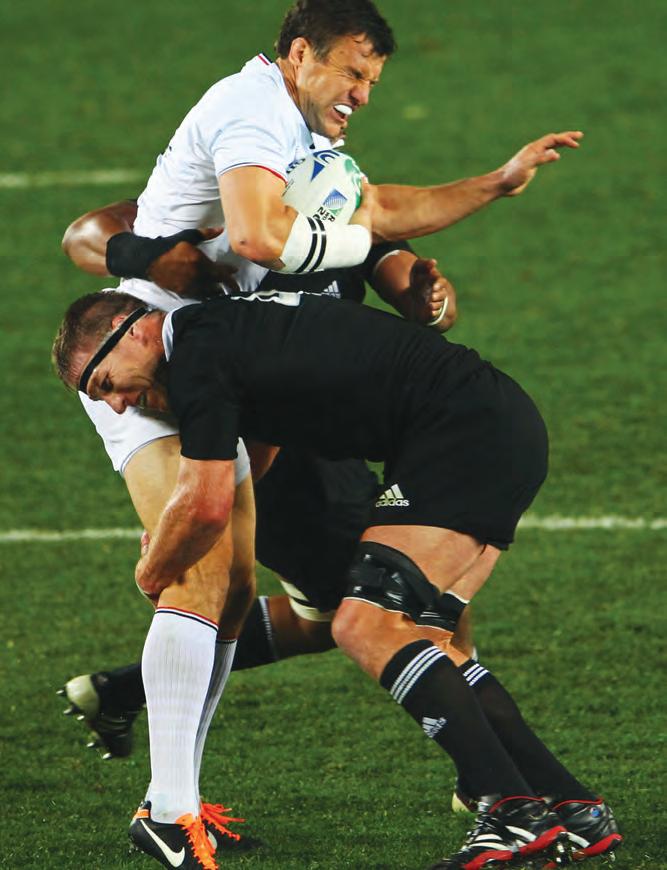
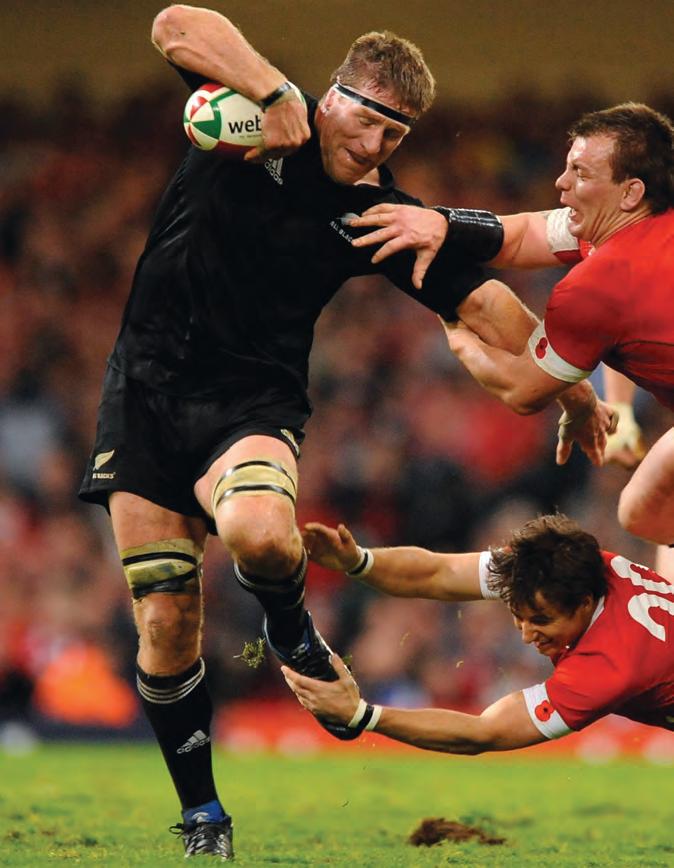
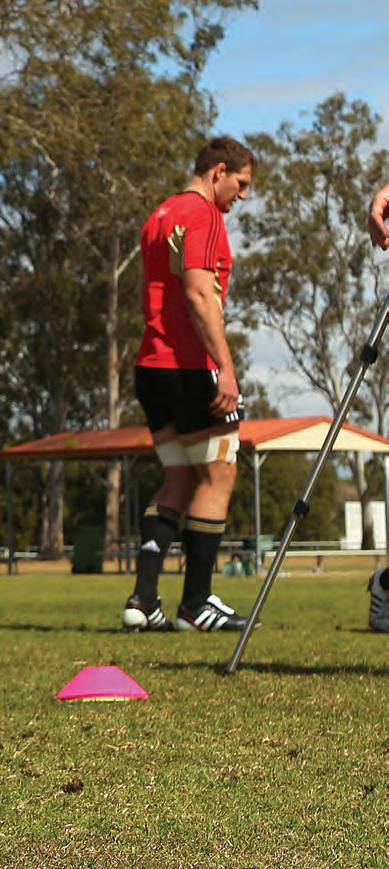
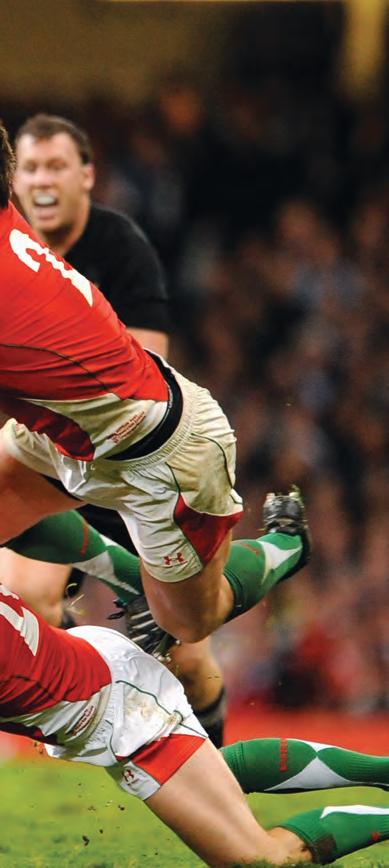
Hansen says that, much like Richie McCaw, Thorn changed how Canterbury trained by lifting the level of intensity.
“He was training to dominate and the first live tackling session we did, he cut Mark Hammett in half. You could see everyone looking at each other and thinking, ‘OK, this is where we are at.’ The whole level of training went up. McCaw is the only other athlete I’ve seen do that.”
In game, he simplified his role, focusing on power scrummaging, defence and cleaning rucks. He was such a strong scrummager, his tighthead props demanded he never switched sides and his ruck work was terrifying.
“He loved to carry the ball, but I feel he had more joy out of hitting rucks,” says Keven Mealamu. “It wasn’t always the stuff that was seen, but his presence was always felt.”
The influence was strong on a young Sam Whitelock, who thought he was fit and strong until he saw what Brad was doing in the gym and how he prepared himself for the rigours of contact sport.
“Thorny set my career up. I can’t put it any more simply than that,” he wrote in his autobiography, View From the Second Row
“HE LOVED TO CARRY THE BALL, BUT I FEEL HE HAD MORE JOY OUT OF HITTING RUCKS,” SAYS KEVEN MEALAMU. “IT WASN’T ALWAYS THE STUFF THAT WAS SEEN, BUT HIS PRESENCE WAS ALWAYS FELT.”
“I was lucky to run into good people at the right time in my career — like Brad. He was a guy who didn’t say his body was a temple, he lived that idea fully. He set a great example that I tried to follow.”
Thorn was born in Mosgiel, just outside Dunedin, and moved to Central Otago when he was five, and then to Australia aged nine. League became his passion and when he made the Broncos aged 19, they were the defending champions.
He quickly rose to their level, named the club’s best rookie in 1994, playing alongside legendary prop Glenn Lazarus, who he cites as an influence.
He learnt a lot about life and professional sport under the intense Brisbane media glare.
“I was signed at high school and was getting paid by the Broncos at 17. Within a couple of years I was playing for them. All of a sudden you’ve got money, you can buy a house, you’ve got a car, people are patting you on the back, your ego’s soaring and the ladies are noticing you more,” he told me in 2009. “It’s a full-on thing and you can’t prepare yourself for that. As a kid at school, to get paid that sort of money, it can test your character. Sometimes it can be hard for different guys.
“It’s important to have good support around the players when they come into the team and hopefully senior players who are good role models.”
Early support for Thorn came from Kangaroos teammate Jason Stevens who convinced him in 1998 to embrace Christianity. And, a few years later, he essentially cut alcohol out of his life, drinking only for special occasions and only in moderation.
“Drinking in moderation is the best scenario, in my opinion, but if that’s something you can’t sort out then it’s best you leave it alone all together,” he said in 2009. “I was probably a bit of a binge drinker. I was one of those guys who, once you’ve had a few, you keep going till you’ve had too much.
“When you do that you are susceptible to all sorts of stuff happening, whether it’s chasing the ladies or whatever. When I became a Christian in ’98… I really felt like there were some things I needed to sort out in my life and one of them was boozing. For about a three-year period, each year I slowed down a bit. The first year it was a bit, the second year a bit more and by the third I’d really started to slow down.”
Mealamu, himself a devout Christian and teetotaller, says the All Blacks benefited from Thorn’s league experiences.

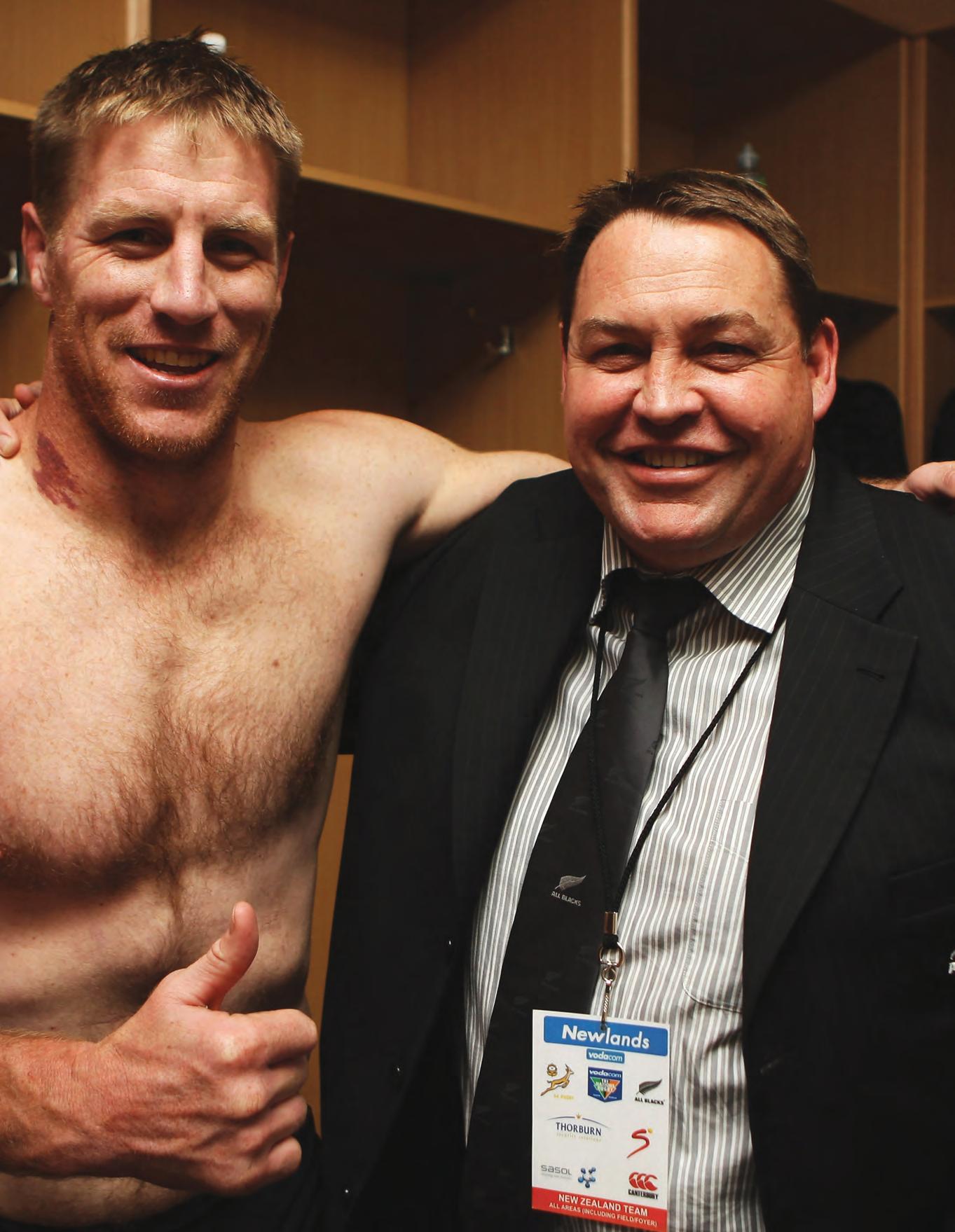
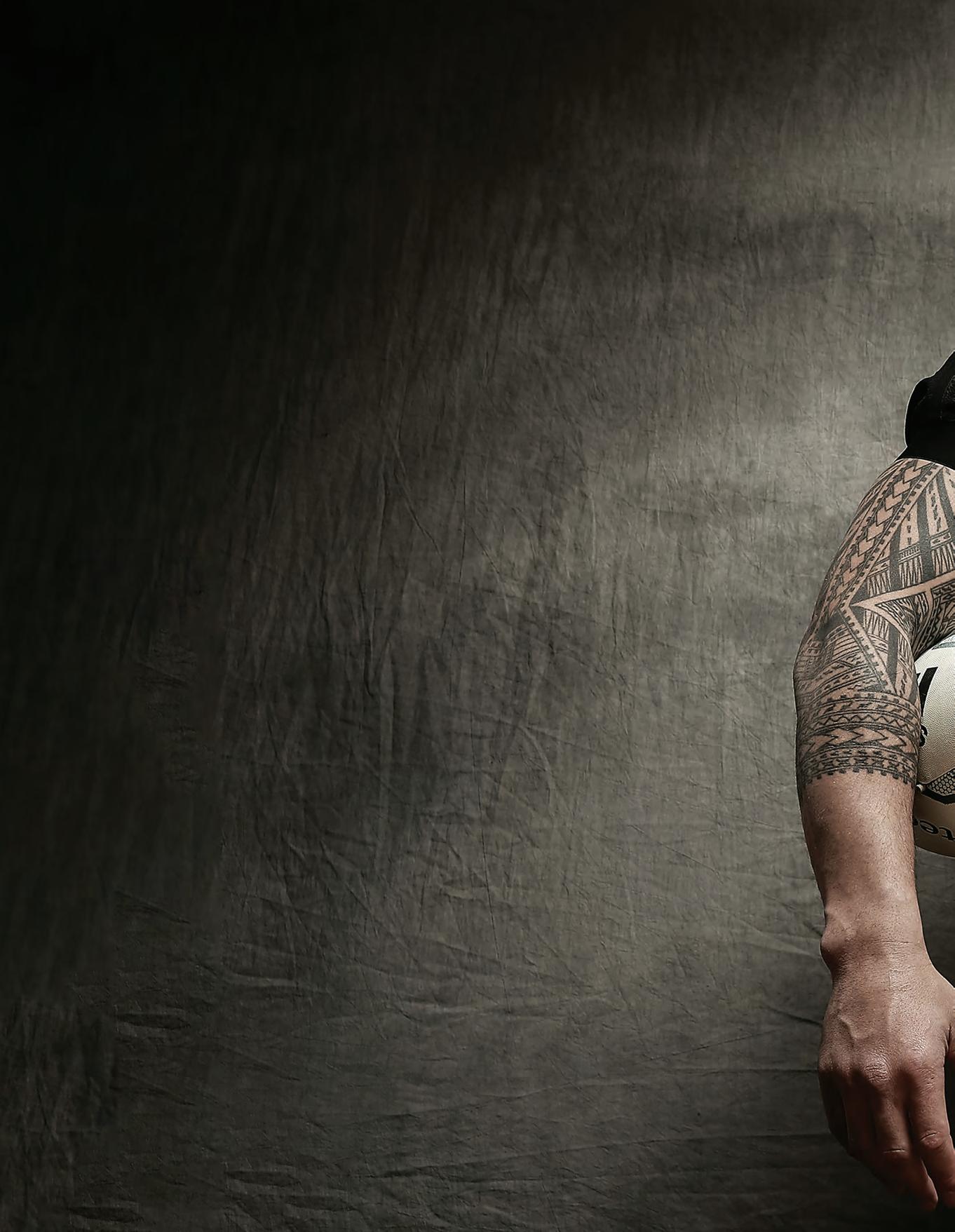
EXPLOSIVE ON THE FIELD AND VERY MUCH HIS OWN MAN OFF IT, SONNY BILL WILLIAMS HAD A SIGNIFICANT IMPACT ON HOW THE MODERN GAME IS PLAYED, BUT ALSO HOW ATHLETES REPRESENT THEMSELVES.
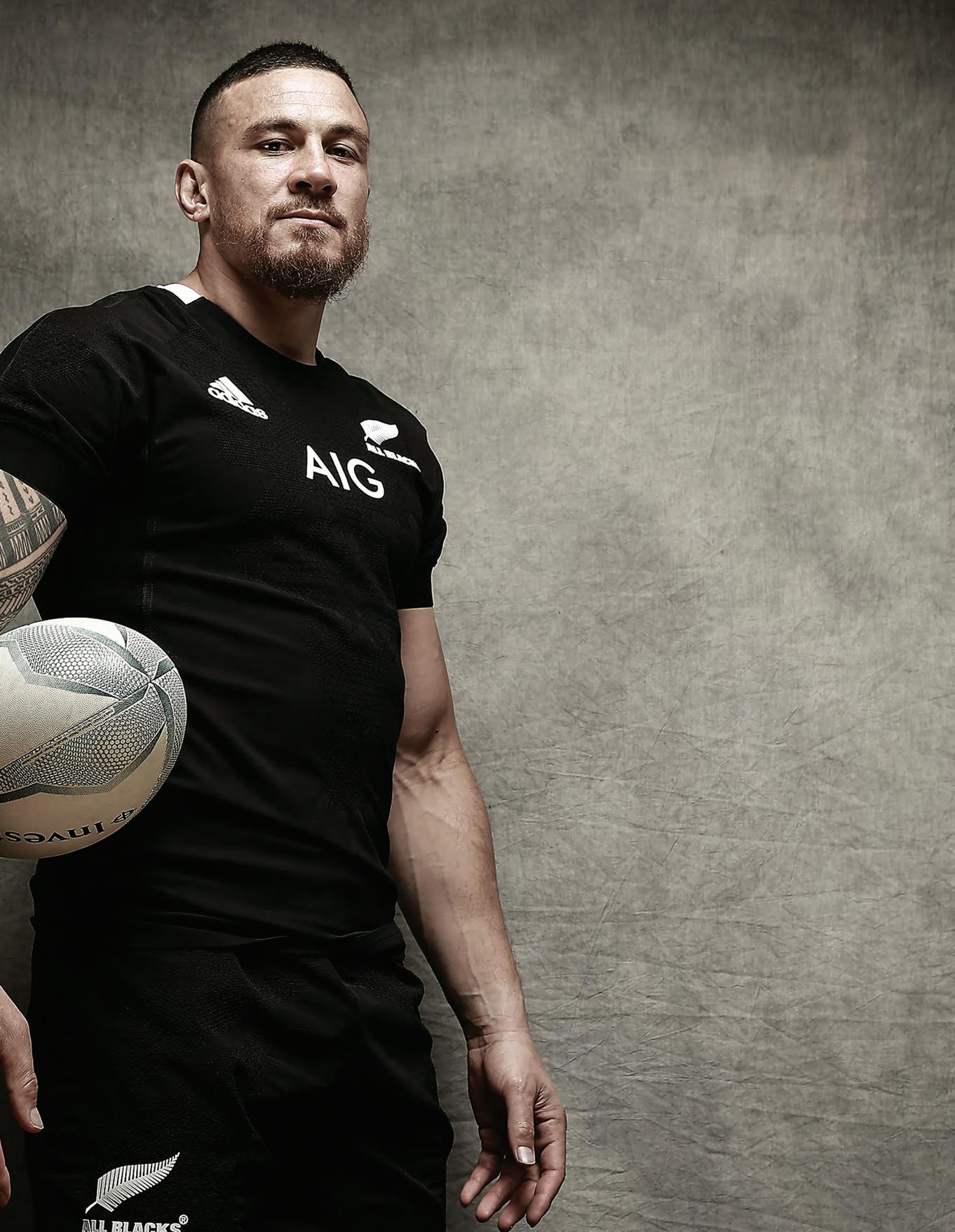
Wayne Smith had low expectations when he sat down for a coffee with Sonny Bill Williams and his manager Khoder Nasser at a cafe in Toulon.
“We had heard a rumour that he might be interested in being an All Black,” Smith, who was sent to France in 2009 to see if there was fire behind the smoke, says. “I expected these guys to be after [a big number], and we wouldn’t be able to compete.”
Smith, who was then All Blacks assistant coach, had been told by New Zealand Rugby what he could offer and he was almost embarrassed to table it.
“It was probably about 10 per cent of what he was on at Toulon but neither of them blinked. They said, ‘Don’t worry about the money, that’s not important.’ It was all about the dream of being an All Black, so I knew it was obviously a rugby choice.”
There was one caveat: Williams wanted to be able to box professionally, adding a third sport to an amazing career.
“It takes a special athlete to do two contact sports at the same time, both physically and mentally,” Smith, who was coaching Williams at the Chiefs when he first fought, said. “His work ethic is amazing.”
Williams won the New Zealand heavyweight title and also claimed the World Boxing Association International Heavyweight title in 2013, though the latter was in controversial, near-farcical circumstances over South African veteran Francois Botha. The White Buffalo had Williams on the ropes before the fight was called off after 10 rounds, with Botha claiming it was scheduled as a 12-round fight and Willams saying they had agreed to 10. It transpired that both camps had agreed to switch to a 10-round fight shortly before it started, but Botha’s trainers did not inform the fighter.
Born 3 August 1985 in Auckland, New Zealand
All Black 1108 All Blacks Test Debut Saturday, 6 November 2010 v England at London aged 25 years, 95 days Test Caps 58 Test Positions
Second-five, centre, wing High School
Mt Albert Grammar Club Belfast
While it is fair to say that Williams’ 9-1 boxing career never rose to great heights, the titles added to a dazzling array of achievement in an athletic career that saw the man, dubbed SBW, become the youngest player to sign with an NRL club when he put pen to paper with Canterbury-Bankstown, aged just 14. He played first-grade with the club aged 18, and became the youngest Kiwis international at 19.
Across two stints in the NRL he played 123 matches as a forward and 12 tests for the Kiwis. In rugby, as a midfielder and wing, he played 58 tests for the All Blacks and more than 100 games combined of Super Rugby, NPC, Japan Top League and France’s Top 14, as well as seven games for the All Blacks Sevens.
But it’s what he did in those jerseys that sets Williams apart. He helped his teams win a lot of titles — an NRL premiership with the Bulldogs, an NPC win with Canterbury, a Super Rugby championship with the Chiefs, an NRL premiership with the Roosters and two World Cups with the All Blacks.


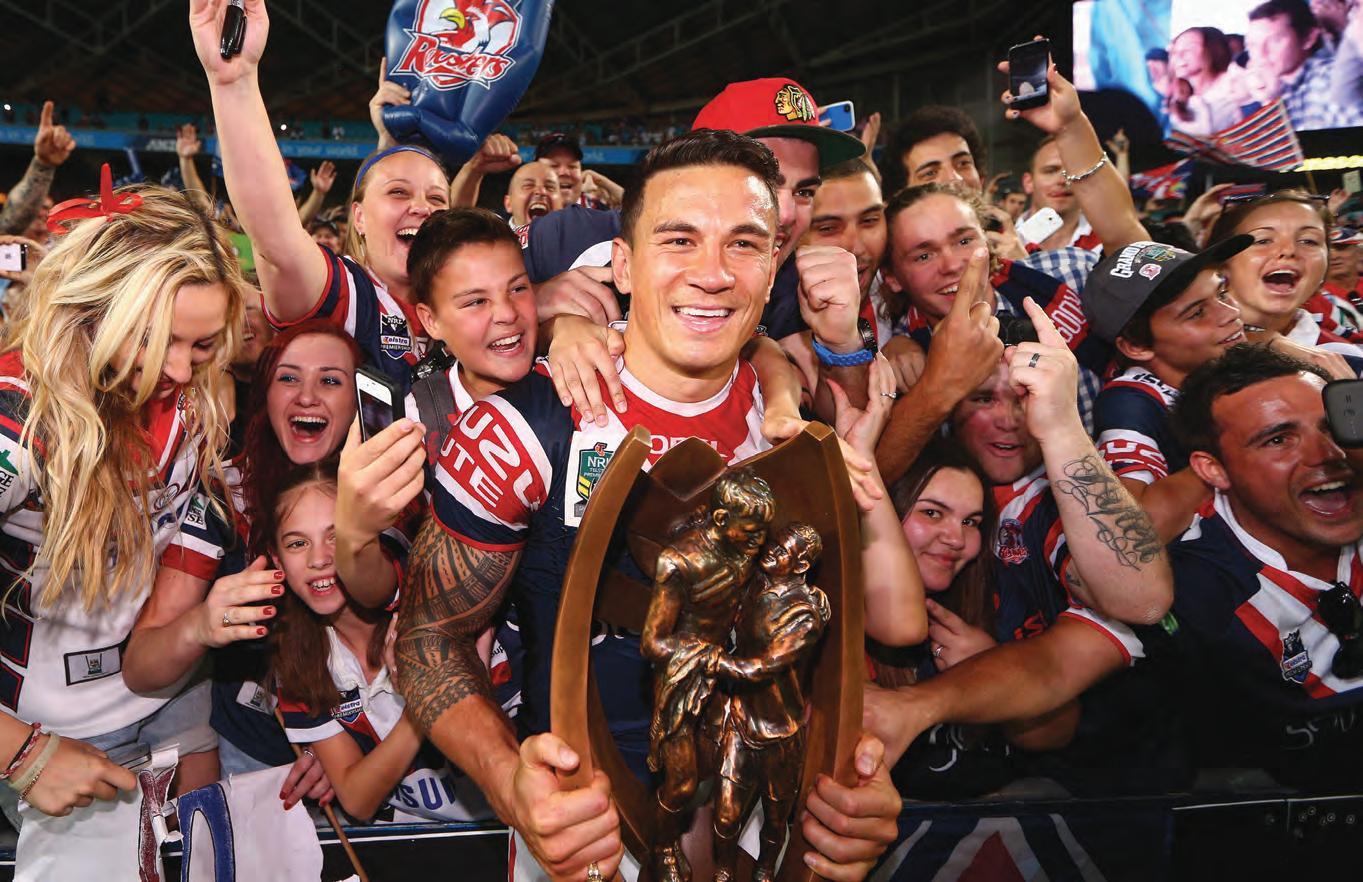
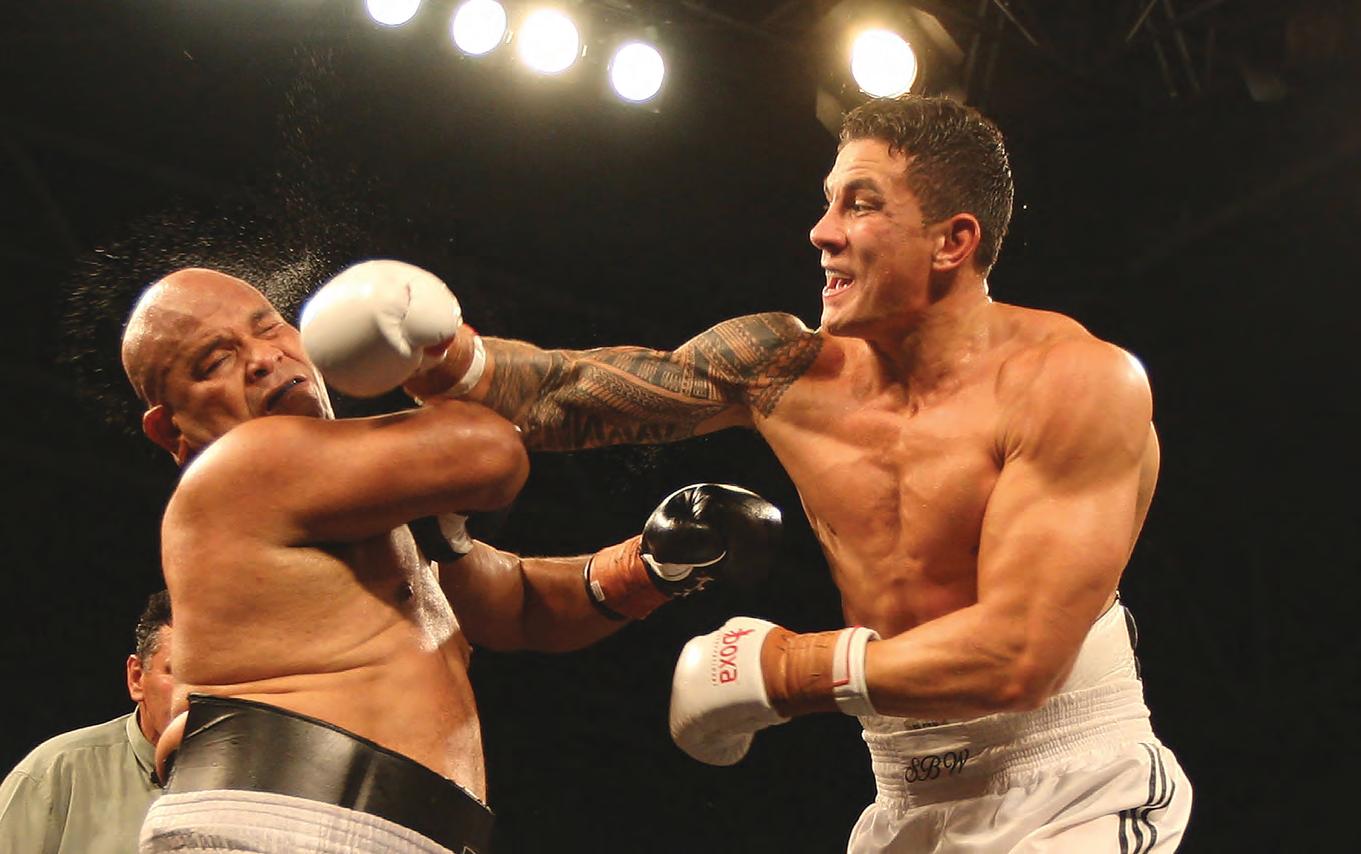
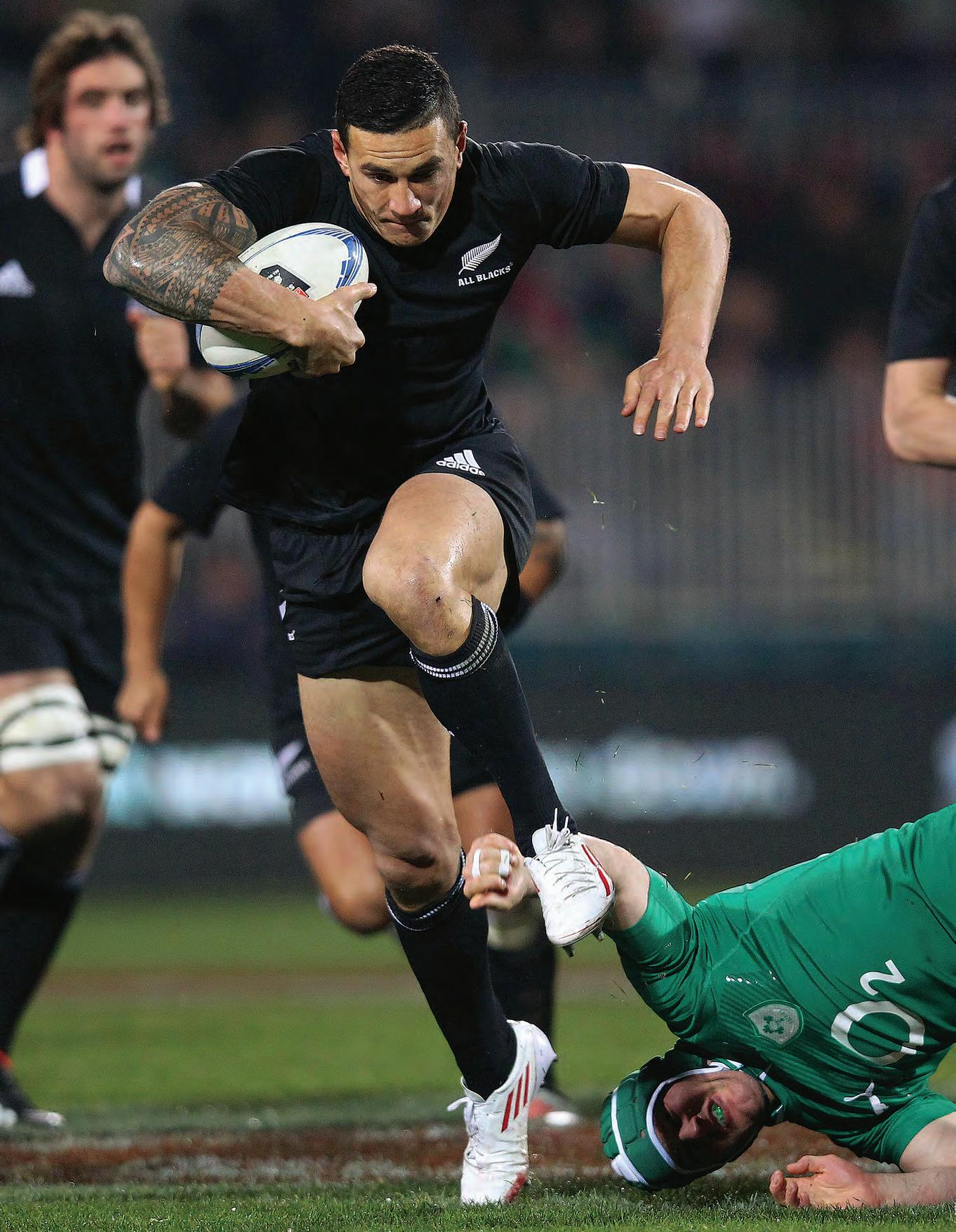

As a player he revolutionised passing in contact. A tall man at 1.91m, Williams was able to stand in tackles and offload the ball, often out of the back of his hand, at times throwing long, audacious passes either just before the tackle or in it.
In just his second rugby test, against Scotland at Murrayfield, he shocked Smith and his coaching colleagues with a pass that would not be found in any coaching textbook when he threw a long cutout pass, out of the back of his hand, to Hosea Gear who scored. Even attempting such a pass was frowned upon in an increasingly risk-averse rugby environment, but Smith says Williams “changed the world, not his pass”.
“He had this inbuilt mechanism to have a crack, to run hard and straight at the line and to keep the ball alive.”
While he was phenomenally successful, Williams was also polarising. In 2011, he skipped the All Blacks’ victory parades after their World Cup win, a move that infuriated Sir Graham Henry. His frustrations with the second five-eighth were not restricted to the parade no-shows and he declined to be interviewed about Williams for this magazine.
Williams and Nasser were always firm in their belief he should start for the All Blacks, with the latter often berating Henry and his successor, Sir Steve Hansen, when Williams was on the bench or, worse, out of the 23. Rugby’s ethos was very much based in keeping your head down and taking your lumps in silence, so Nasser’s outbursts were a culture shock.
The cross-code star did not show himself in the best light in 2013 when he made himself unavailable for the Kiwis’

World Cup campaign, then performed an about-face once the team had been named, putting coach Stephen Kearney in the awkward position of having to deselect Tohu Harris.
Williams boomeranged back to rugby to play at the 2015 tournament. It was a surprise to many when he replaced Conrad Smith at halftime in the World Cup final against Australia (nobody was as surprised as Smith himself), though Hansen claims the offload to Ma’a Nonu for a key try immediately after halftime was the greatest Williams ever made.
He capped off his evening’s work by giving his winners’ medal away to a distressed young lad who was tackled
by security when he ran on the field at Twickenham after the game. It was a gesture that captured global headlines and garnered him an international Fair Play award. When collecting the award, Williams said: “Obviously I thought I saw a child that was a little bit hurt. It kind of touched me on my inside. I just did what I thought was right.”
Two years later he was in the headlines for the wrong reason, becoming the first All Black since Sir Colin Meads in 1967 to be sent off in a test match, and first to suffer that fate in New Zealand, when he was dispatched for a head-high shoulder charge in the second test against the British and Irish Lions. While the correct decision, the shoulder charge was almost a nod to his league

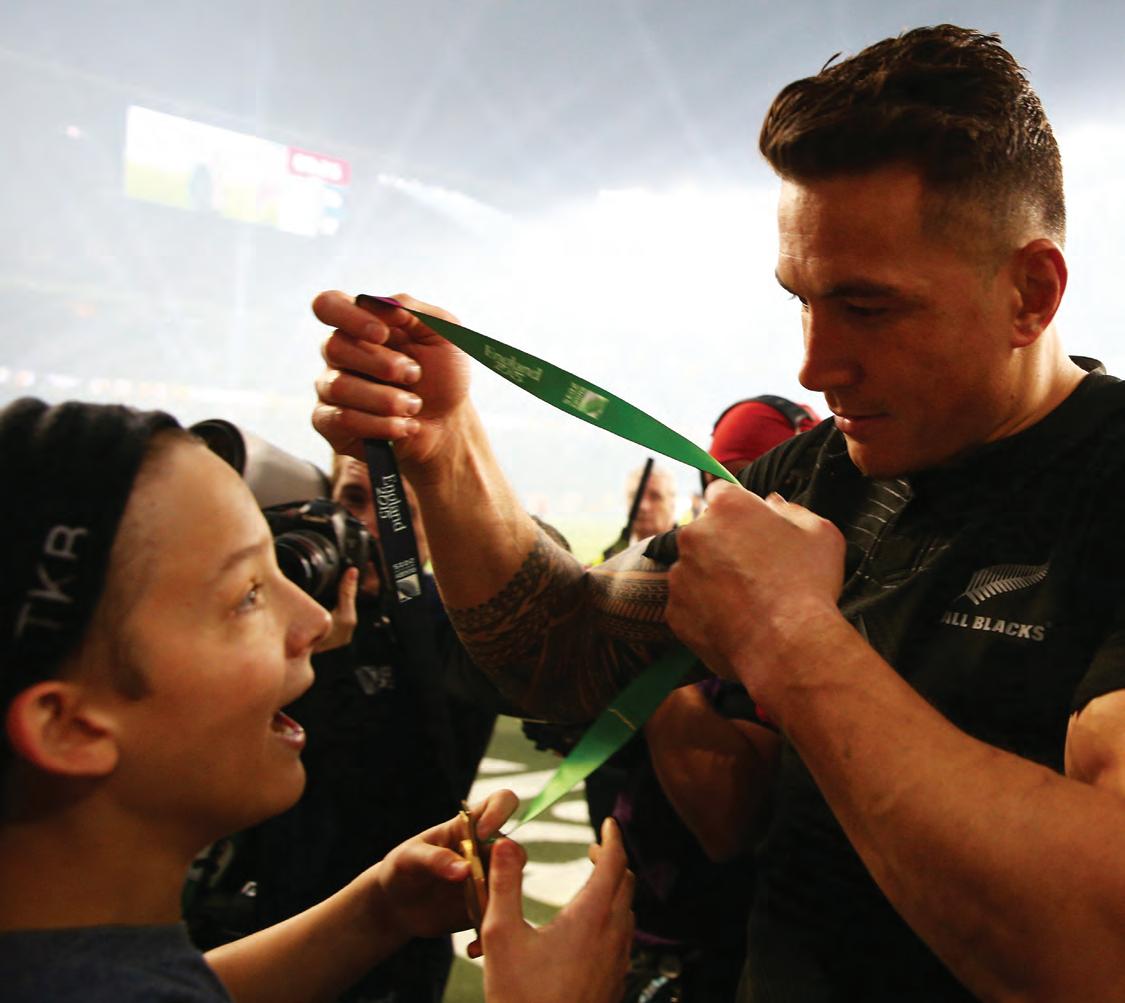
“HE CAPPED OFF HIS EVENING’S WORK BY GIVING HIS WORLD CUP WINNERS’ MEDAL AWAY TO A DISTRESSED YOUNG LAD WHO WAS TACKLED BY SECURITY WHEN HE RAN ON THE FIELD AT TWICKENHAM AFTER THE GAME. IT WAS A GESTURE THAT CAPTURED GLOBAL HEADLINES AND GARNERED HIM AN INTERNATIONAL FAIR PLAY AWARD.”
background, where the no-arms tackle was only outlawed ahead of the 2013 season.
Williams grew up in Auckland and attended Mount Albert Grammar and while he played rugby at school, league was his first love. Having made his way through the ranks of the Marist Saints club, his talent was spotted by renowned league scout John Ackland who alerted Canterbury-Bankstown. Williams quickly established himself as a superstar in Sydney with all the glitz, glamour and gossip that goes with the sport in that city.
The love affair between Williams and the Bulldogs looked set to be a long one when he signed a five-year contract extension ahead of the 2007 season. The following year, however, he sensationally walked out on the club midway through the season, chased through Sydney airport by TV news crews on his way to play rugby for Toulon in France.
He has since said he struggled with the lifestyle and limelight of being an NRL player.
“The party culture, the money, the access to drugs and alcohol. I was wrestling with it, but I wasn’t saying no. I was selfish, and I had no-one to answer to.”
As controversial as Williams could be off the field, he was all business on it and his attitude and dedication to training, his game preparation and other essential elements like diet and rehabilitation rubbed off on his teammates. In some respects he was a literal game changer in that his ability to pass the ball in contact almost made those, whose stock in trade was to scythe runners down by tackling around the legs, redundant. Players like Williams made the ball-and-all tackle the only truly effective defensive technique at the top level.
Keven Mealamu had been a fan of Williams when he was with the Bulldogs and admits to being slightly in awe when he played against him, and then with him, in rugby.
“Normally when someone changes codes there is a transition period, but he just brought all the attributes he had in league straight to rugby and that’s what made him stand out. His offload changed the way the game is played because when he started doing that every youngster in club rugby tried to do the same thing.”
Since retiring from rugby and league, Williams has been a commentator for Australia’s Stan Sport and Channel Nine.

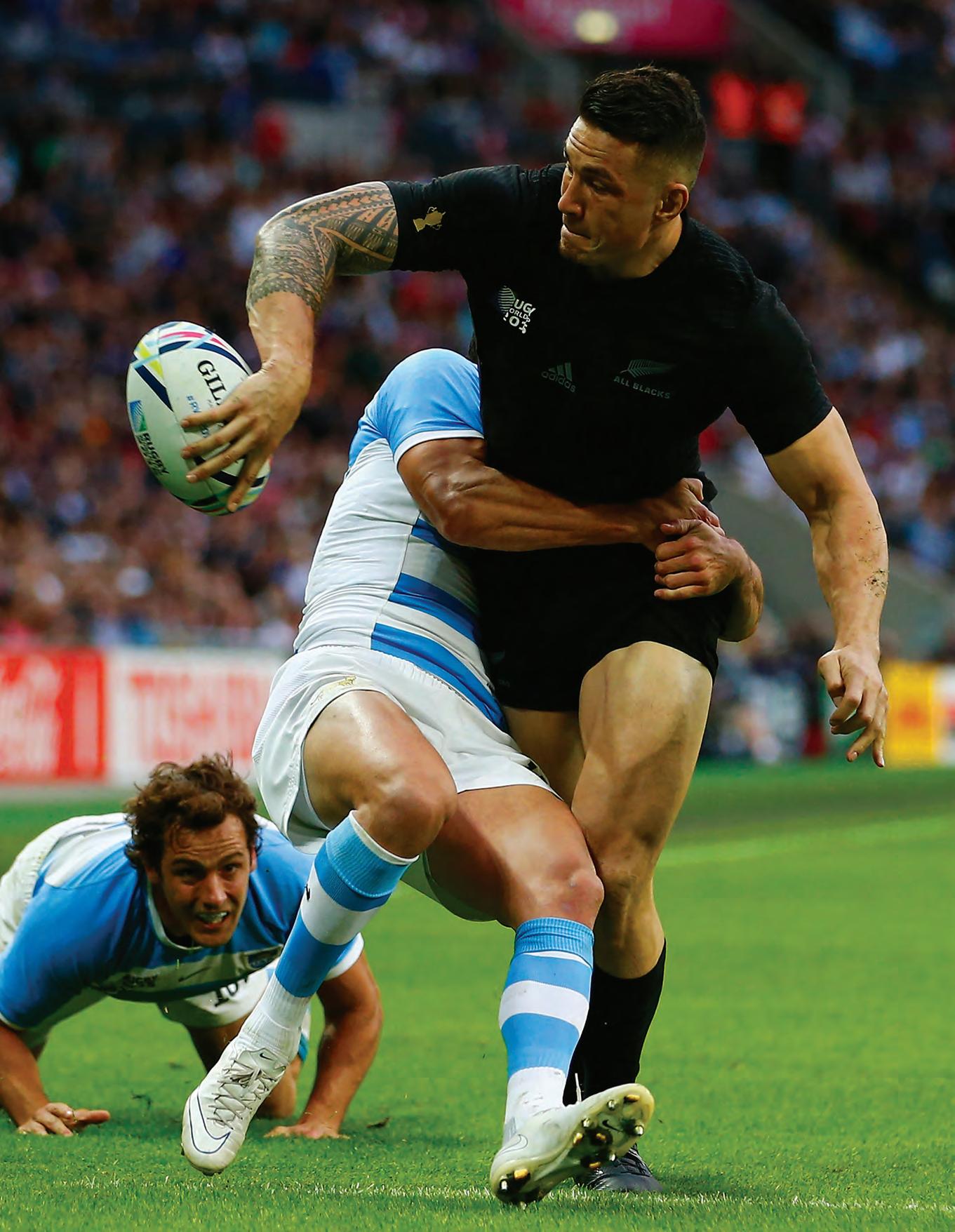
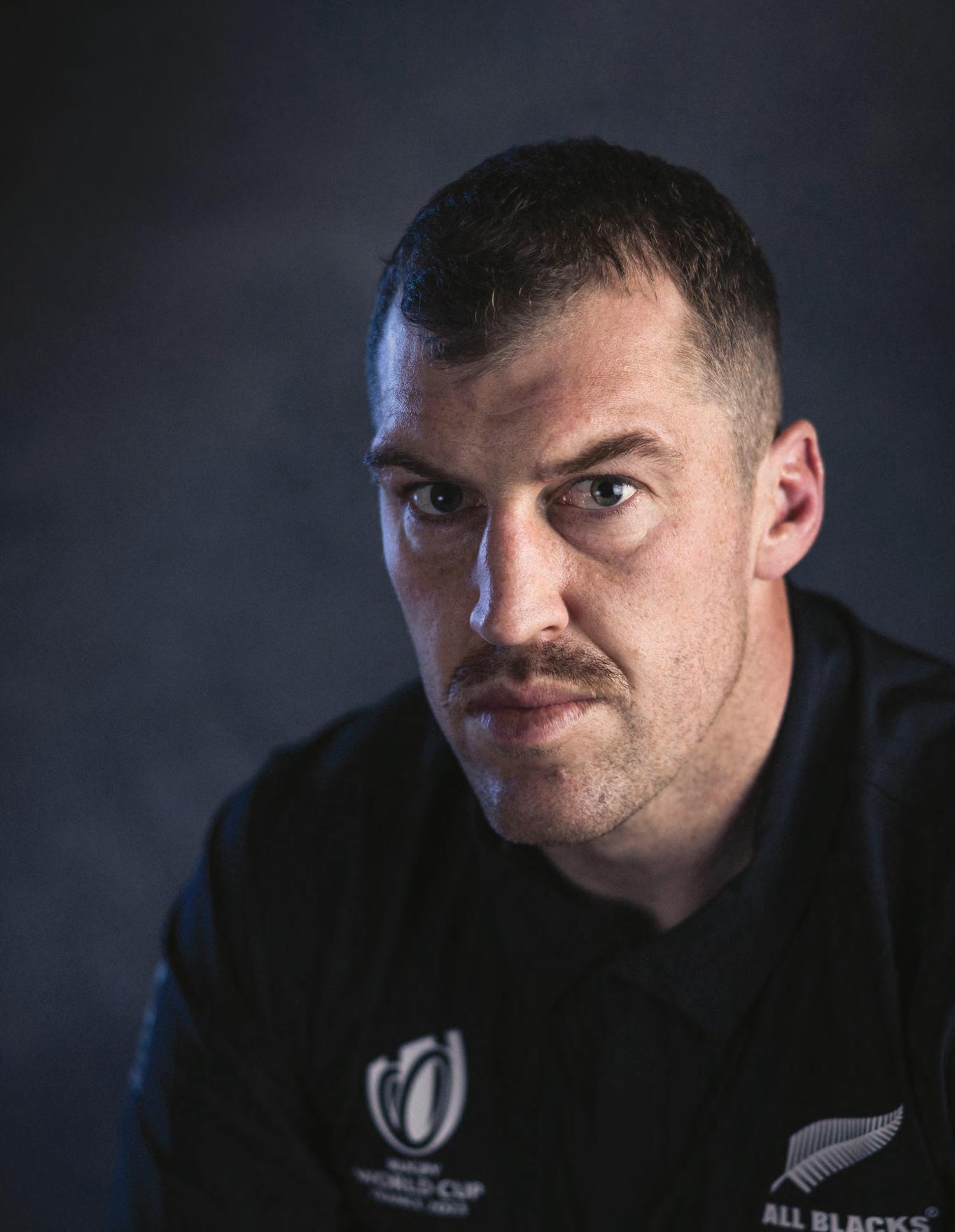

BRODIE RETALLICK WAS OFTEN COMPARED TO SIR COLIN MEADS AS A BIG, FAST, SKILFUL AND BRUTAL BALL-RUNNING LOCK, AND THE PAIR IN 2021 WERE PICKED AS THE ALL BLACKS GREATEST LOCKS.
Brodie Retallick is the one that got away.
Twice.
The big All Blacks lock carved a career for himself with the Chiefs after making his first-class debut at Hawke’s Bay.
Born in Rangiora and educated at Christchurch Boys’ High School, Retallick was somehow missed by the eagle-eyed scouts at Canterbury and the Crusaders.
As Retallick was finishing his final year, 1st XV coach Richard Taylor suggested he have a chat with Tom Coventry, who was coaching Hawke’s Bay. With nothing on offer from Canterbury, he was tempted by the promise of a little bit of money as an academy player, and a place at polytech studying fabricating and welding.
If rejection from his home province stung at the time, in hindsight Retallick wasn’t critical of Canterbury’s oversight.
“I was a 128kg lock who didn’t jump and was too heavy to lift,” he says.
Hawke’s Bay quickly became home and under Coventry he began to impress to the point that when the former Waikato loose forward shifted to the Chiefs to assist Dave Rennie, he lured Retallick north again, this time from under the noses of the Hurricanes.
Born 31 May 1991
in Rangiora, New Zealand
All Black 1110
All Blacks Test Debut Saturday, 9 June 2012 v Ireland at Auckland aged 21 years, 9 days
Test Caps 109
Test Positions Lock High School
Christchurch Boys’ High School
Club Central Hawke’s Bay
Rugby Sports Club
Few have missed noticing the talents of the 2.04m tall Retallick in the years since. He quickly became one of New Zealand’s best locks, with a reputation for being as brutal on the training field as he was on the playing pitch.
“I just don’t like to lose. I will always remember my first year at the Chiefs and Romana Graham, when we were doing lineout drives, twice pulled me out in the air. I fell on the ground, couldn’t set up the maul because of that and Tom Coventry just said, ‘You’re out, Romana you’re in.’ There is a lesson there that sport is competitive and if you want to come out on top sometimes you have to do what you have to do.”
What Retallick did, across 109 tests, was combine the deft skills of a back with the brutal defence and clean-outs of a player like Brad Thorn. He was ruthless around the ruck, resembling a torpedo as he cleared opposition players off the ball, and he was not someone you wanted to be tackled by as he was all elbows and shoulders.
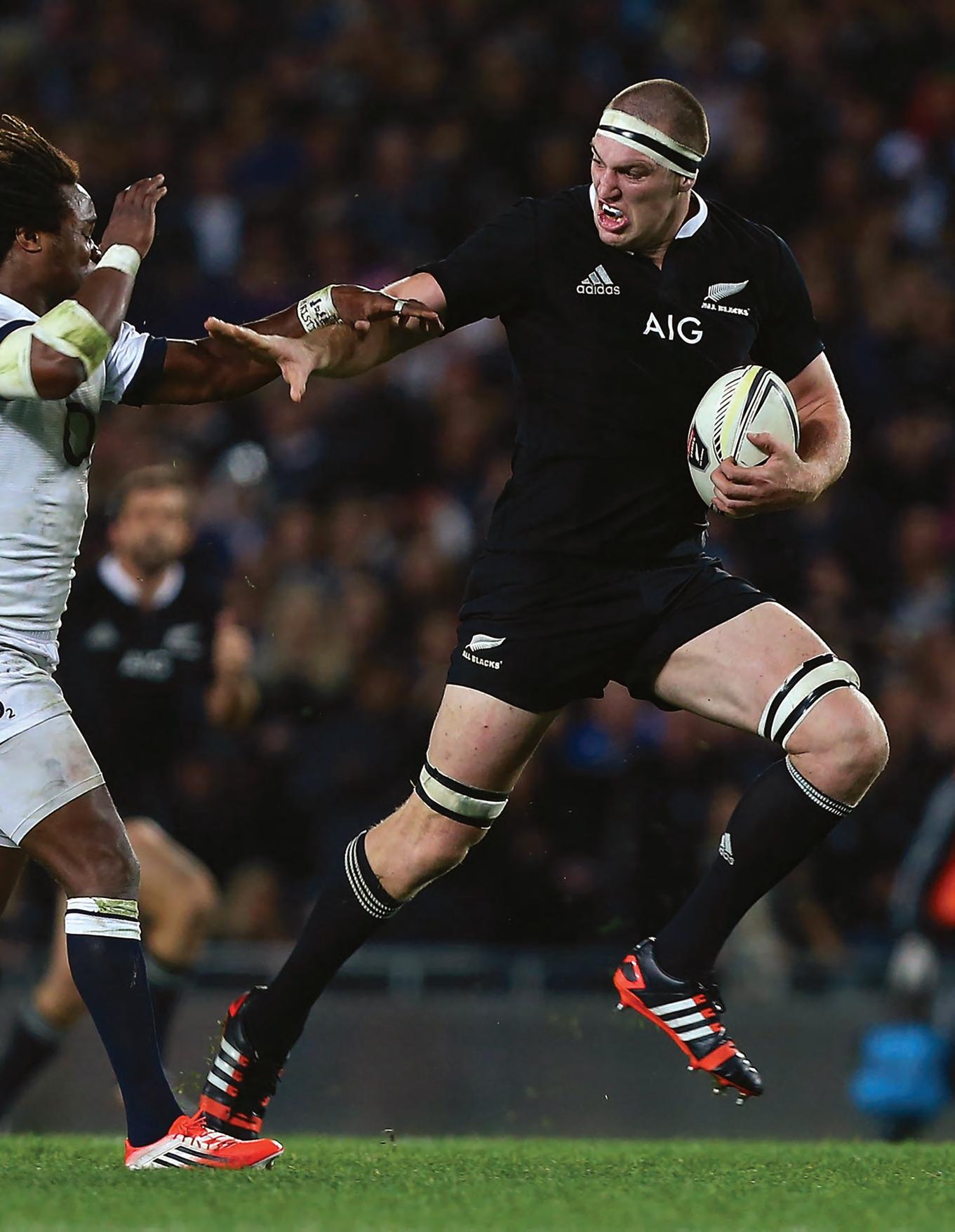
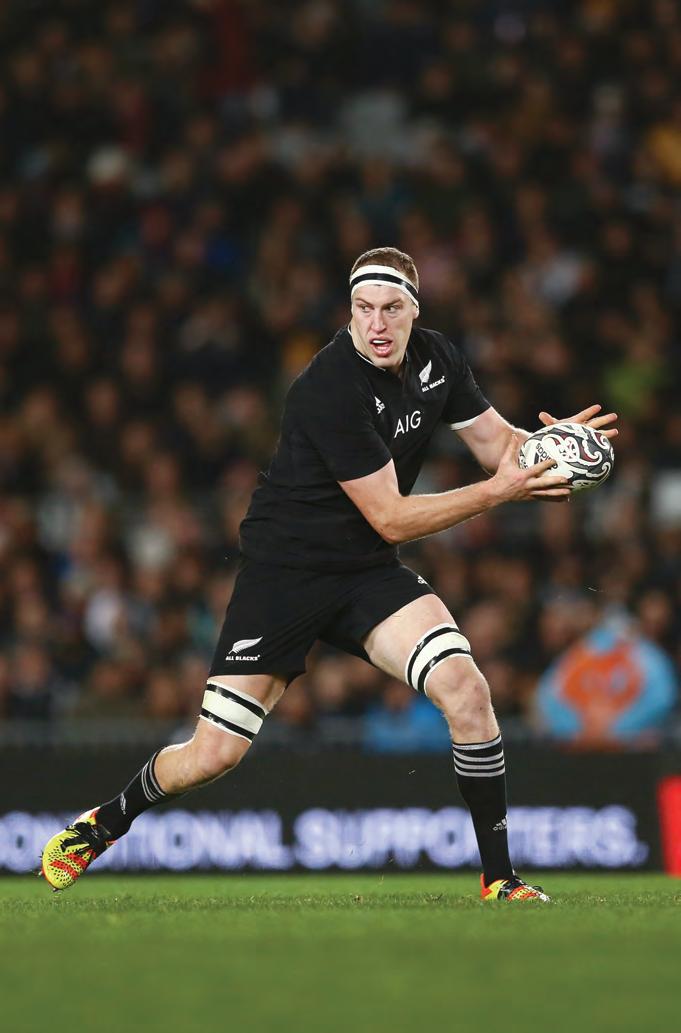

His finer skills were never better shown than in driving rain in Napier in 2014, when he burst through the line to chase a Beauden Barrett grubber kick, scooped it up at bootstrap level, pirouetted to beat a tackler and then went to ground to present quick ball at the ruck, that was eventually turned into a Julian Savea try.
“It’s not very often that you get the combination of brutality and skill,” former All Blacks coach Sir Steve Hansen says. “Usually they are one or the other and that’s what makes Brodie unique because he is certainly brutal and he’s certainly skilled. We had a big man who could catch and pass, and play like a back, and also does his core roles as a lock to a world-class level.
“It’s a real advantage when you have a guy of his size in the backline from second or third phase, who can slip a ball out the back and put people into space. There’s not many people over the years who could do that — you could count them on one hand probably.”
Sir Colin Meads would be on that one hand, with Retallick often compared to the great Pinetree. They were named the greatest All Blacks lock by a Sky Sport expert panel and public vote in 2021.
“Meads was the pinnacle,” says another All Blacks great, Sir Michael Jones, “and there’s a lot about Brodie that speaks to a modern-day Sir Colin. The ruggedness, the


“MEADS WAS THE PINNACLE,” SAYS ANOTHER ALL BLACKS GREAT, SIR MICHAEL JONES, “AND THERE’S A LOT ABOUT BRODIE THAT SPEAKS TO A MODERN-DAY SIR COLIN.”
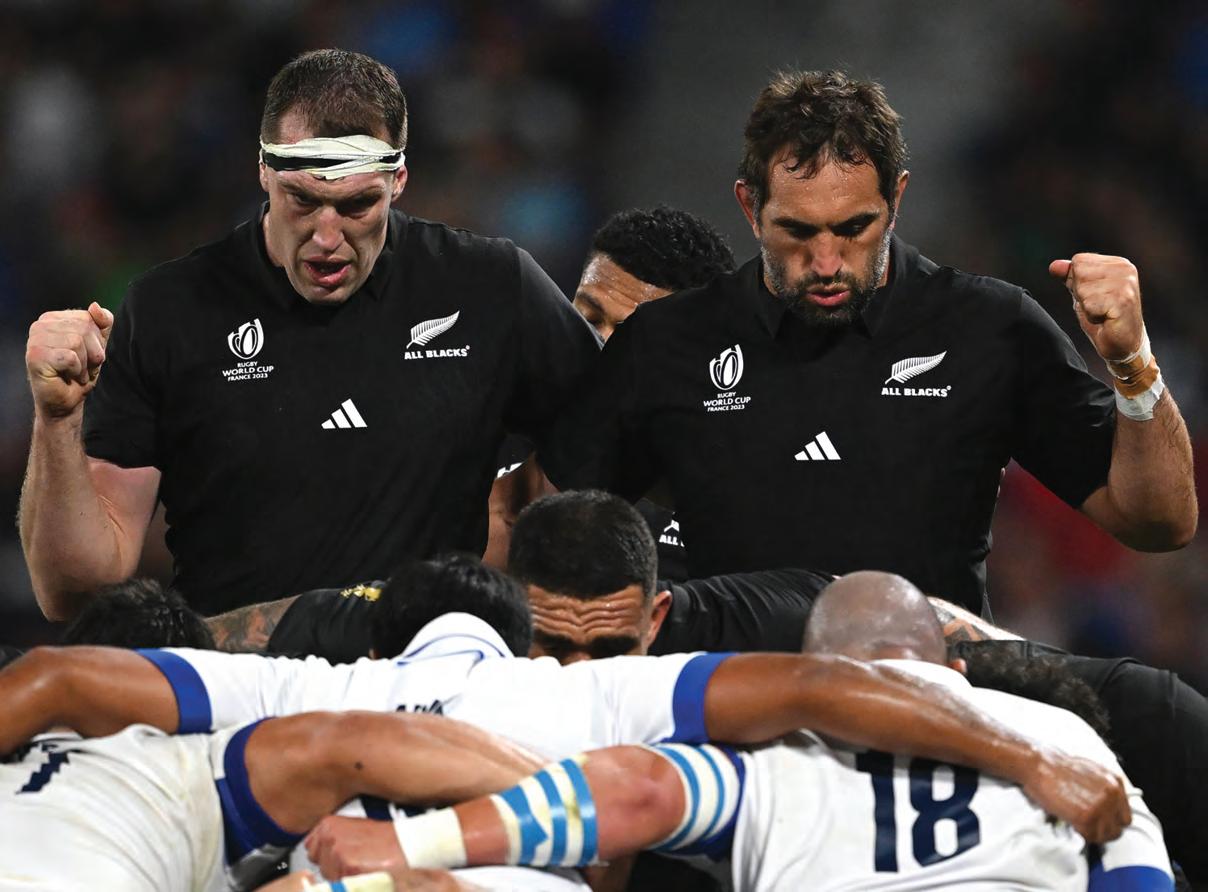
toughness, the mental resilience and the way he’s come back from injury. He [was] a very, very special player.”
Retallick debuted for the All Blacks against Ireland in 2012 and played in all 13 tests that year, backing it up with 11 the following year. In 2014, he was crowned World Rugby’s Player of the Year, the only lock to achieve the honour and only the second tight forward alongside Ireland’s Keith Wood. In 2018, Retallick was awarded the World Rugby Try of the Year Award after his incredible dummy earned him five points — he finished his career with nine test tries — against Australia in the opening Bledisloe Cup test in Sydney.
That solo try was a great way to steal the limelight from Sam Whitelock, who was playing his 100th test that night in front of a large crowd of family and friends. The duo have become synonymous with each other, becoming the most-capped locking partnership in history when they
slung arms across each other’s shoulders for the 64th time in Retallick’s 100th test, against England in 2022.
They surpassed legendary Springbok second rowers Bakkies Botha and Victor Matfield and went on to play five more tests together through to the World Cup final the following year.
The pair had an almost telepathic understanding of each other’s game and their strengths complemented each other perfectly. As Whitelock wrote in View From the Second Row: “Brodie Retallick, Guzz. My connection with that bloke needs no further explanation, other than to say we’d reached that stage where we didn’t need to talk to know what each other was thinking.”
Aaron Smith describes Retallick as “120kgs of hurt”, and the great Richie McCaw admits he far preferred playing with him than he did against him.
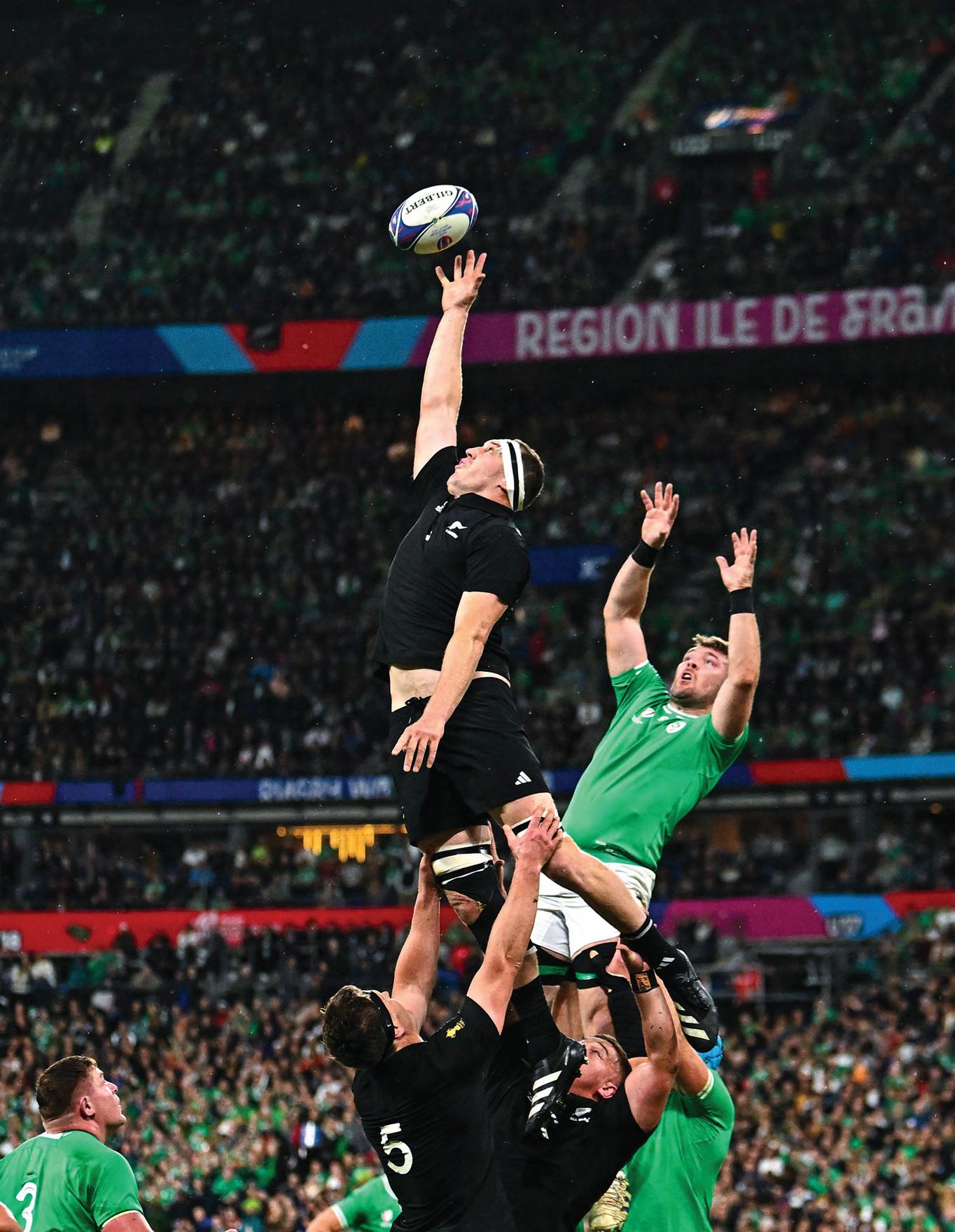

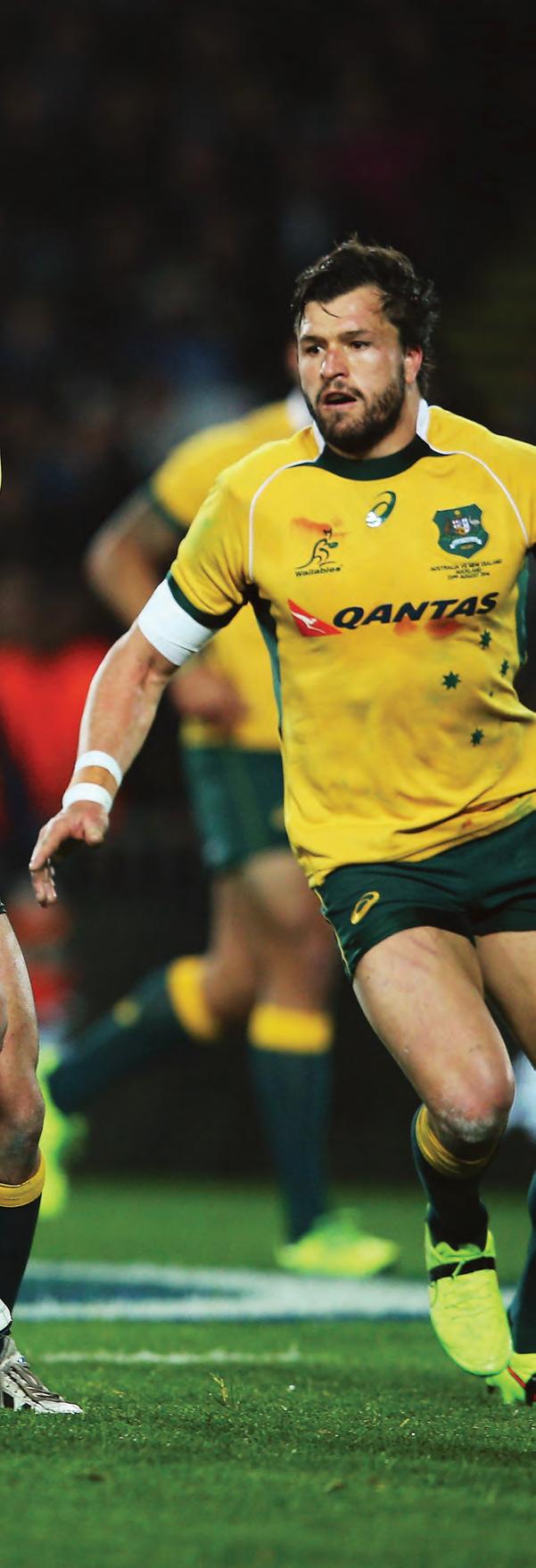
“I loved playing alongside Brodie. He intimidated the opposition because he was a brute of a man to try to tackle, but his skill level for a big man was phenomenal. He could put people into gaps and you’d be lining up getting ready to try to tackle him and then he would put someone away and you’re left standing there wondering what had happened.
“He didn’t try to over complicate things. He was really simple about doing the things he needed to do which was being hard and skilful — he delivered that every time. Having a guy like that in your second row, who put fear into the opposition not just because they were tough but because they were skilful as well, they are the type of people you love going into games with.”
As an opponent?
“HE DIDN’T TRY TO OVER COMPLICATE THINGS. HE WAS REALLY SIMPLE ABOUT DOING THE THINGS HE NEEDED TO DO WHICH WAS BEING HARD AND SKILFUL – HE DELIVERED THAT EVERY TIME.”
“He was awful. He just had that little bit of niggle and it used to wind me up. He just has that winning mentality and whatever is needed he’d do, whether it was a charge down, a big hit, a turnover, a great lineout steal. His ability to impact the game from lock was phenomenal. He’s changed the game.”
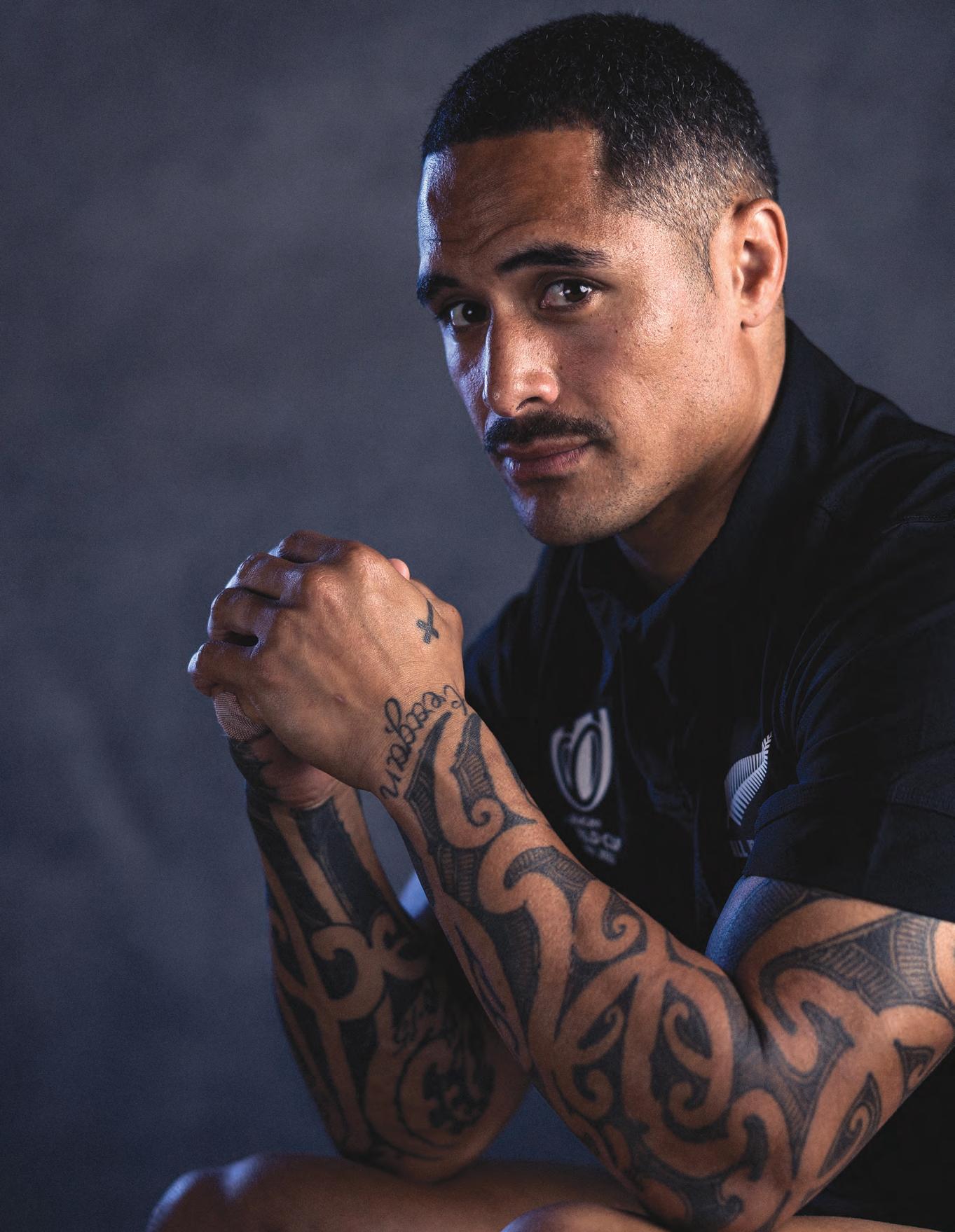
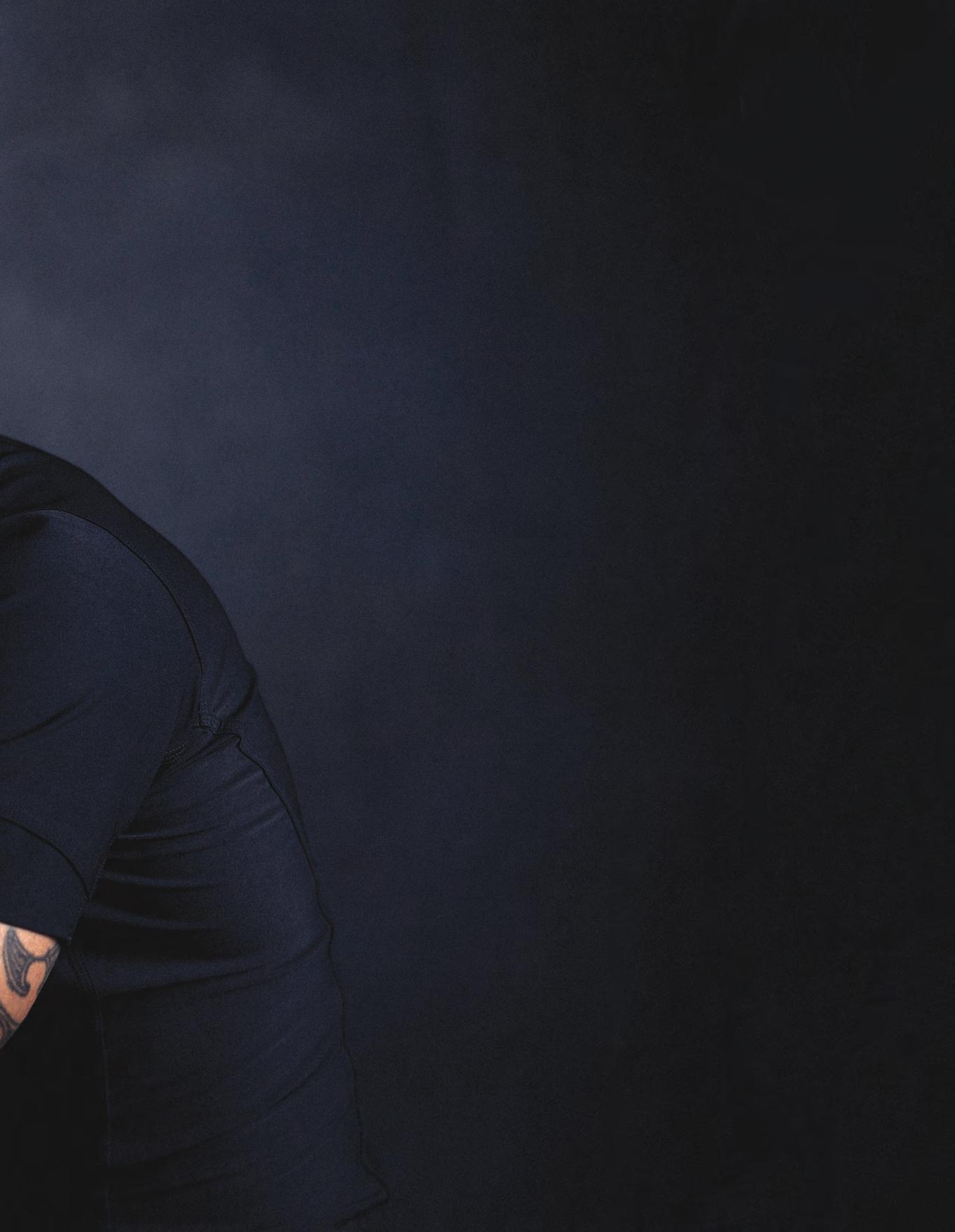
AARON SMITH WAS A SMALL MAN WHO PLAYED A BIG GAME – AND HIS ROCKET PASS CHANGED HOW THE ALL BLACKS WERE ABLE TO ATTACK.
During the All Blacks 15-25 loss to Argentina in Australia in 2020, Aaron Smith pulled off a remarkable try-saving tackle on Pumas wing Juan Imhoff. Its brilliance lay not only in the tackle itself, but because seconds earlier it was Smith who had made the tackle that forced the offload to Imhoff. He had recovered from that exertion, regained momentum and raced after Imhoff to drag him down from behind.
“That’s the jersey driving him,” Wayne Smith said later. “You only make that tackle if you are really personally driven and care deeply for the All Blacks jersey.”
Smith nurtured that care for the jersey and team across 125 tests, of which he started 114, holding off strong challenges from the likes of TJ Perenara and Brad Weber.
Born 21 November 1988 in Palmerston North, New Zealand
All Black 1112 All Blacks Test Debut Saturday, 9 June 2012 v Ireland at Auckland aged 23 years, 201 days
Test Caps 125 Test Positions Halfback
High School
Feilding High (FAHS) Club Feilding
Off the field, he had some warts, including the embarrassingly public exposure of a tryst with a woman in an airport toilet, an incident that saw him return home early from South Africa prior to the 2016 Rugby Championship. Smith recovered from that fall from grace privately and publicly, re-establishing himself in the All Blacks as a leader. He would captain the side against Fiji in 2021 and led the haka 35 times. When he played his 100th test, the Ngāti Kahungunu product would become the first Māori player to hit that milestone.
By the time he finished his international career — after the All Blacks lost to South Africa in the final of the 2023 World Cup — many had France halfback Antoine Dupont as the best player in the world, but Wayne Smith wasn’t so sure. A year earlier he had been asked to help a media outlet compile a list of the top 50 players in the world. He put his namesake at number one.
“Everybody else was putting Antoine Dupont down as number one. I said, ‘Yeah, he’s a good player, but how many competitions has he won? He’s got a few at Toulouse but how many major titles has he won with France?’”
It was a valid question, although Dupont has since been credited as being the driving force behind France’s sevens gold at the 2024 Paris Olympics
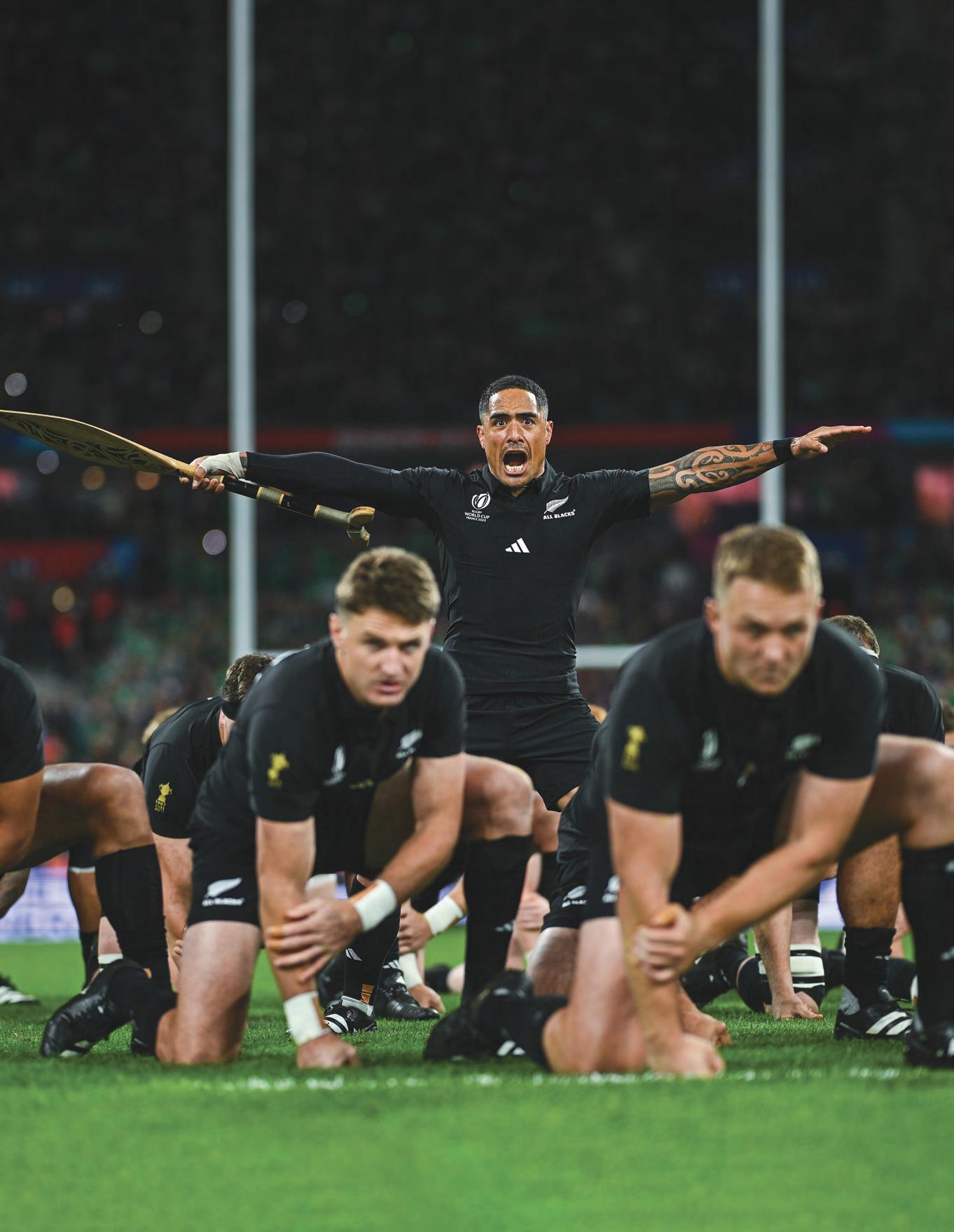




“Aaron Smith has won all of the big prizes. He was the most effective, game-changing, player in the world at that time. He drives a team. You see the quick pass, quicker than anyone else, further than anyone else, but what you don’t see is his effect on the team mentally. He has the courage to play but also knows when to settle down and just execute. He was a leader in the team.”
Smith reckons the diminutive halfback was also a better runner than he was given credit for, pointing to his 29 test tries, along with 35 tries in 185 games for the Highlanders.
“People were scared of his pass so focused on the backs, but he would pick the right time to run and had great vision.”
A classic example of picking the right time to run came in the last victory of Smith’s illustrious All Blacks career — the semifinal thrashing of Argentina at the 2023 World Cup. Immediately after the halftime break, and with New Zealand leading 20-6, Smith took a short pass from Ardie Savea at the back of a scrum on Argentina’s 22m, jinked inside Gonzalo Bertranou, dummied wing Mateo Carreras
Aaron Smith was more than just a passing halfback with a running game that saw him score 29 test tries.

out of his boots and crashed over in Santiago Carreras’ attempt.
As effective a runner and as accurate a kicker from the base of the ruck as he might have been, it was undoubtedly Smith’s bullet pass that had the biggest impact on the All Blacks. Like most finely honed crafts, it came to look like a natural extension of his being; that he was born with the capacity to fire a ball left or right at tremendous pace, distance and accuracy. It’s a nice vision, but a big lie.
In View From the Second Row, Sam Whitelock recalled ‘Nuggy’ Smith’s earliest days in the All Blacks: “He was the same as he was at Feilding High, an irrepressible personality, a big kid really, with a bullet pass that he worked on hour after hour after hour until it was as close to perfect as you could get… he worked on that pass relentlessly, obsessively.”
With Smith playing behind the breakdown, the All Blacks suddenly had an invaluable weapon.
“He changed the game because he allowed us to speed


up the game,” Steve Hansen says. “It suited us because we had really good athletes and forwards who could carry the ball. He was the key in unlocking that.”
Richie McCaw says Smith’s pass played an important role in how Dan Carter, Ma’a Nonu and Conrad Smith performed, because it offered them the luxury of time and space.
“He revolutionised our rugby by how quickly he could get to the breakdown and get the ball away. His other strength was how he directed the big boys around, particularly when we didn’t have the ball. He took a lot of pride in that.”
Smith went to Feilding High School, the same school as All Blacks teammates Codie Taylor and Whitelock.
“We’d been in the same group class from the age of 13,” Whitelock would write. “He was a day pupil but he liked to hang out where the action was, so he was always around the boarding hostel. He was exactly like he is now, except chunkier. He wasn’t ripped and running everywhere, but he had the same pass.
“We’re polar opposites in many respects but he’s like another brother. Dad loves the little bloke too, and will defend him to the hilt because he knows he hasn’t had anything handed to him.”
“HE REVOLUTIONISED OUR RUGBY BY HOW QUICKLY HE COULD GET TO THE BREAKDOWN AND GET THE BALL AWAY. HIS OTHER STRENGTH WAS HOW HE DIRECTED THE BIG BOYS AROUND, PARTICULARLY WHEN WE DIDN’T HAVE THE BALL. HE TOOK A LOT OF PRIDE IN THAT.”
Smith played 47 games for Manawatu, but like Whitelock and Taylor, his professional career took him south, though he went to Dunedin, not Christchurch.
Former All Blacks coach and good southern man, Laurie Mains, reckons Smith is the best halfback he has seen: “He’s got all the skills — passes brilliantly, passes quickly, communicates with his forwards well, takes gaps when it’s on,
knows when to run, when to pass, how to kick and where to kick. I don’t think I have seen a halfback that is more complete in his game than Aaron Smith.”
At 1.73m tall and weighing about 83kgs, Smith was never the fourth-looseforward style of halfback that Justin Marshall, Jimmy Cowan, Piri Weepu and Byron Kelleher offered the All Blacks, but he still packed a punch.
“He is tough,” Wayne Smith says. “I seldom saw him injured and yet he shirks nothing. He is small but he will have a crack at the biggest ball runner.”
Weber says he and others like him have Smith to thank for the resurgence of a small halfback.
“I WAS TOLD BY A FEW COACHES I WAS TOO SMALL TO PLAY PROFESSIONAL RUGBY, BUT NUG SHOWED THERE WAS STILL A PLACE FOR THE LITTLE GUYS.”
– BRAD WEBER
“Nug paved the way for guys like me,” says Weber, who is 1.75m tall, but was 20kgs lighter than Marshall at just 75kgs.
“The game was going in a direction where even the halfbacks were big guys. You look at Piri and before him Justin and Byron. I was told by a few coaches I was too small to play professional rugby, but Nug showed with his speed that there was still a place for the little guys.”
Marshall, the most capped All Blacks halfback with 81 tests until Smith went past him, says his impact on the game was helped by the five-second law which meant the ball needed to be shifted smartly from rucks and mauls.
“There was a period where the game was quite slow around the breakdown, where you had to be a lot more creative. You could do that with your own physicality or use steps to try and bring forwards into it to create and generate momentum, to generate fast ball when it was static.
“The five-second rule was perfect for Aaron Smith and the type of player that he was. To come in and have the speed of the clearance, the vision, the pace. The game needed someone like him to say, ‘This is how we’re going to speed the game up and this is how we’re going to do it.’ I don’t think anybody in the modern day has replicated what he brought to that jersey.”



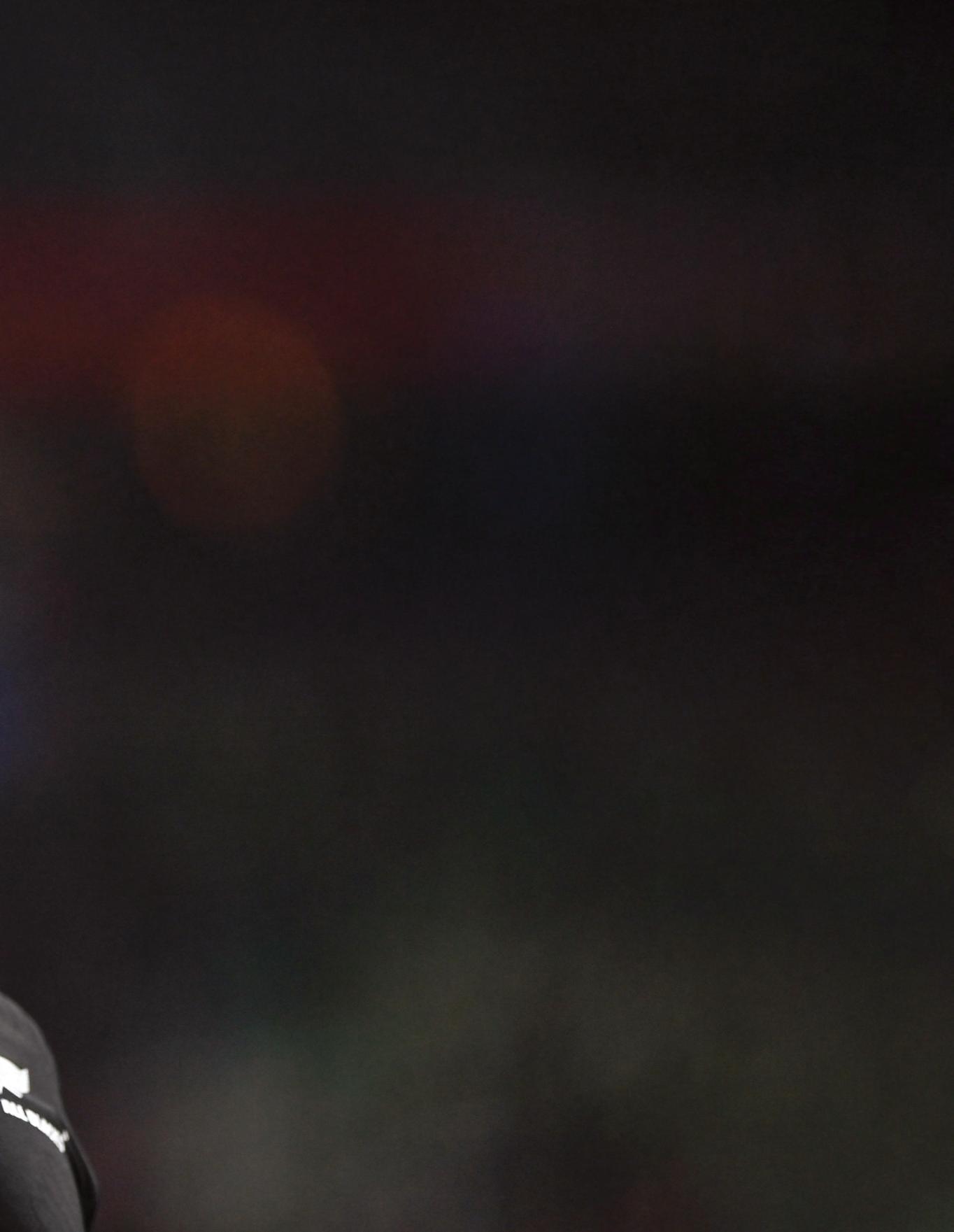
DANE COLES WAS A FEISTY COMPETITOR WHO LOVED A BIT OF NIGGLE BUT WAS ALSO A WONDERFUL RUNNER WHO HAD THE SKILLS AND PACE OF AN INSIDE BACK.
Dane Coles knows he was never destined for universal popularity. Some loved him, others detested him, few were neutral.
“I know I’m not everyone’s favourite but that’s fine by me. I’ve just tried to do everything I can on the field for every team I played for.”
Or, as Sam Whitelock says, “Coles one of my favourite blokes in the sport. An absolute pest to play against but a dream to play with”.
Coles played the twin roles of pest and dream teammate in 90 tests for the All Blacks, 141 times for the Hurricanes and in 71 games for Wellington. In almost every game his socks were down, his metaphorical sleeves were rolled up and his opponent’s patience was stretched to breaking point.
Sometimes, when it came to the latter, it snapped, like the time in 2023 when Crusaders rake Codie Taylor, Coles’ long-time teammate in the All Blacks, let the niggle get the better of him. In front of the referee, Taylor slapped the ball away after the Hurricanes were awarded a penalty then reacted to Coles’ triumphant chortles with a handbags exchange that saw him earn a yellow card.
“He’s been doing it all day,” was the plaintive lament from Taylor, one that has swirled up and down rugby’s sidelines since the game was invented.
Born 10 December 1986 in Paraparaumu, New Zealand
All Black 1117 All Blacks Test Debut Sunday, 11 November 2012 v Scotland at Edinburgh aged 25 years, 337 days Test Caps 90 Test Positions Hooker High School
Wellington College Club Poneke
He had, and it was deliberate. The pair laughed about it after the game, but in a demonstration of why there was method behind Coles’ madness, while Taylor had been letting off steam in the naughty chair, the Hurricanes had closed the gap on the Crusaders to 27-26 and would eventually go on to win.
If Coles has ruffled feathers, well that’s the bird’s problem, not his and anyway, he could point to a disciplinary record that was very good. Coles has been issued just two yellow cards in tests and two in Super Rugby – not bad for a known troublemaker.
“He grew up as a tough kid and he took that into his rugby,” Steve Hansen says. “He just needed to control it in his rugby. He did that pretty good,” he says with a chuckle before adding the rider, “by the end of his career”.
“He had moments when he wasn’t so well behaved, but you cut him a bit of slack because he was so good.”
Coles was like a playmaking second five-eighth playing at hooker. He had the pace, step and eye for the line of an inside back.

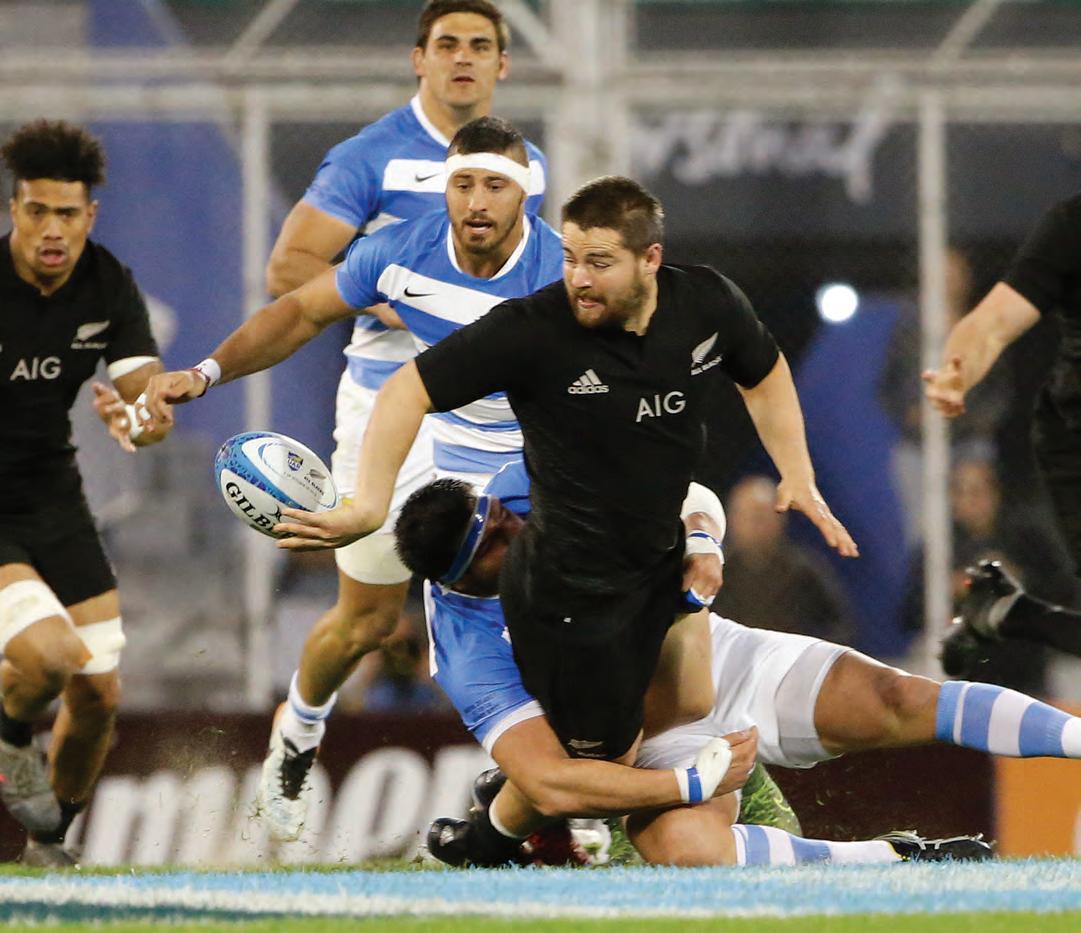

If Sean Fitzpatrick was the prototype seagulling hooker, then Coles took that template and added steroids to it. Fitzpatrick was comfortable finishing at the end of the chain, but Coles could operate as a link man just as effectively as he could a seagull. Perhaps the perfect example of this was his stunning, and often overlooked intervention, in the extraordinary 2013 test against Ireland in Dublin that preserved the All Blacks perfect year.
With time up on the clock and Ireland protecting a fivepoint lead in front of a baying Aviva Stadium crowd that had been waiting more than 100 years to taste victory against New Zealand, the All Blacks launched a multiphase attack that swept up the field and from side to side as it probed for signs of weakness in the home team’s defence. The penultimate set of hands on the ball was
that of replacement hooker Coles, who was playing in just his 15th test, 11 of which had been off the bench. Coles took Aaron Cruden’s flat pass on a big blind, stepped inside Ian Madigan, committing both him and covering flanker Sean O’Brien to the tackle, and then somehow wrestled his hands free to throw the try-scoring assist to Ryan Crotty.
It would have been breathtakingly audacious for a veteran hooker, let alone a sophomore still finding his feet, and hands, in the sport’s hottest cauldrons.
His audacity stretched to 23 test tries but Coles was no ornamental hooker, being sound in the scrum and, after some extras, accurate at the lineout.
“Shag [Hansen] and Mike Cron told me my throwing was poor and I needed to work on it and I knew they were 100

“IF SEAN FITZPATRICK WAS THE PROTOTYPE SEAGULLING HOOKER, THEN COLES TOOK THAT TEMPLATE AND ADDED STEROIDS TO IT.”
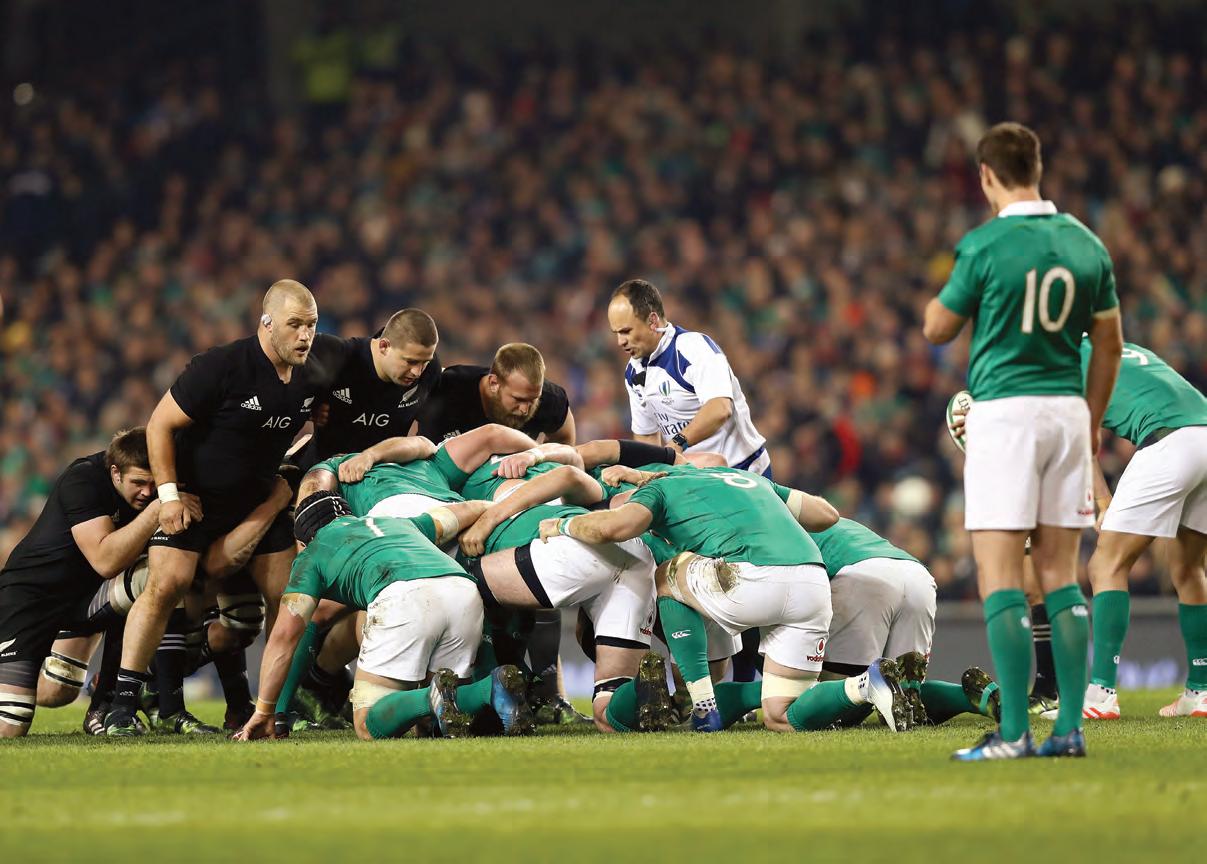
per cent right because as a young fella, throwing wasn’t my priority,” Coles told NZ Rugby World magazine. “I was more focused on making line breaks, but they taught me that scrum and lineout was my bread and butter and everything else would come from that. If you can’t throw, you can’t do your job as a hooker.”
Hansen first saw Coles play for New Zealand Under-21 against South Africa in 2007 and while he was impressed, he wasn’t sure the rough diamond could be polished.
“He was so unrefined I just couldn’t see how he would fit into a rugby team. I couldn’t see him doing it but he did and all that skill and energy he had started to go into the right places.”
By the time he retired from international rugby after the 2023 World Cup in France (somewhat controversially, he was not included in the 23 for the final), Coles was
one of the most respected figures within the All Blacks leadership group thanks in large part to the influence Keven Mealamu and Andrew Hore had on him when he started.
“They taught him what being an All Black was, what it meant, and he grabbed hold of that with both hands,” Hansen says. “He became a leader and was such a strong ally to whoever the captain was because he wouldn’t put up with any crap within the team.”
Coles, in turn, passed on that legacy to Samisoni Taukei’aho.
“He developed me as a player, not just a rugby player, but as a human being. He’s a top man,” Taukei’aho, who calls Coles “Granddad”, said. “He gave me advice and made a few smart comments about my throwing when I first got in. When I went and asked for help, he was really open,
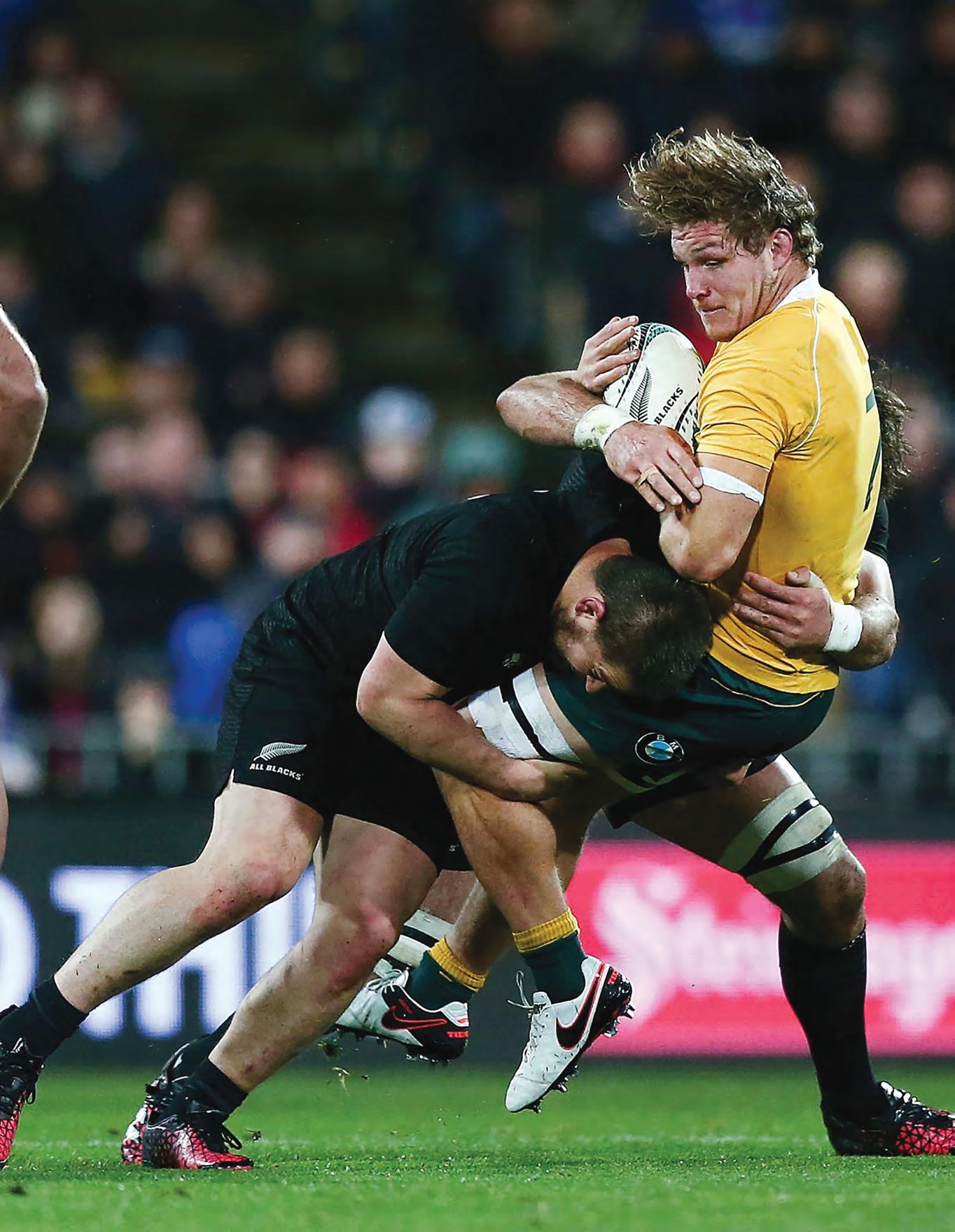


Coles was a keen part of the All Blacks 2015 World Cup winning team, seen here with Nehe Milner-Skudder, Ben Smith, Tawera Kerr-Barlow and Colin Slade.
let me know what I needed to do and helped me out. He changed me, changed the player I am, and also the way I look at the game.”
As much as stories about Coles tend to focus on his outgoing personality, he was one heck of a rugby player who was one of the five hookers shortlisted for the Greatest All Blacks XV picked in 2021. He was nominated for New Zealand and World Player of the Year in 2016 but lost out both times to Beauden Barrett, but Coles, of Ngāti Porou, was named Māori Player of the Year. He would’ve played 100 tests if not for a series of concussions impacting his availability, and a knee injury wiping out a fair bit of 2018.
When he played, Coles was never restricted by the number on his back.
“He would play like a back when given the opportunity,” Hansen says. “His core roles were world class and then he added other things to his game. One was his ability as an athlete, to play with the ball and attack like a back.
“Then you add that tendency to upset other people. He was just at you all the time. He was a massive influence on the game and now if you look at other hookers, everyone is looking for those who can carry the ball and defend well.”
Mealamu played 133 tests at hooker but has no issue admitting that there were parts of Coles’ game he wished he could replicate.
“He revolutionised the position. It was his turn of pace and beautiful lines. The way he would run his lines was something I would look at and want to copy.”
Being a hooker, Mealamu also had a soft spot for the havoc Coles’ famous niggle would cause among the opposition.
“I loved that because that is him — he’s competitive but also a humble guy.”

THE THREE SIRS WERE THE THREE MOST INFLUENTIAL COACHES OF THE PROFESSIONAL ERA, EACH HAVING A SIGNIFICANT IMPACT ON THE GAME.


SIR GRAHAM HENRY’S GREATEST TRIUMPH WAS ALSO HIS NARROWEST.
“WE SMASHED THE FRENCH IN THE FINAL BY A POINT”

Sir Graham Henry’s greatest triumph was also his narrowest. “We smashed the French in the final by a point,” is a line he likes to use to describe the 8-7 win in the 2011 World Cup final. It was a test that was so tense Henry’s wife, Raewyn, spent much of the match pacing the concourse at Eden Park, unable to watch.
The All Blacks holding on for a win that broke a 24-year drought immortalised Henry as a coach and ensured Steve Hansen would be appointed as his successor. It was a nearrun thing: not only that match, but the very fact he was still in charge after guiding the All Blacks to a quarter-final loss against the same team four years earlier. His reappointment ahead of Crusaders guru and former All Blacks assistant coach Robbie Deans was not universally popular, but it proved a wise decision.
Henry had coached the All Blacks to a clean sweep of the Lions in 2005 and a Grand Slam later that year. Aside from 2007 and 2009, he was, in the main, a hugely successful coach. Henry’s long tenure saw an overhaul of the All Blacks professionalism on and, just as importantly, off the field. The former Auckland secondary school principal recognised the damage rugby’s endemic drinking culture was having on athletes’ performances and, in some cases, the sport’s reputation.
While he could be acerbic and could come across as a bit of a grump, Henry had a progressive streak that was admirable. He was the first coach to pick a player of Pacific Island heritage as his test captain when he elevated Tana Umaga to the role. Henry also showed he wasn’t afraid to be challenged when he appointed strong and successful coaches, Hansen and Wayne Smith, as his assistants.
Henry’s All Blacks were a consistently dominant force in world rugby during his tenure. That consistency of performance is reflected in him being named World Rugby’s Coach of the Year five times.
Coached 103 matches Won 88 Lost 15 Winning Percentage 85%

Sir Wayne Smith makes this list not because of his efforts as head coach, but because of his enormous contribution as assistant, first with Graham Henry and then Steve Hansen. Much of what those men achieved can be slated back to Smith’s work behind the scenes, away from the limelight.
By his own admission, Smith did not cope well with the pressure of being head coach and was determined when he joined Henry in 2004 to stay under the radar. His effect on the team, though, couldn’t be hidden. He was variously dubbed the Guru, the Professor and Mr Rugby by players, coaches and the media, but there was a uniformity in assessing his ability as a coach he was outstanding.
Smith brought a connection with the past to the All Blacks as he was a very good player in his own right, and his humility and team-first ethos wasn’t lost on those he worked alongside. Smith pulled from a deep well of intelligence, both emotionally and in his X’s and O’s teaching. An astute tactician, Smith was also open to understanding the different ways people take in information.
“HE WAS VARIOUSLY DUBBED THE GURU, THE PROFESSOR AND MR RUGBY BY PLAYERS, COACHES AND THE MEDIA.”
Smith was an All Black from 1980 to 1985, an assistant to John Hart in 1999, head coach across 2000-01, assistant to Henry from 2004 to 2011, and again for Hansen when they won the World Cup in 2015 through to the Lions series in 2017.
His 20-year association with the All Blacks included 17 tests as a player and 212 games as a coach. Cruelly, his last game was a narrow loss to Australia to finish the 2017 Rugby Championship.

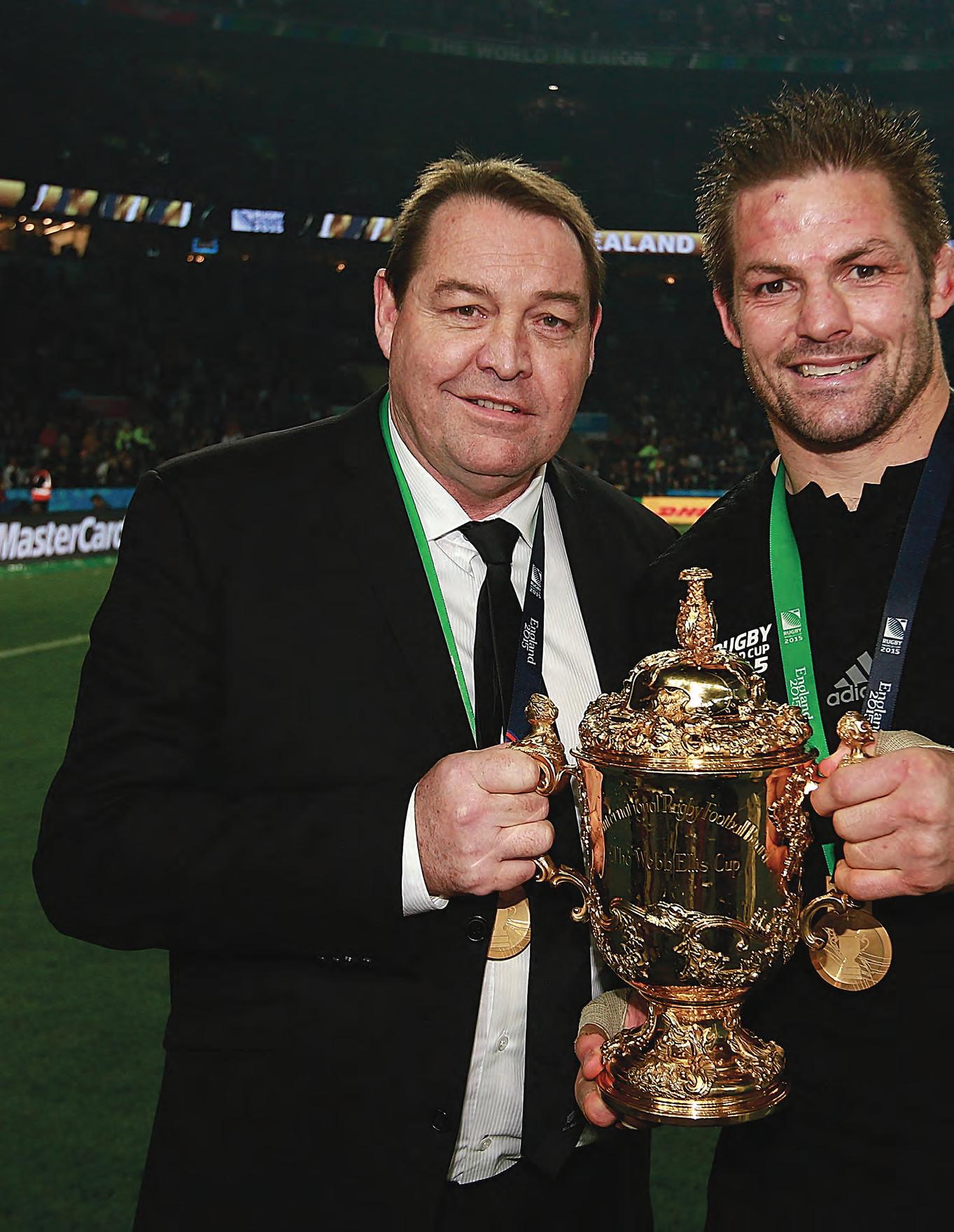
“HE REJUVENATED THE TEAM, SHOWED HE WAS AN EXCELLENT MAN MANAGER AND OVERSAW A SUSTAINED PERIOD OF SUCCESS, WITH AN EXCELLENT 87 PERCENT WIN RATE.”

Sir Steve Hansen’s 15-year tenure with the All Blacks included winning the 2011 World Cup as an assistant to Sir Graham Henry before backing that up as head coach when the All Blacks became the first team to win consecutive titles. When the All Blacks won the World Cup in England in 2015, it was the first time they had triumphed outside New Zealand.
Hansen was also coach when the All Blacks lost the semifinal to England in Tokyo in 2019. He got key selections wrong for the game, but that is just one black mark on an otherwise stellar tenure.
Hansen’s 2015 World Cup-winning team was replete with some of the world’s best players, but he coped well in 2016 when he had lost six superstars of the game in Richie McCaw, Dan Carter, Ma’a Nonu, Conrad Smith, Tony Woodcock and Keven Mealamu. The All Blacks lost just one of their 14 tests that year, the historic defeat to Ireland in Chicago.
The failure to beat the Lions in 2017 will remain a stone in Hansen’s shoe, but most objective observers believe they were the victims of a dreadful officiating error late in the third test at Eden Park, which contributed to the match and series being drawn.
Having been Henry’s assistant for eight years, Hansen might have suffered from staleness when he took over, but it didn’t happen. He rejuvenated the team, showed he was an excellent man manager and oversaw a sustained period of success, with an excellent 87 per cent win rate.
The Cantabrian was World Rugby Coach of the Year four times.
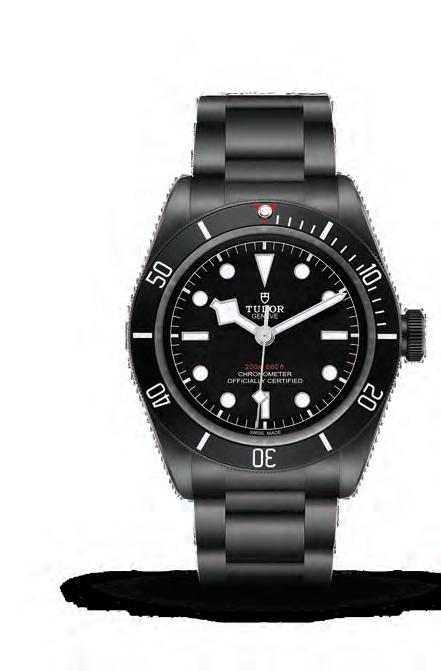
SINCE 2017, NEW ZEALAND’S LEGENDARY ALL BLACKS RUGBY TEAM AND THEIR PLAYMAKER, BEAUDEN BARRETT, HAVE BEEN AMBASSADORS FOR SWISS WATCH BRAND, TUDOR AND ITS BORN TO DARE SIGNATURE.
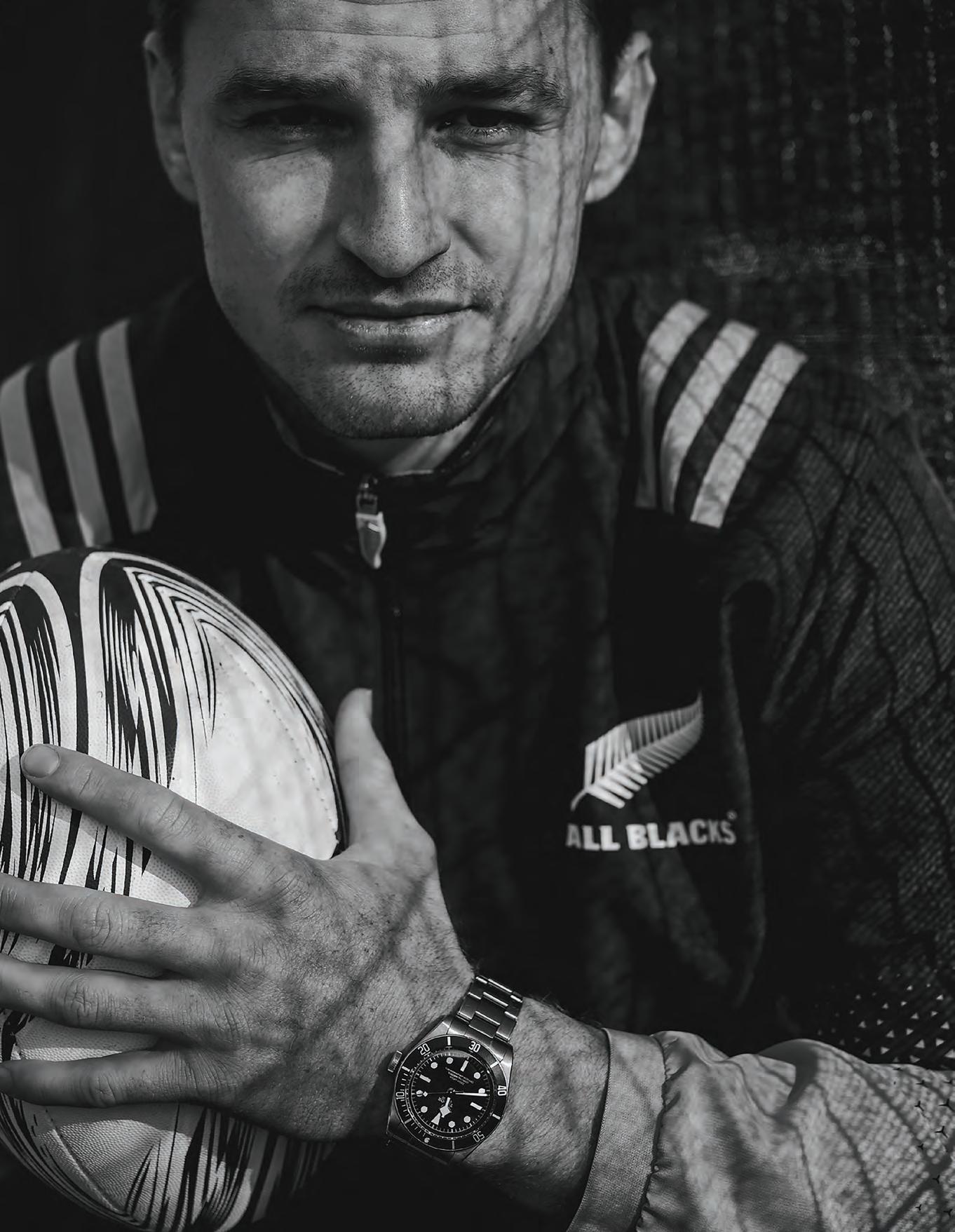
Rugby is a powerful, uncompromising sport; a sport for the bold and a true reflection of the spirit that has driven the TUDOR watchmaking brand since its inception.
Since 1884, New Zealand’s national rugby team has enjoyed a win rate of over 75 per cent, making it one of the most successful teams of all time in any sport.
TUDOR’s Born To Dare signature reflects the history of the All Blacks brand and what it stands for today. It tells the adventures of daring individuals who have achieved the extraordinary on land, ice, in the air and underwater, keeping time with a TUDOR watch.
TUDOR is the product of the revolutionary vision of its founder, Hans Wilsdorf, who since the mid-1920s, sought to manufacture quality watches able to withstand the most extreme conditions.
The Born To Dare spirit is supported globally by ambassadors whose life achievements are the product of a fearless approach to life. Beauden Barrett and the All Blacks have joined the ranks of the extraordinary personalities bringing the TUDOR message to new audiences.
After the Rugby World Cup Finals in France in 2023 and a season in Japan, Beauden Barrett has returned to New Zealand. Known for his electrifying style, speed and laser focus, Barrett –who holds the world record for consecutive wins since his first test (19 wins from 19 tests) and was awarded World Rugby Player of the Year in 2016 and 2017 – exemplifies the very essence of the All Blacks and embodies the TUDOR ethos: “For those who are up for anything. For those who face their fears. For those who reinvent themselves every day… a TUDOR is born to dare.”

“THE BORN TO DARE SPIRIT IS SUPPORTED
A TUDOR watch is built “for those who dare to step out of their comfort zone”. It is designed to perform in all and every condition – from a refined evening out to the most extreme environments in every field of play.
www.tudorwatch.com
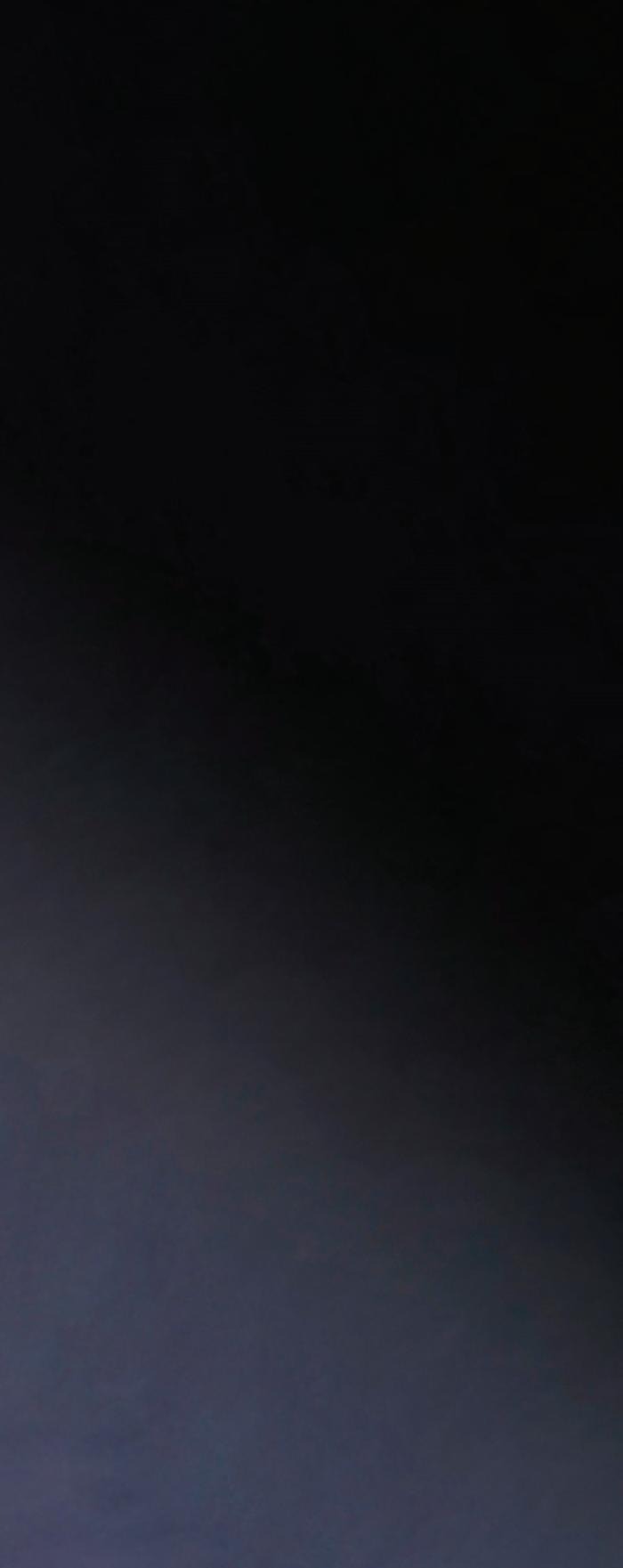
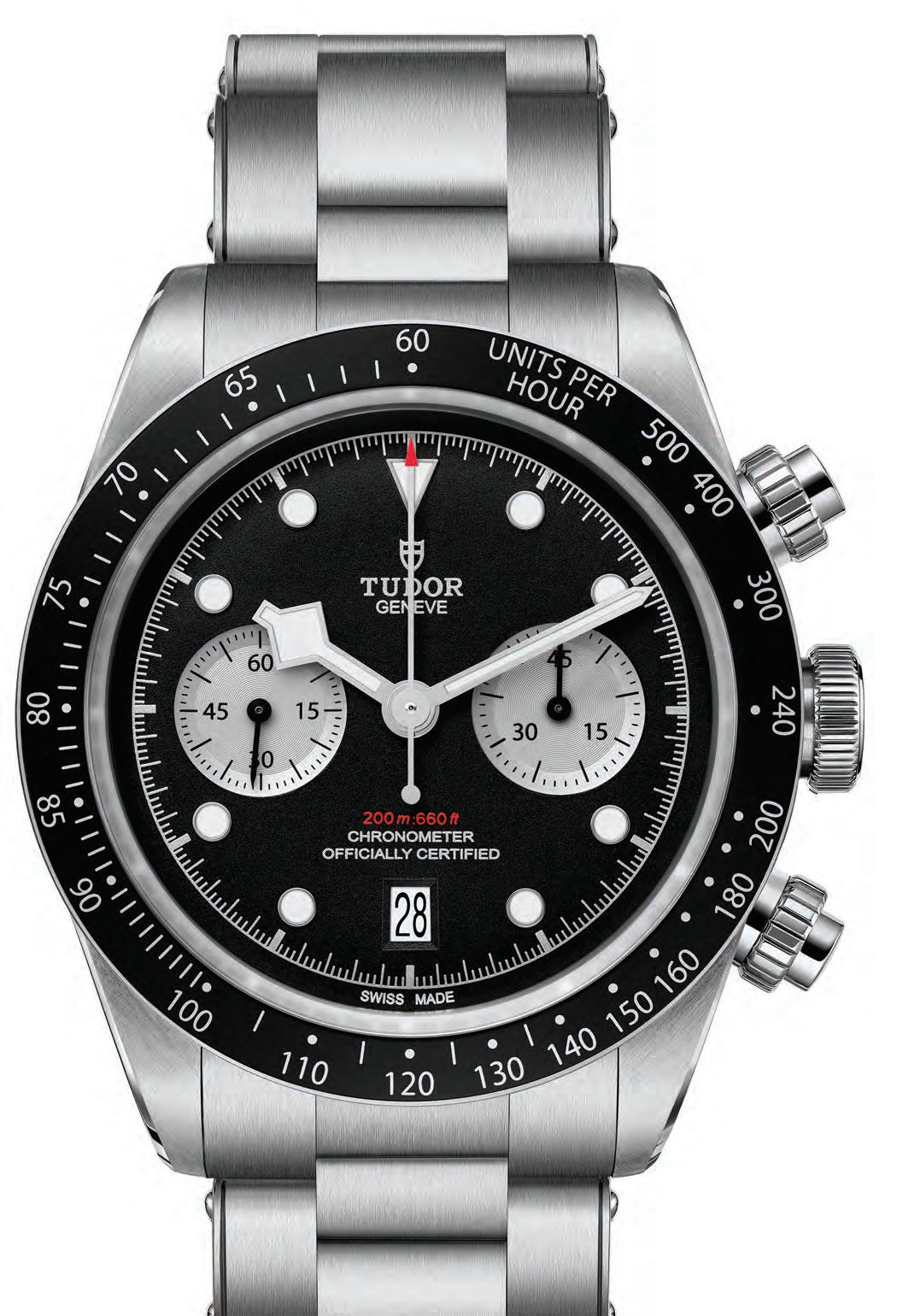
A vintage-inspired sport chronograph with a self-winding mechanical movement, waterproof to 200m in a sleek 41mm stainless steel case.
